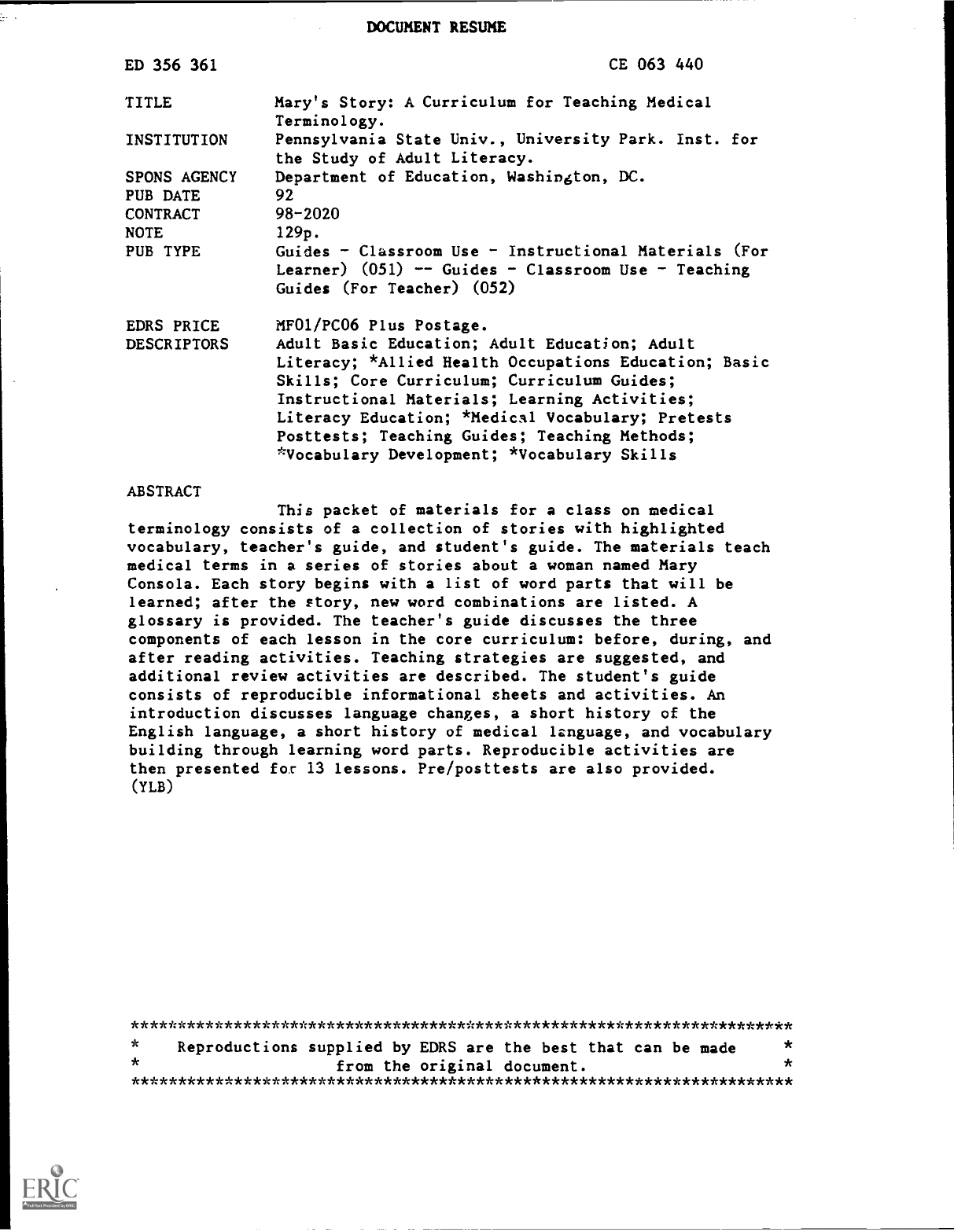
DOCUMENT RESUME
ED 356 361
CE 063 440
TITLE
Mary's Story: A Curriculum for Teaching Medical
Terminology.
INSTITUTION
Pennsylvania State Univ., University Park. Inst. for
the Study of Adult Literacy.
SPONS AGENCY
Department of Education, Washington, DC.
PUB DATE
92
CONTRACT 98-2020
NOTE 129p.
PUB TYPE Guides Classroom Use
Instructional Materials (For
Learner) (051) -- Guides Classroom Use
Teaching
Guides (For Teacher) (052)
EDRS PRICE MF01/PC06 Plus Postage.
DESCRIPTORS Adult Basic Education; Adult Education; Adult
Literacy; *Allied Health Occupations Education; Basic
Skills; Core Curriculum; Curriculum Guides;
Instructional Materials; Learning Activities;
Literacy Education; *Medical Vocabulary; Pretests
Posttests; Teaching Guides; Teaching Methods;
*Vocabulary Development; *Vocabulary Skills
ABSTRACT
This packet of materials for a class on medical
terminology consists of a collection of stories with highlighted
vocabulary, teacher's guide, and student's guide. The materials teach
medical terms in a series of stories about a woman named Mary
Consola. Each story begins with a list of word parts that will be
learned; after the story, new word combinations are listed. A
glossary is provided. The teacher's guide discusses the three
components of each lesson in the core curriculum: before, during, and
after reading activities. Teaching strategies are suggested, and
additional review activities are described. The student's guide
consists of reproducible informational sheets and activities. An
introduction discusses language changes, a short history of the
English language, a short history of medical language, and vocabulary
building through learning word parts. Reproducible activities are
then presented for 13 lessons. Pre/posttests are also provided.
(YLB)
***********************************************************************
Reproductions supplied by EDRS are the best that can be made
from the original document.
***********************************************************************
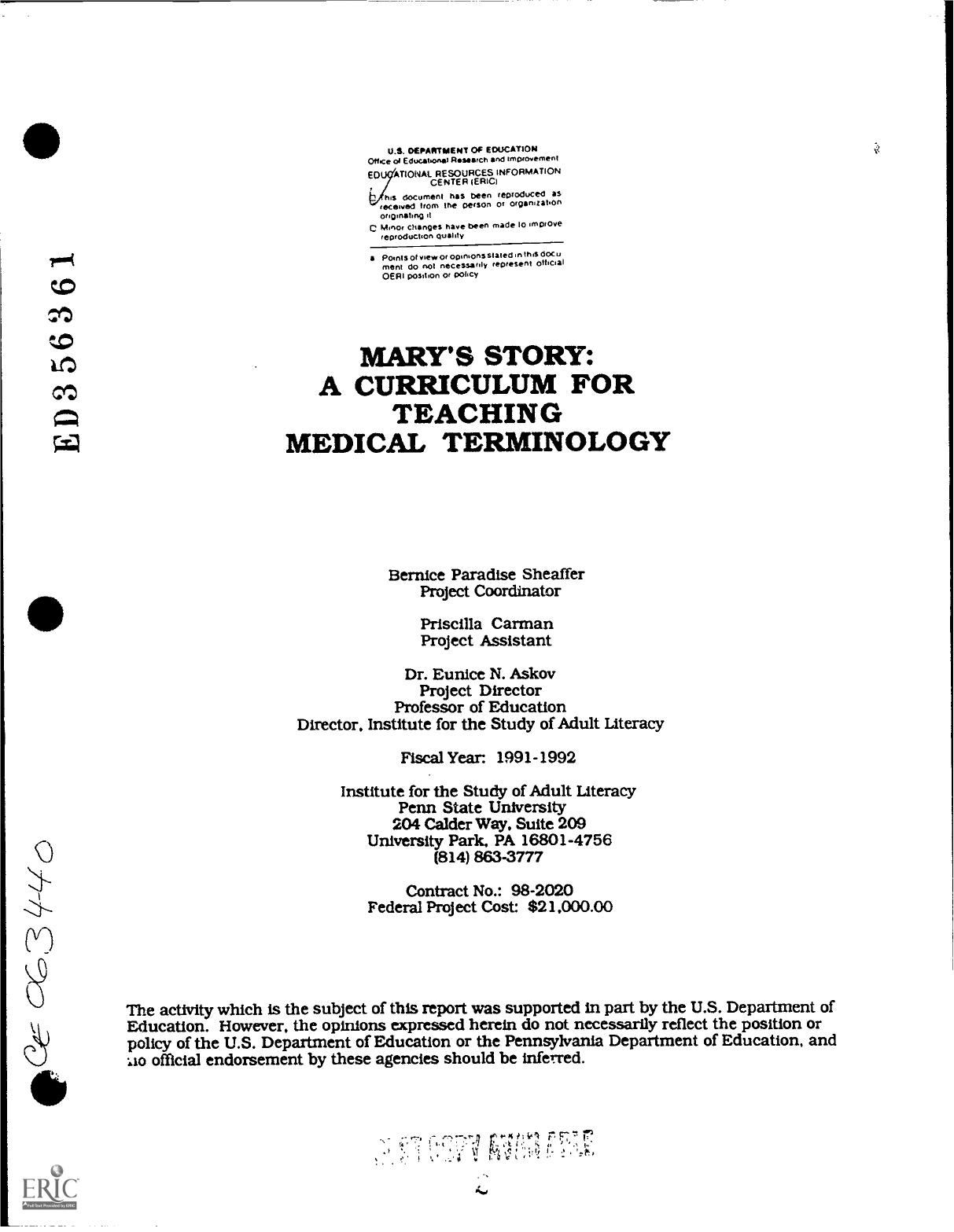
lD
U.S. DEPARTMENT OF EDUCATION
One of Educationsi Research and improvement
ED
c
'RONAL RESOURCES INFORMATION
CENTER IERICI
his document has been reproduced as
received Porn the person or oroanaatton
ortginattng
C Minor changes have been made to improve
reproduction quality
Points ot new or opintons stated tn this docu
went do not necessartiy represent ottictal
OERI position or pohcr
MARY'S STORY:
A CURRICULUM FOR
TEACHING
MEDICAL TERMINOLOGY
Bernice Paradise Sheaffer
Project Coordinator
Priscilla Carman
Project Assistant
Dr. Eunice N. Askov
Project Director
Professor of Education
Director, Institute for the Study of Adult Literacy
Fiscal Year. 1991-1992
Institute for the Study of Adult Literacy
Penn State University
204 Calder Way. Suite 209
University Park. PA 16801-4756
(814) 863-3777
Contract No.: 98-2020
Federal Project Cost: $21.000.00
The activity which is the subject of this report was supported in part by the U.S. Department of
Education. However, the opinions expressed herein do not necessarily reflect the position or
policy of the U.S. Department of Education or the Pennsylvania Department of Education, and
official endorsement by these agencies should be infeexed.

Table of Contents
Introduction
1
Mary Moves In 2
Meeting a New Neighbor
3
An Emergency
9
Mary Learns New Word Parts
13
Mary Reviews What She Has Learned
19
Mary Starts School 22
More Familiar Word Parts
27
Places and Directions
32
Mary Begins to Learn Body Parts (Nervous System)
41
Mary Reviews Again
49
Mary Knows More Body Parts
52
Mike Hurts His Neck 59
Mary Moves
66
Conclusion
75
Glossary
76
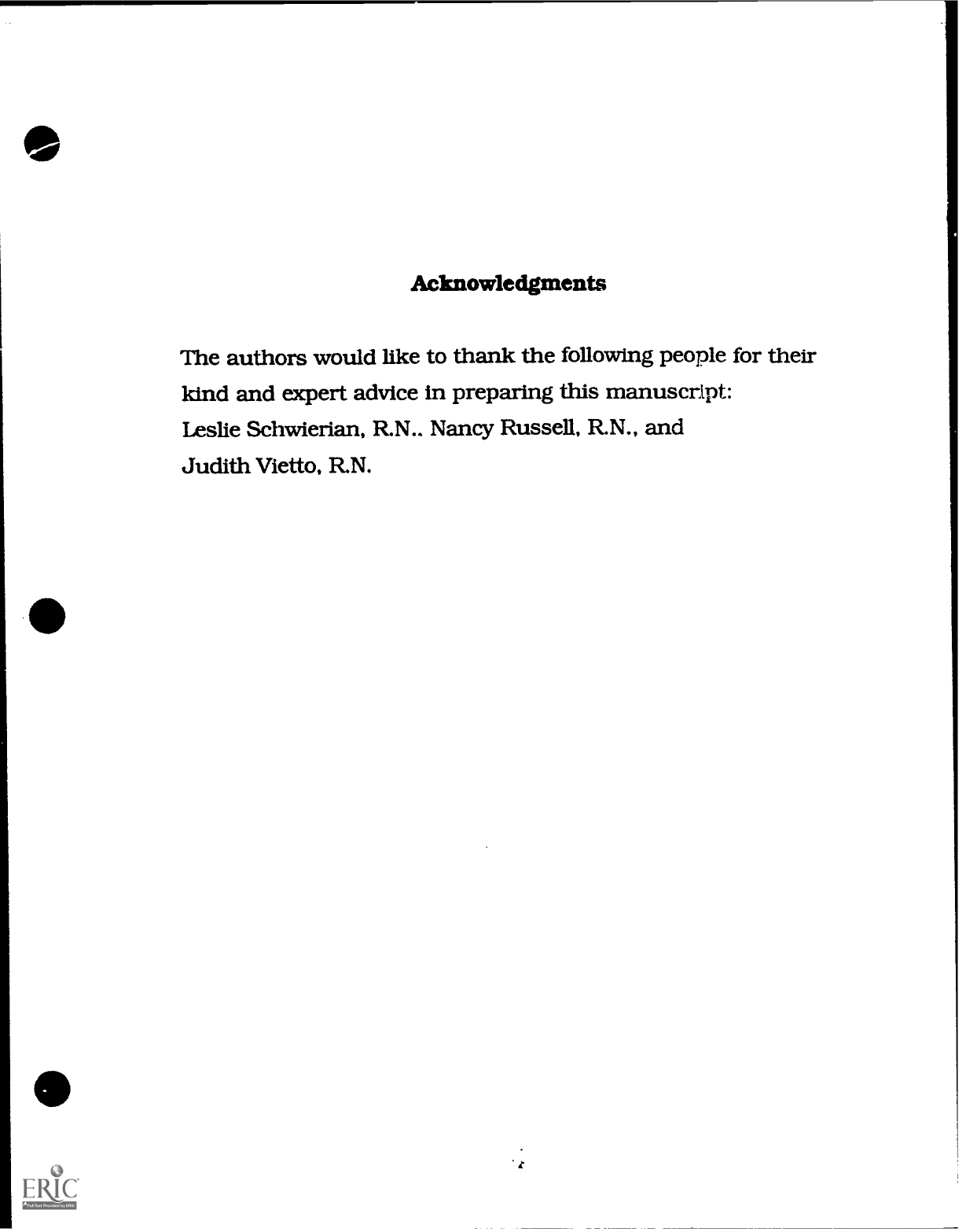
e
Acknowledgments
The authors would like to thank the following people for their
kind and expert advice in preparing this manuscript:
Leslie Schwierian,
Nancy Russell, RN., and
Judith Vietto, RN.
S

1
Introduction
4F:
This class will help you learn to use medical terms. The
terms will all be used in stories about a woman named Mary
Consola. Mary's husband, Mike, had been out of work for a
long time. It was very hard for Mary, Mike, and their son Billy
to make ends meet.
But Mike found a job and he, Mary, and Billy had to move
to a new town. Mary's mother lived with them. You will follow
Mary to her new apartment, through school, and into a new
job. Along the way you will meet new people, especially
Thelma, Mary's new neighbor.
We hope you enjoy Mary's stories and hope they help
you learn your medical terms.
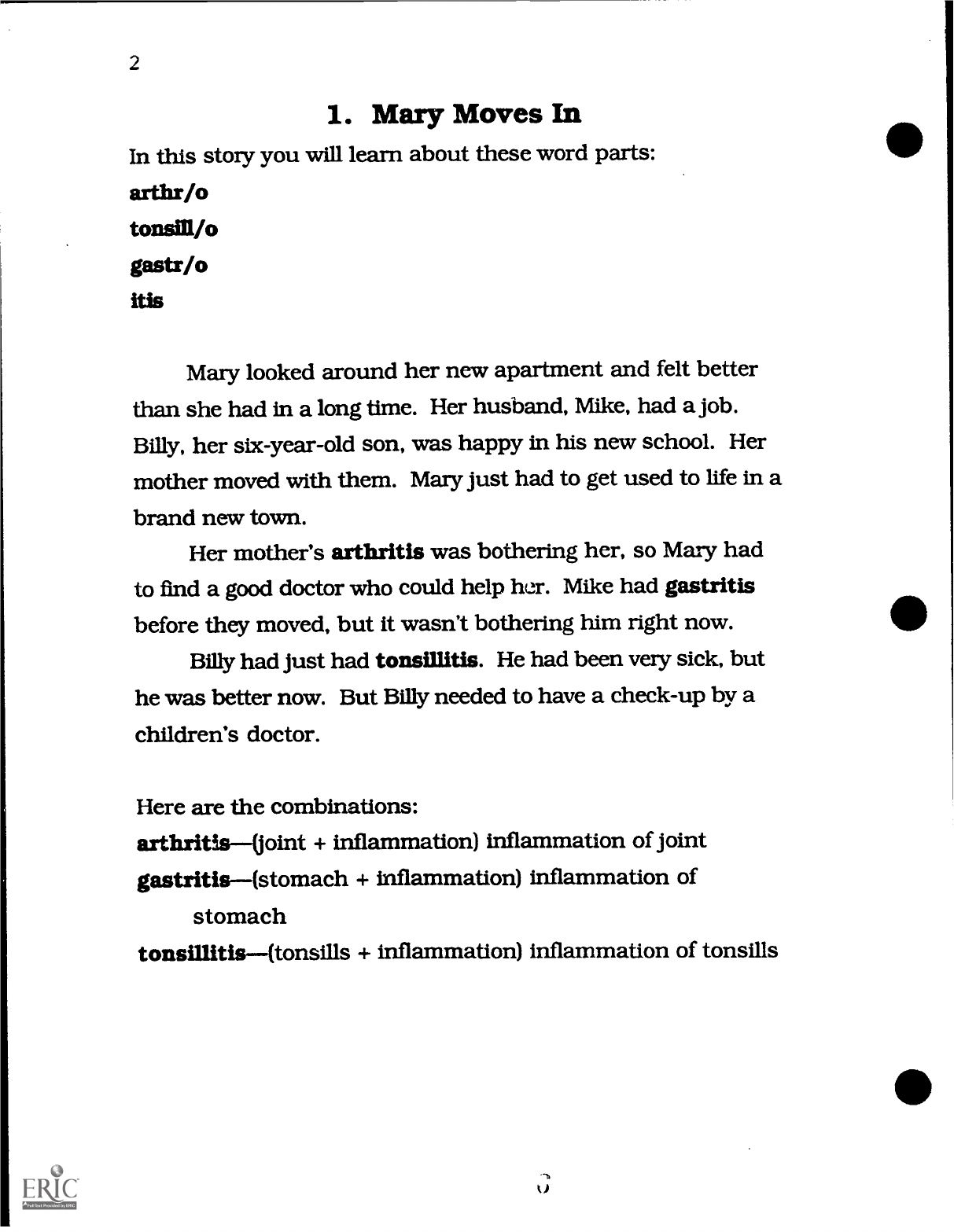
2
1. Mary Moves In
In this story you will learn about these word parts:
arthr/o
tonsill/o
gastr/o
itis
Mary looked around her new apartment and felt better
than she had in a long time. Her husband, Mike, had a job.
Billy, her six-year-old son, was happy in his new school. Her
mother moved with them. Mary just had to get used to life in a
brand new town.
Her mother's arthritis was bothering her, so Mary had
to find a good doctor who could help her. Mike had gastritis
before they moved, but it wasn't bothering him right now.
Billy had just had tonsillitis. He had been very sick, but
he was better now. But Billy needed to have a check-up by a
children's doctor.
Here are the combinations:
arthritis--(joint + inflammation) inflammation of joint
gastritis(stomach + inflammation) inflammation of
stomach
tonsillitis--(tonsills + inflammation) inflammation of tonsills
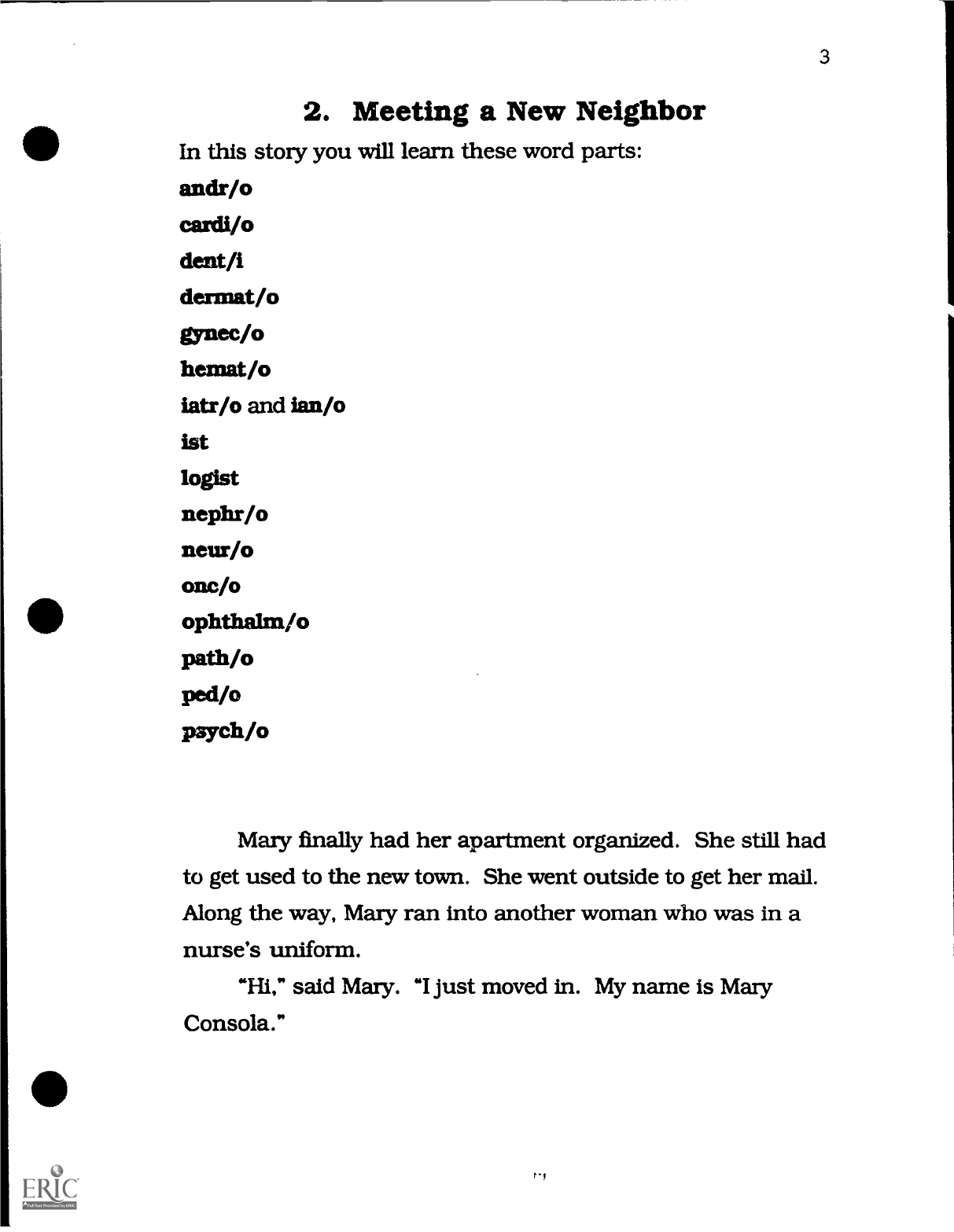
3
2. Meeting a New Neighbor
In this story you will learn these word parts:
andr/o
cardi/o
dent/i
dermat/o
gynec/o
hemat /o
iatr /o and ian/o
ist
logist
nephr/o
neur/o
onc/o
ophthalmic)
path/o
ped/o
paych/o
Mary finally had her apartment organized. She still had
to get used to the new town. She went outside to get her mail.
Along the way, Mary ran into another woman who was in a
nurse's uniform.
"Hi," said Mary. just moved in. My name is Mary
Consola."

4
*Hi," the woman answered. "I'm Thelma Jones. I
live in
the apartment right next to you. Welcome."
"Are you a nurse?" asked Mary.
Thelma smiled. "Yes, I'm an LPN. I just started about
three months ago. The training was hard work, but worth it.
I
love my job."
Mary had a great idea. "Maybe you can help
I need to
find new doctors. You probably know all the
doctors in this
town."
"What kind of doctor do you need?" Thelma asked.
"I'm not sure. I don't know the medical titles
the doctors
use," Mary replied.
"Well, let's get the telephone book and look in the Yellow
Pages. I'll help you."
They looked in the Yellow Pages under physicians.
Mary frowned. "See, what I mean. These words are so
long. I have no idea what they mean. Look at this
cardiologist. What's that?"
Thelma answered, "It is really easier than it looks. Mcst
medical words are made of word parts. If you know what the
word parts mean, you can figure out what the words mean.
Look at the wcird parts in cardiologist. Cardi/o means
something to do with the heart. Logist really means one who
studies or an expert. So a cardiologist is a heart experta
doctor for the heart. Let's look at the other specialties."
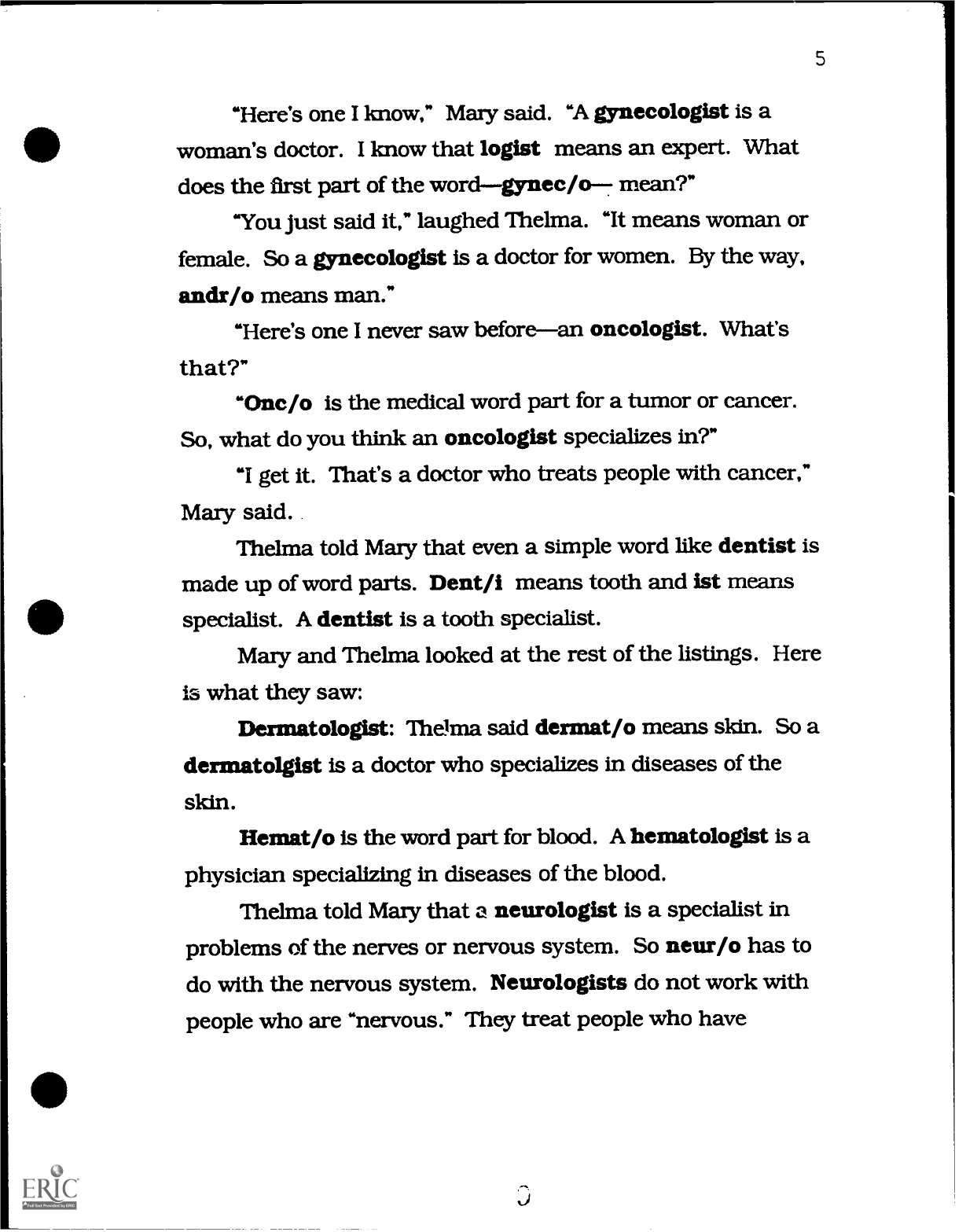
5
"Here's one I know," Mary said. "A gynecologist is a
woman's doctor. I know that logist means an expert. What
does the first part of the wordgynec/o-- mean?"
"You just said it," laughed Thelma. "It means woman or
female. So a gynecologist is a doctor for women. By the way,
andr/o means man."
"Here's one I never saw beforean oncologist. What's
that?"
"Onc/o is the medical word part for a tumor or cancer.
So, what do you think an oncologist specializes in?"
"I get it. That's a doctor who treats people with cancer,"
Mary said.
Thelma told Mary that even a simple word like dentist is
made up of word parts. Dent/i means tooth and ist means
specialist. A dentist is a tooth specialist.
Mary and Thelma looked at the rest of the listings. Here
is what they saw:
Dermatologist: Thehna said dermat/o means skin. So a
dermatolgist is a doctor who specializes in diseases of the
skin.
Hemat/o is the word part for blood. A hematologist is a
physician specializing in diseases of the blood.
Thelma told Mary that a neurologist is a specialist in
problems of the nerves or nervous system. So neur/o has to
do with the nervous system. Neurologists do not work with
people who are "nervous." They treat people who have

6
something wrong with their nervous systemincluding
the
brain, the spinal cord and the nerves.
A psychologist is a mind specialist. Psych/o is the word
part for mind.
The word part path/o means disease. A pathologist is a
specialist who studies diseases in the body.
Mary and Thelma found a doctor who was a
nephrologist. Thelma said that the word part nephr/o has to
do with the kidneys. So a nephrologist is a kidney
specialist.
If Mary needed an eye exam, Thelma said she could go to
an ophthalmologist. The
word part ophthalm /o means eyes.
"Here's one that's different," said Mary. "I know what
kind of doctor this is, though. It is a pediatriciana children's
doctor. I take Billy to a pediatrician. But that doesn't have
ologist in it."
"No, it doesn't, Mary," Thelma said. miatr/o means a
physician. Ped/o refers to children. So you are right. A
pediatrician is a doctor for children."
Just then Billy came home from school. Thelma said, "Is
it time for the kids to be home from school already? My son,
Gregg, is probably wondering where I am. I have to go."
"Goodbye, Thelma. Thanks for being so helpful. I hope I
see you again."
"Don't worry, you will." laughed Thelma as she went out
the door.

7
New word combinations:
androgynous(man + woman) without sexual characteristics
of a man or a woman
andropathy(man + disease) any disease that only men have
cardiologIst(heart + specialist) a physician specializing in
the heart
cardionephric(heart + kidney) having to do with the heart
and the kidney
cardioneural(heart + nerves) having to do with the nervous
control of the heart
cardiopathy(heart + disease) disease of the heart
carditis(heart + inflammation) inflammation of the heart
dentist(teeth + specialist) a specialist in the treatment of the
teeth
dermatitis(skin + inflammation) skin inflammation
dermopathy(skin + disease) disease of the skin
gastrocardiac(stomach + heart) having to do with stomach
and heart
gastrologist (stomach + specialist) expert in the study of the
stomach
gastropathy(stomach + disease) disease of the stomach
gynecopathy(woman + disease) diseases peculiar to the
female reproductive system
nephritis(kidney + inflammation) inflammation of the
kidney
neuritis(nerves + inflammation) inflammation of a nerve or
nerves

8
neurocardiac(nerves + heart) having to do with the nerves
supplying the heart
neurogastric(nerves + stomach) having to do with the
nerves of the stomach
neurologist(nerves + specialist) a physician who
specializes
in diseases of the nervous system
neuroophthalmology(nerves + eyes + the study of) the
study of the nerves of the eyes
neuropathy(nerves + disease) diseases of the nervous
system
neuropsychopathy(nerves + the mind + disease) disease
of
the nerves combined with a mental
disorder
oncologist(cancer or tumor + specialist) a physician who
specializes in treatment of tumors or cancer
ophthalmitis(eye + inflammation) inflammation of the eye
ophthalmoneuritis(eye + nerve + inflammation)
inflammation of the optic nerve (the nerve to the eye)
psychiatrist(mind + physician) a physician who specializes
in mental disorders
psychopathology(mind + disease + study of) die study of
diseases of the mind
tonsillopathy(tonsils + disease) diseased tonsils
1 "s)
ti
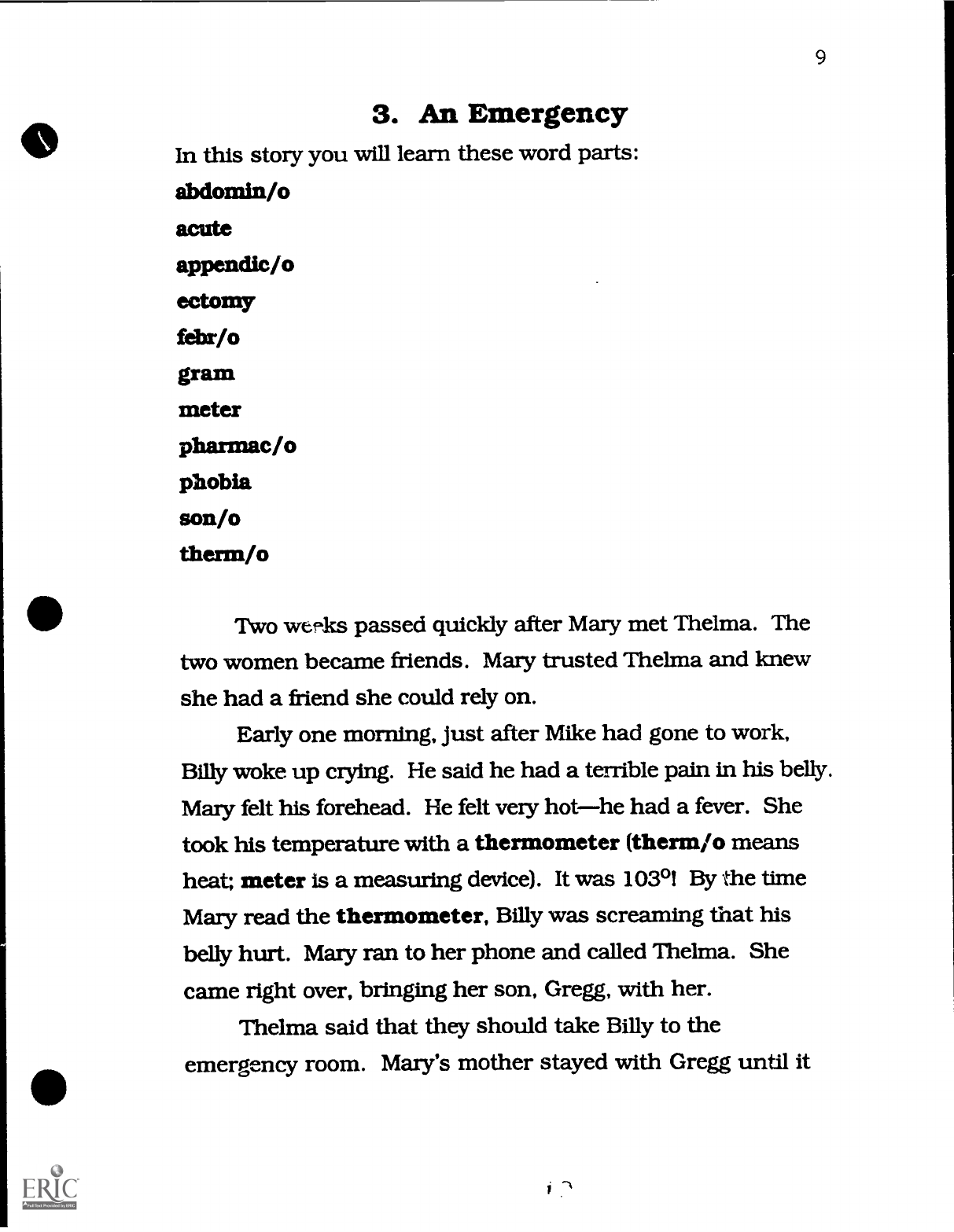
e
9
3. An Emergency
In this story you will learn these word parts:
abdomin/o
acute
appendicio
ectomy
febr/o
gram
meter
pharmac/o
phobia
son/o
therm/o
Two weeks passed quickly after Mary met Thelma. The
two women became friends. Mary trusted Thelma and knew
she had a friend she could rely on.
Early one morning, just after Mike had gone to work,
Billy woke up crying. He said he had a terrible pain in his belly.
Mary felt his forehead. He felt very hothe had a fever. She
took his temperature with a thermometer (thermic) means
heat; meter is a measuring device). It was 103°1 By the time
Mary read the thermometer, Billy was screaming that his
belly hurt. Mary ran to her phone and called Thelma. She
came right over, bringing her son,
Gregg, with her.
Thelma said that they should take Billy to the
emergency room. Mary's mother stayed with Gregg
until it
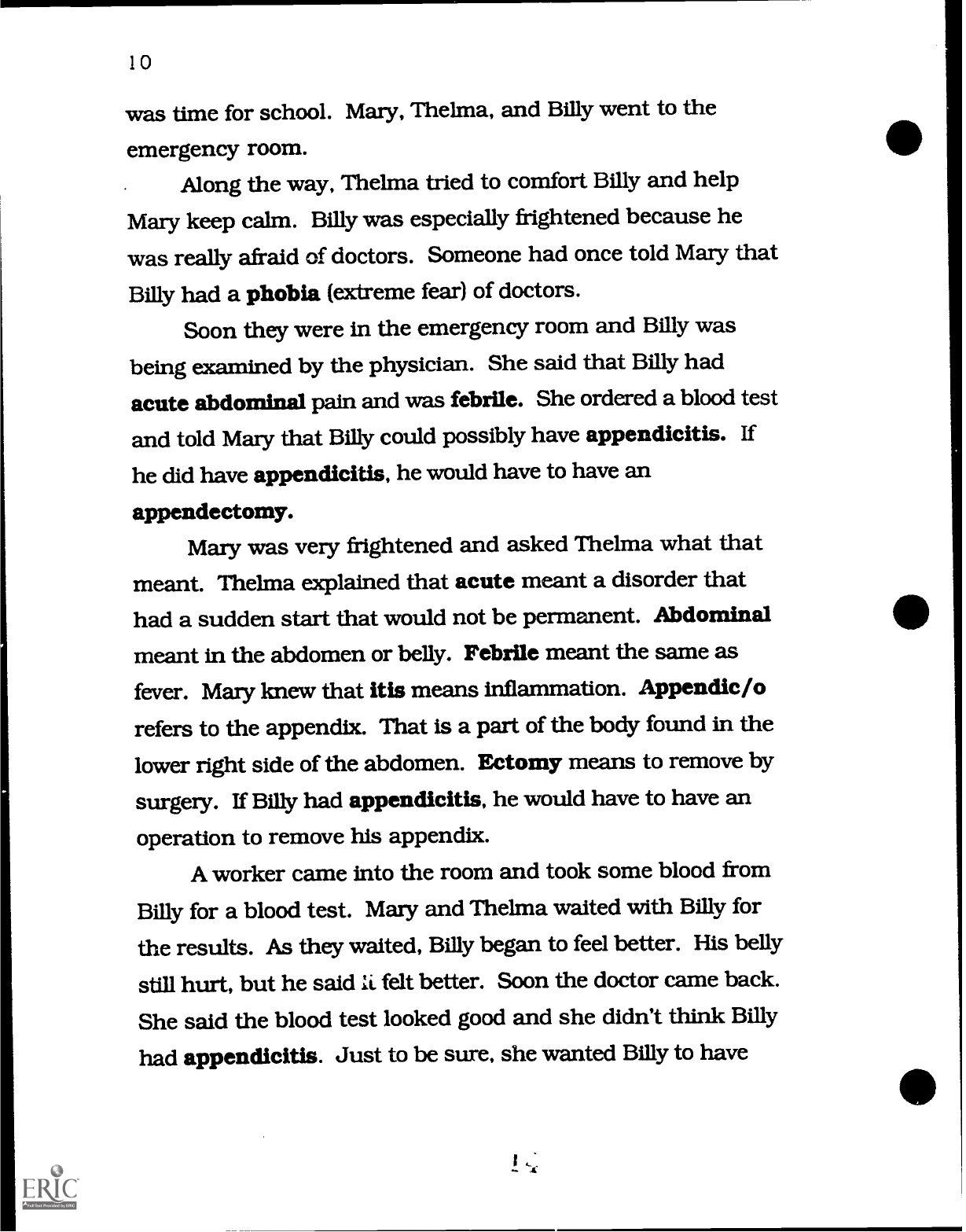
10
was time for school.
Mary, Thelma, and Billy went to the
emergency room.
Along the way, Thelma tried to comfort Billy
and help
Mary keep calm. Billy was especially
frightened because he
was really afraid of
doctors. Someone had once told Mary that
Billy had a phobia (extreme fear) of doctors.
Soon they were in the emergency room
and Billy was
being examined by the physician. She
said that Billy had
acute abdominal pain and was
febrile. She ordered a blood test
and told Mary that Billy could possibly
have appendicitis. If
he did have appendicitis, he would have to
have an
appendectomy.
Mary was very frightened and asked Thelma
what that
meant. Thelma explained that acute meant a
disorder that
had a sudden start that would not be permanent.
Abdominal
meant in the abdomen or belly. Febrile meant the same as
fever. Mary knew that itis means inflammation.
Appendic/o
refers to the appendix. That is a part of the body
found in the
lower right side of the abdomen. Ectomy means to remove
by
surgery. If Billy had appendicitis, he
would have to have an
operation to remove his appendix.
A worker came into the room and took some
blood from
Billy for a blood test. Mary and Thelma waited
with Billy for
the results. As they waited, Billy began to feel better.
His belly
still hurt, but he said IL felt better. Soon the
doctor came back.
She said the blood test looked good and she
didn't think Billy
had appendicitis. Just to be sure, she wanted
Billy to have

11
another test. She called it a sonogram. She explained that
gram means to record and sono means sound. A sonogram
uses sound waves to look inside
the body. It wouldn't hurt
Billy at all.
Thelma and Mary took Billy to another part of the
hospital where the sonogram was done. Then they went back
to the emergency room. A nurse took Billy's temperature. It
had gone down to 99.9°. Billy was beginning to feel better.
The doctor came back into the room. She said that the
sonogram showed that everything was
normal. Billy probably
had a virus. She gave Mary a prescription to take to the
pharmacy (the word part pharmac/o means drugs).
By the next day, Billy was fine. Mary was thankful that
he didn't need an operation.
New word combinations:
androphobia(man + fear) abnormal fear of men
appendectomy(appendix + surgical removal) surgical
removal of the appendix
appendicitis(appendix + inflammation ) inflammation of the
appendix
appendicopathy(appendix + disease) disease of the
appendix
arthrectomy (Joint + surgical removal) surgical removal of a
joint
cardiogram(heart + mark) a record of the electrical activity
of the heart muscle

12
cardiophobia(heart + fear) fear of heart
disease
febriphobia(fever + fear) fear caused
by the rise in
temperature
gastrectomy(stomach + surgical
removal) surgical removal
of stomach
gynephobia(woman + fear) fear of women
nephrectomy (kidney + surgical
removal) surgical removal of
the kidney
neuropharmacology(nerves + drugs)
having to do with
drugs that affect the nervous
system
ophthalmectomy(eye + surgical
removal) surgical removal of
the eye
pathophobia--(disease + fear) abnormal
fear of diseases
pharmacist(drugs + specialist) a druggist
pharmacology(drugs + study of) study
of drugs
pharmacophobia(drugs + fear) abnormal
fear of drugs
psychopharmacology--(mind + drugs + the
study of) the
study of drugs that affect the mind
thermophobia(temperature + fear) abnormal
fear of heat
tonsillectomy(tonsils + surgical removal)
surgical removal of
tonsil

13
4. Mary Learns New Word Parts
Here are the word parts you will learn in this story:
anti
audio
bi
dis
disks
inter
infra
lingu/o
post
pre
sub
venous
vertebra(e)
In a few days, Billy was feeling just fine again. Mary was
grateful that Thelma had helped her when Billy was sick, so
she bought a plant for Thelma to say thank you.
Mary took the plant to Thelma's apartment. As soon as
Thelma opened the door she noticed something was bothering
her new friend. "Mary, something's bothering you. What's
wrong?"
Mary looked a little ashamed. To tell you the truth,
Thelma, I feel stupid. If you hadn't been with me last week
when I took Billy to the hospital, I would have never known
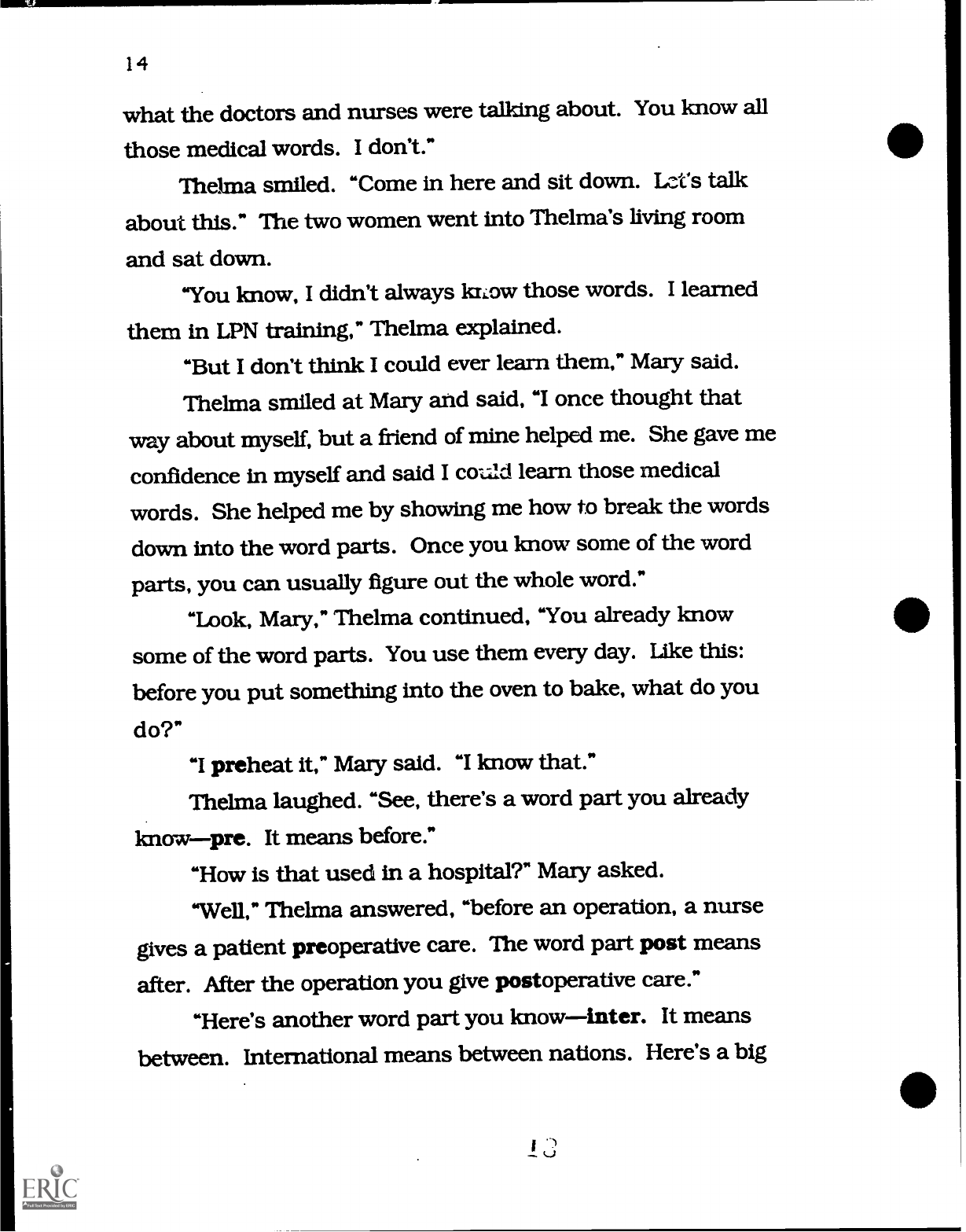
14
what the doctors and nurses were
talking about. You know all
those medical words. I don't."
Thelma smiled. "Come in here and sit
down. LA's talk
about this." The two women went into
Thelma's living room
and sat down.
"You know, I didn't always know those
words. I learned
them in LPN training," Thelma
explained.
"But I don't think I could ever learn
them," Mary said.
Thelma smiled at Mary and said, "I once
thought that
way about myself, but a
friend of mine helped me. She gave me
confidence in myself and said I could
learn those medical
words. She helped me by showing me
how to break the words
down into the word parts. Once you
know some of the word
parts, you can usually figure out the
whole word."
"Look, Mary," Thelma continued, "You already
know
some of the word parts. You use
them every day. Like this:
before you put something into the oven to bake,
what do you
do?"
"I preheat it," Mary said. "I know that."
Thelma laughed. "See, there's a word part you
already
knowpre. It means before."
"How is that used in a hospital?" Mary asked.
"Well," Thelma answered, "before an operation, a nurse
gives a patient preoperative care.
The word part post means
after. After the operation you give postoperative
care."
"Here's another word part you knowinter.
It means
between. International means between
nations. Here's a big
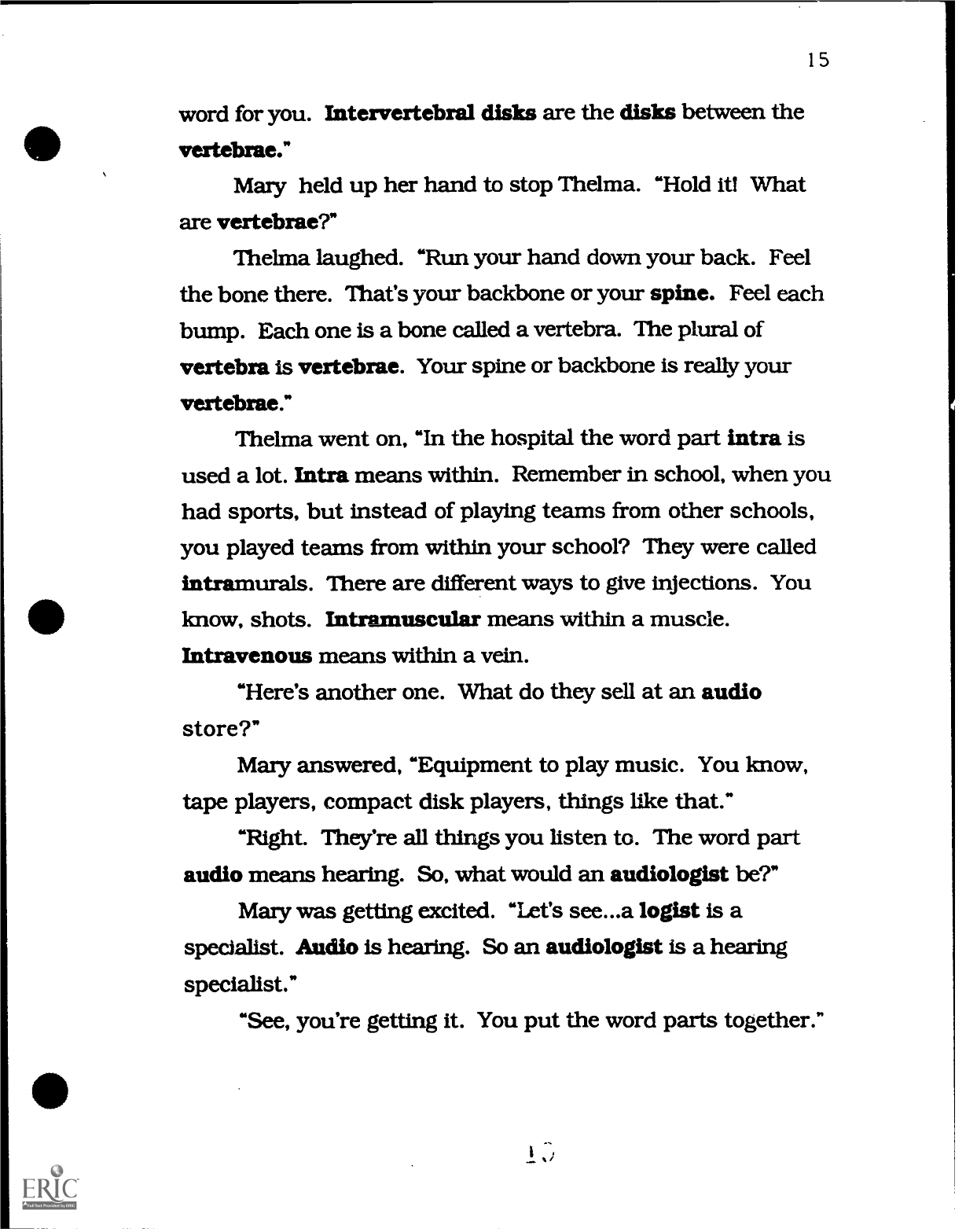
15
word for you. Intervertebral disks are the disks between the
vertebrae."
Mary held up her hand to stop Thelma. "Hold it! What
are vertebrae?"
Thelma laughed. "Run your hand down your back. Feel
the bone there. That's your backbone or your spine. Feel each
bump. Each one is a bone called a vertebra. The plural of
vertebra is vertebrae. Your spine or backbone is really your
vertebrae."
Thelma went on, "In the hospital the word part antra is
used a lot. Intra means within. Remember in school, when you
had sports, but instead of playing teams from other schools,
you played teams from within your school? They were called
intramurals There are different ways to give injections. You
know, shots. Intramuscular means within a muscle.
Intravenous means within a vein.
"Here's another one. What do they sell at an audio
store?"
Mary answered, "Equipment to play music. You know,
tape players, compact disk players, things like that."
"Right. They're all things you listen to. The word part
audio means hearing. So, what would an audiologist be?"
Mary was getting excited. "Let's see...a logist is a
specialist. Audio is hearing. So an audiologist is a hearing
specialist."
"See, you're getting it. You put the word parts together."
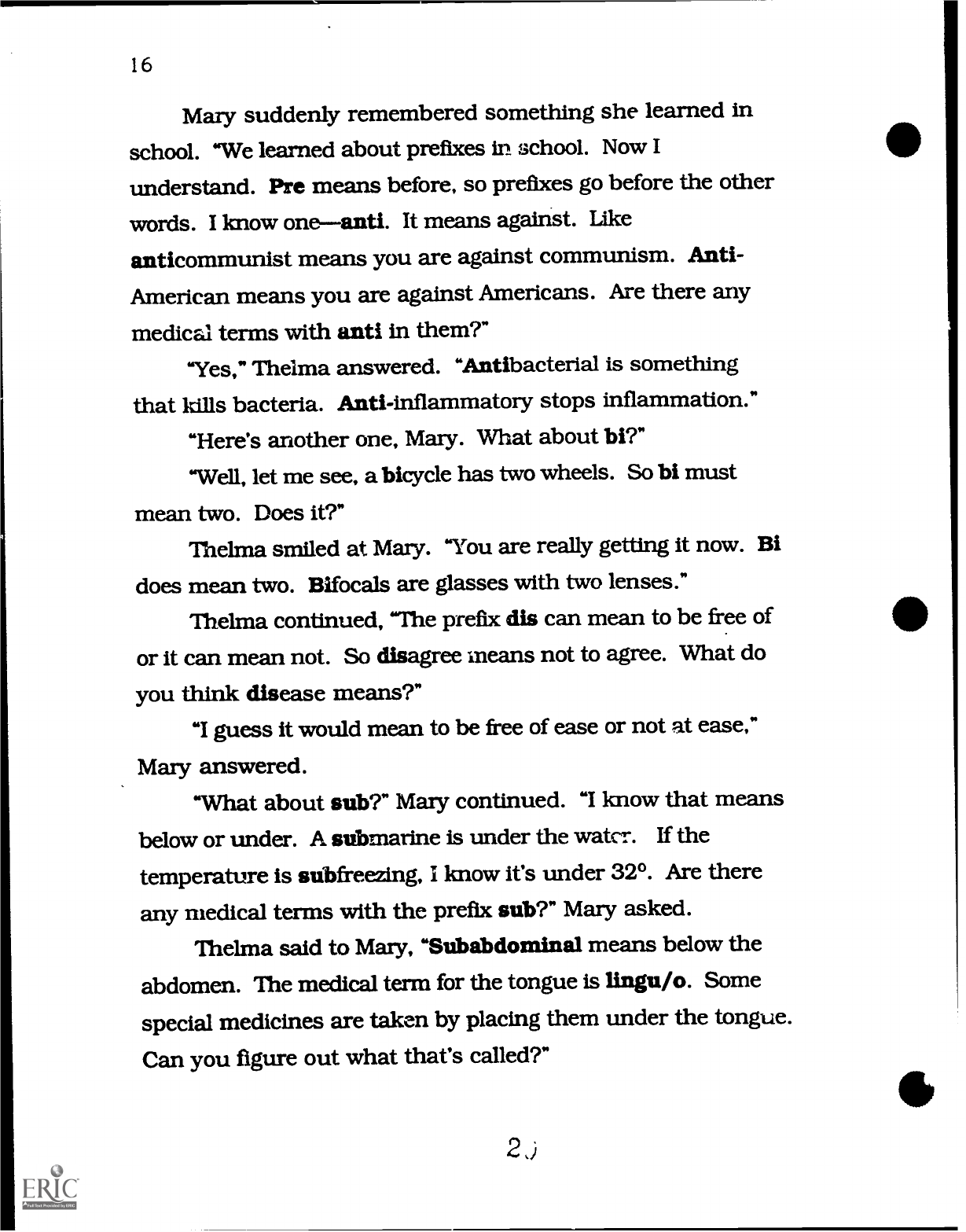
16
Mary suddenly remembered something
she learned in
school. "We learned about prefixes in
school. Now I
understand. Pre means before, so prefixes go
before the other
words. I know oneanti. It means against.
Like
anticommunist means you are against communism.
Anti -
American means you are against Americans.
Are there any
medical terms with anti in them?"
"Yes," Thelma answered. "Antibacterial
is something
that kills bacteria. Anti-inflammatory
stops inflammation."
"Here's another one, Mary. What
about bi?"
"Well, let me see, a bicycle has two
wheels. So bi must
mean two. Does it?"
Thelma smiled at Mary. "You are really getting it now.
Bi
does mean two. Bifocals are glasses with two
lenses."
Thelma continued, "The prefix dis can mean to be
free of
or it can mean not. So
disagree means not to agree. What do
you think disease means'?"
"I guess it would mean to be free of ease or not at
ease,"
Mary answered.
"What about sub?" Mary continued. "I know that means
below or under. A submarine is under the watcr.
If the
temperature is subfreezing, I know it's
under 32°. Are there
any medical terms
with the prefix sub?" Mary asked.
Thelma said to Mary, "Subabdominal means below
the
abdomen. The medical term for the tongue is
lingu/o. Some
special medicines are taken by
placing them under the tongue.
Can you figure out what that's called?"
2,)
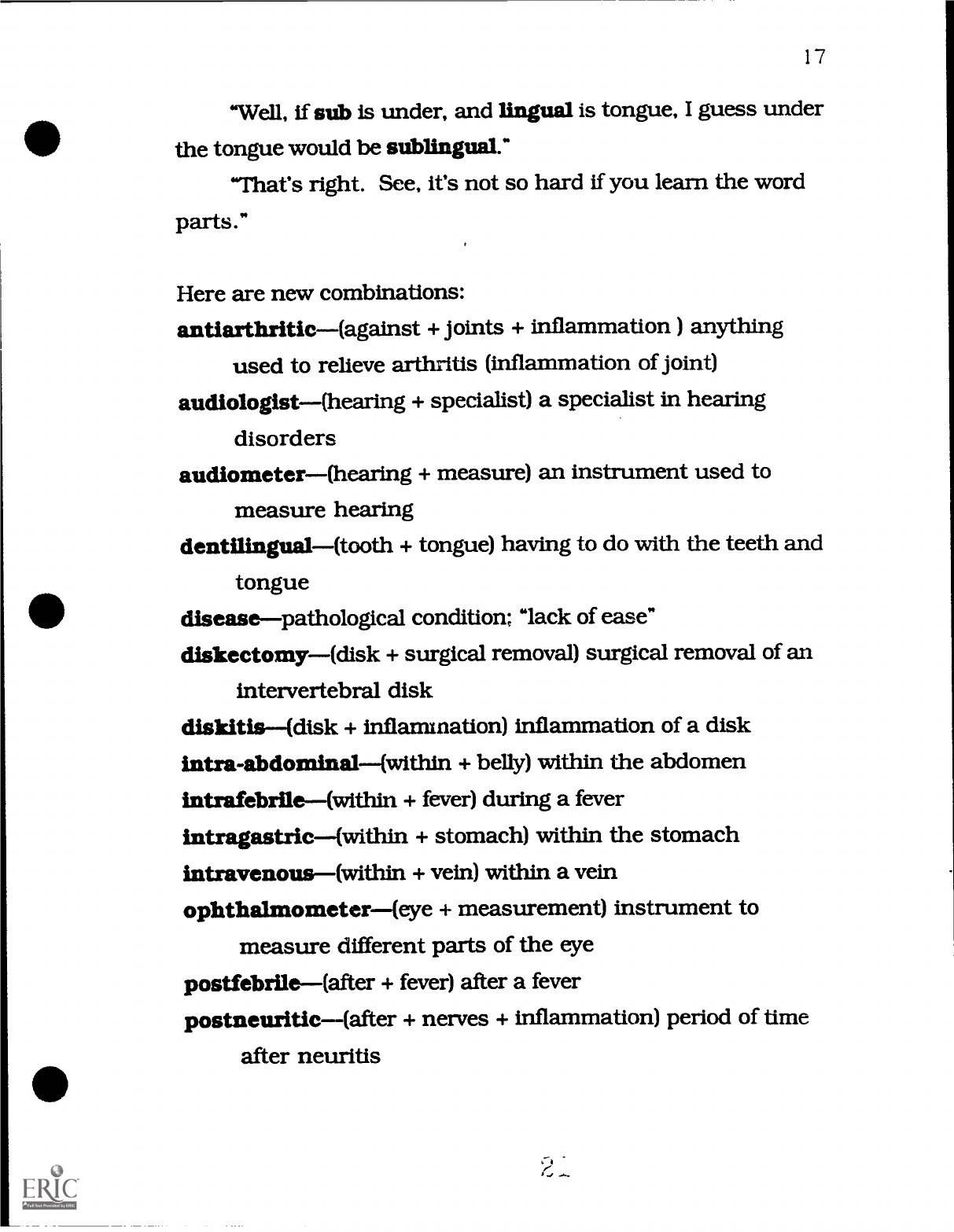
6
17
Well, if sub is under, and lingual is tongue, I guess under
the tongue would be sublingual."
"That's right. See, it's not so hard if you learn the word
parts."
Here are new combinations:
antiarthritic(against + joints + inflammation ) anything
used to relieve arthritis (inflammation of joint)
audiologist(hearing + specialist) a specialist in hearing
disorders
audiometer(hearing + measure) an instrument used to
measure hearing
dentilingual(tooth + tongue) having to do with the teeth and
tongue
diseasepathological condition; lack of ease"
diskectomy(disk + surgical removal) surgical removal of an
intervertebral disk
diskitis--(disk + inflanunation) inflammation of a disk
antra- abdominal -- (within + belly) within the abdomen
intrafebrile--(within + fever) during a fever
intragastric(within + stomach) within the stomach
intravenous(within + vein) within a vein
ophthalmometer(eye + measurement) instrument to
measure different parts of the eye
postfebrile(after + fever) after a fever
postneuritic(after + nerves + inflammation) period of time
after neuritis

18
prevertebral(before + bone of vertebra) in
front of a vertebra
subabdominal(below + belly) below the
abdomen
subdental(below + tooth) beneath a tooth
subdermal(below + skin) beneath the skin
subfebrile(below + fever) low fever
vertebrectomy(vertebra + surgical removal) removal
of a
vertebra
'.11
ti
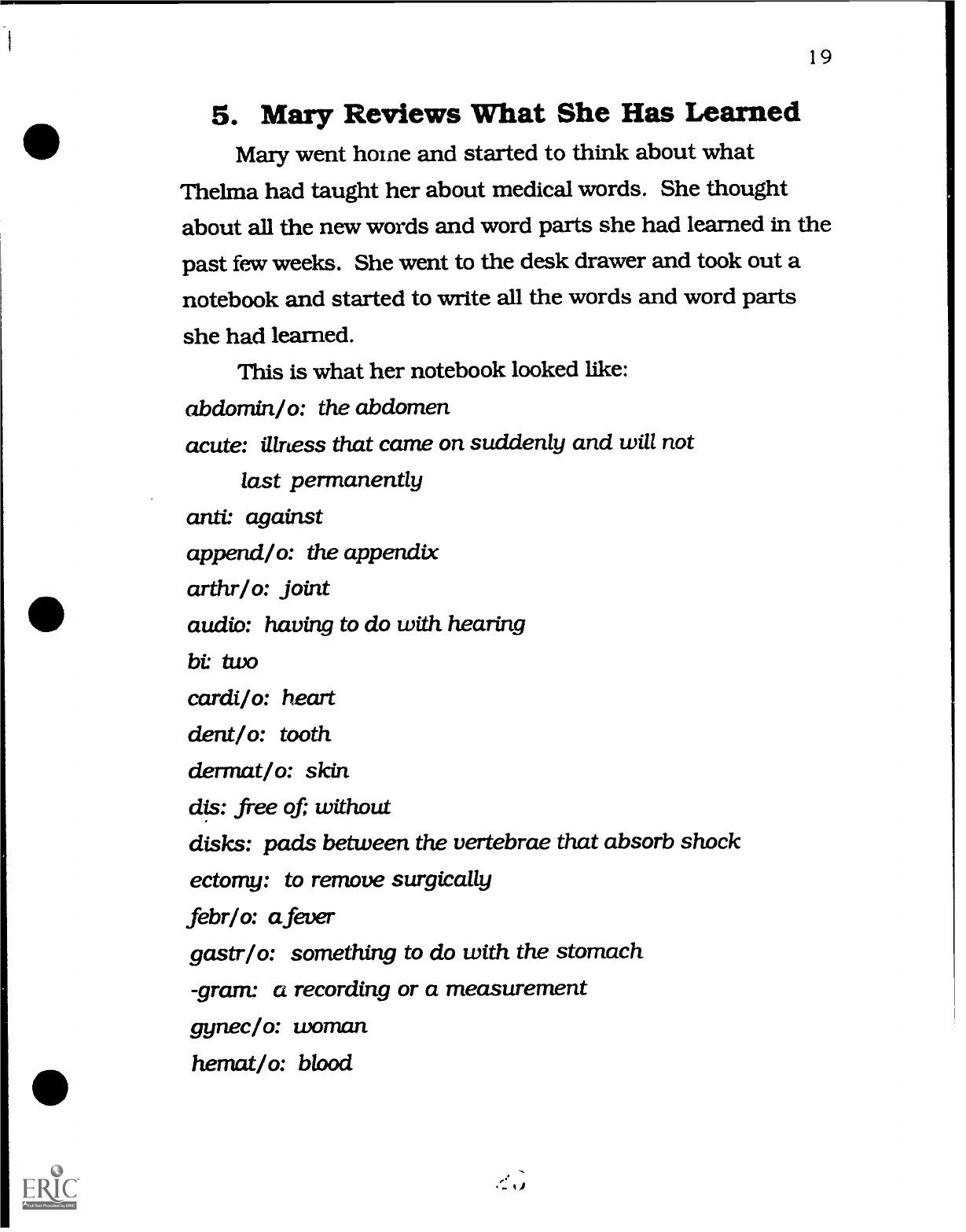
19
5. Mary Reviews What She Has Learned
Mary went home and started to think about what
Thelma had taught her about medical words. She thought
about all the new words and word parts she had learned in the
past few weeks. She went to the desk drawer and took out a
notebook and started to write all the words and word parts
she had learned.
This is what her notebook looked like:
abdornin/o: the abdomen
acute: illness that came on suddenly and will not
last permanently
with against
append/ o: the appendix
arthr/ o: joint
audio: having to do with hearing
bi: two
cardi/o: heart
dent/ o: tooth
derrnat/ (3: skin
dis: free of; without
disks: pads between the vertebrae that absorb shock
ectomy: to remove surgically
febr/o: afever
gastr/o: something to do with the stomach
-gram: a recording or a measurement
gynec/o: woman
hemat /o: blood
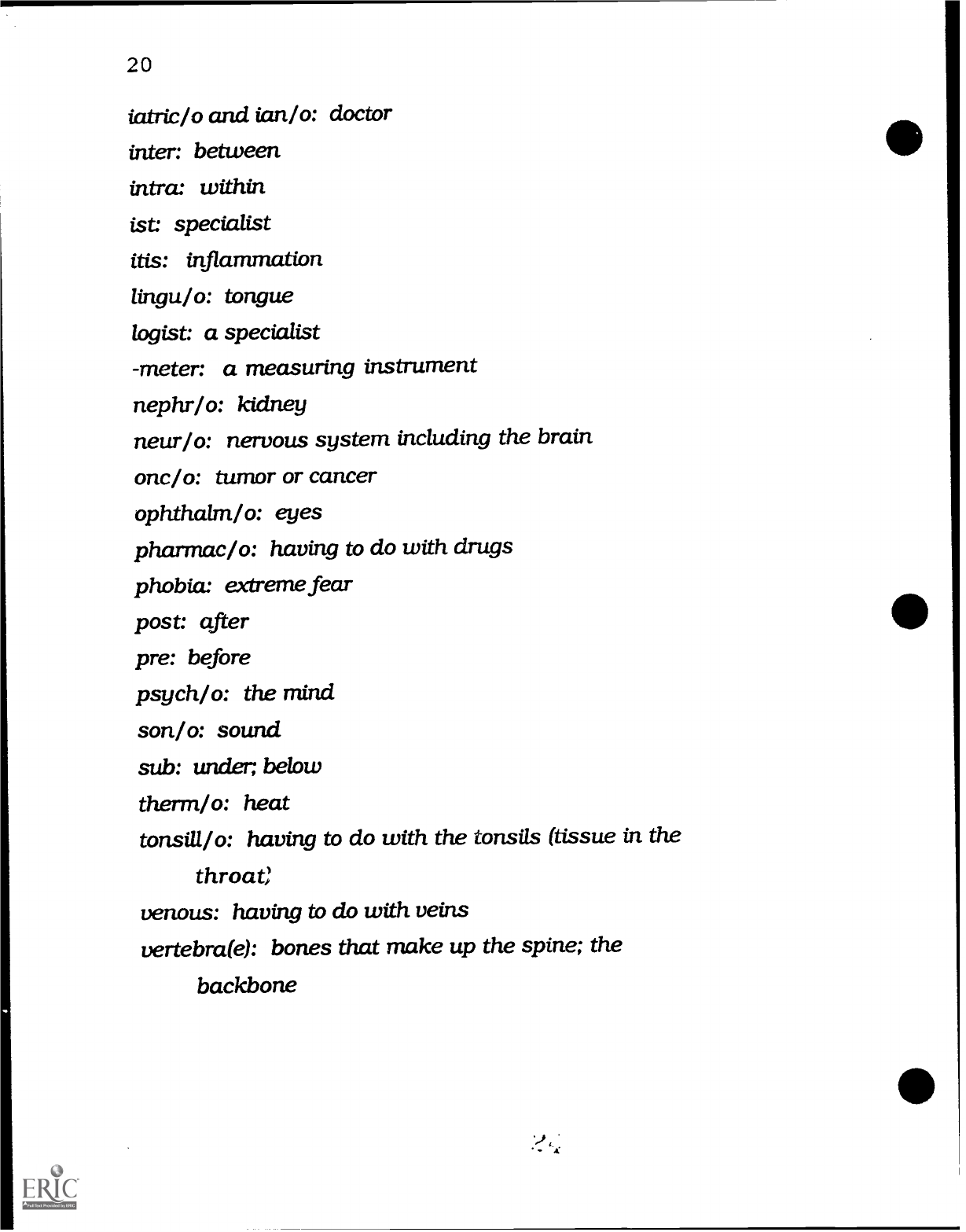
20
iatric/o and ian/o: doctor
inter: between
intro: within
ist: specialist
itis: inflammation
lingu/ o: tongue
logist: a specialist
-meter: a measuring instrument
nephr/o: kidney
neur/o: nervous system including
the brain
one /o: tumor or cancer
ophthalm /o: eyes
pharmac/ o: having to do with drugs
phobia: extreme fear
post: after
pre: before
psych/o: the mind
son/ o: sound
sub: under; below
therm/o: heat
tonsil/o: having to do with the tonsils (tissue in
the
throat
venous: having to do
with veins
vertebra(e): bones that make up the spine; the
backbone

21
As Mary looked over her notebook, she was surprised at
all she had learned. Thelma was right! She could learn
medical terms. Mary felt proud of herself. She suddenly felt
more confident about what she
could accomplish. For the first
time in years, Mary began to think about going back to school.
She called the local community college and asked them to
send her information about classes.
She received a catalog from the community college in a
few days. There was one course that really interested her. She
wanted to be an LPN like Thelma. Could she do it?
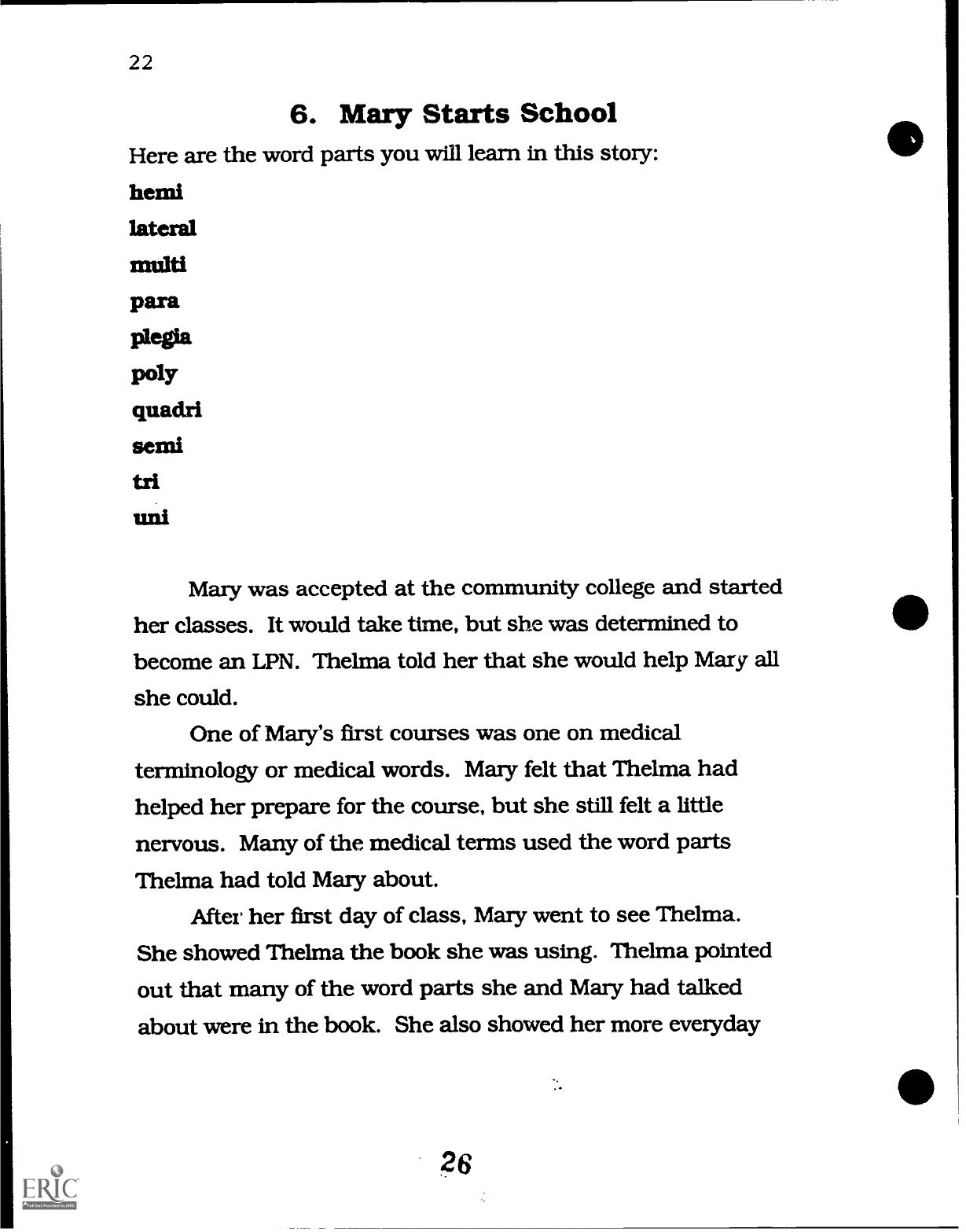
22
6. Mary Starts School
Here are the word parts you will learn in this story:
hemi
lateral
multi
para
Plegia
poly
quadri
semi
tri
uni
Mary was accepted at the community college and started
her classes. It would take time, but she was determined to
become an LPN. Thelma told her that she would help Mary all
she could.
One of Mary's first courses was one on medical
terminology or medical words. Mary felt that Thelma had
helped her prepare for the course, but she still felt a little
nervous. Many of the medical terms used the word parts
Thelma had told Mary about.
After her first day of class, Mary went to see Thelma.
She showed Thelma the book she was using. Thelma pointed
out that many of the word parts she and Mary had talked
about were in the book. She also showed her more everyday
26
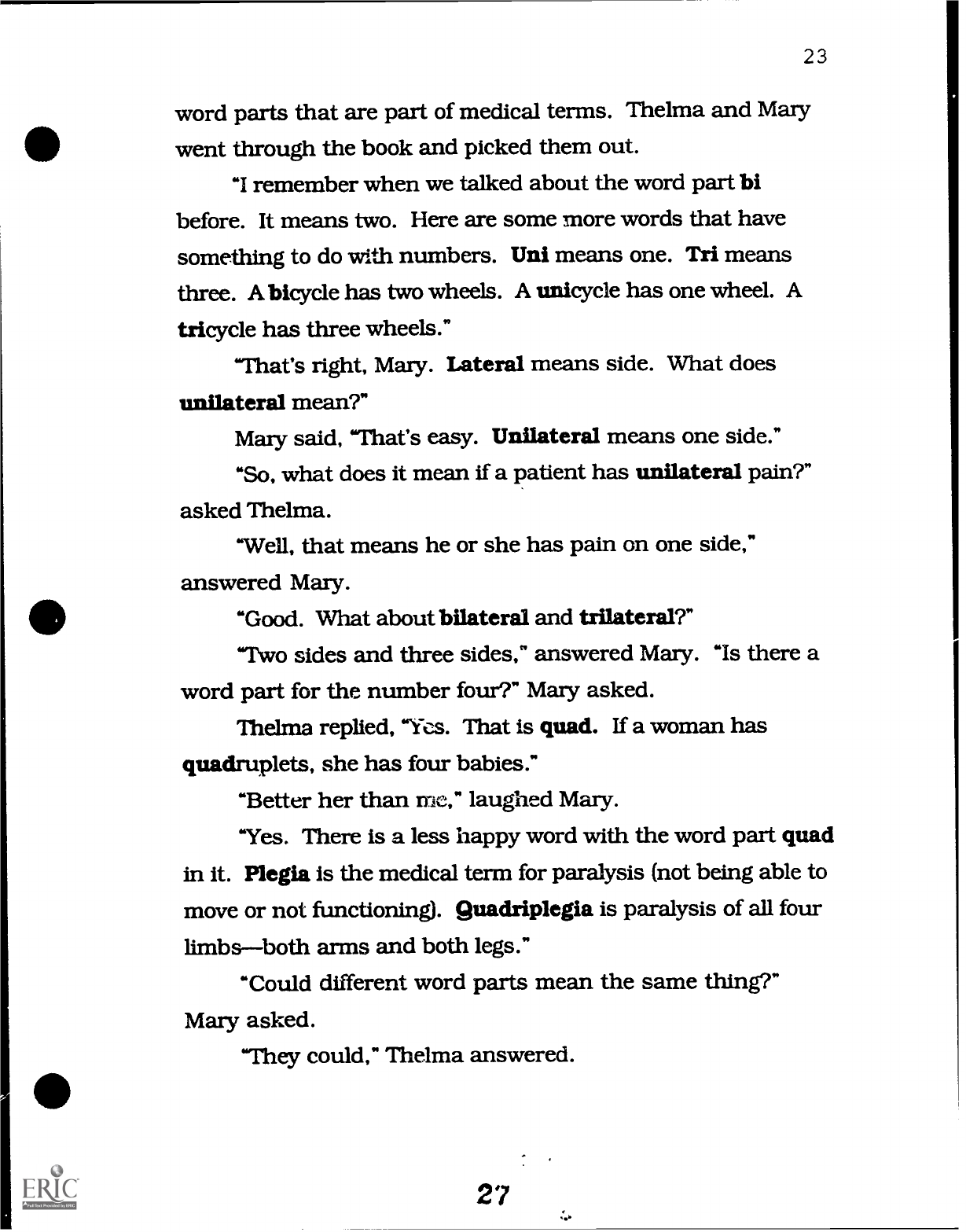
23
word parts that are part of medical terms. Thelma and Mary
went through the book and picked them out.
"I remember when we talked about the word part bi
before. It means two. Here are some more words that have
something to do with numbers. Uni means one. Tri means
three. A bicycle has two wheels. A unicycle has one wheel. A
tricycle has three wheels:
"That's right, Mary. Lateral means side. What does
unilateral mean?"
Mary said, "That's easy. Unilateral means one side:
"So, what does it mean if a patient has unilateral pain?"
asked Thelma.
Well, that means he or she has pain on one side,"
answered Mary.
"Good. What about bilateral and trilateral?
"Two sides and three sides," answered Mary. "Is there a
word part for the number four?" Mary asked.
Thelma replied, "Yes. That is quad. If a woman has
quadruplets, she has four babies."
"Better her than me," laughed Mary.
"Yes. There is a less happy word with the word part quad
in it. Plegia is the medical term for paralysis (not being able to
move or not functioning). Quadriplegia is paralysis
of all four
limbsboth arms and both legs:
"Could different word parts mean the same thing'?"
Mary asked.
"They could," Thelma answered.

24
"I thought so. I think
poly and multi mean the same
thing. I think they both mean
many."
"That's right," Thelma said. "See
if you can figure out
this long wordpolyneuropathy."
"That seems like such a long
word. Let's see. Poly means
many. Neur means nerves.
Pathy means disease. So
polyneuropathy would mean a
disease of many nerves. I did
it! What about a word with
multi in it?"
"Well, let's see," Thelma said
with a smile. "You're
making this hard for me. There
is multilateral. You know
what that means."
"Yes, Thelma, I know. It means many
sides. Any other
one?"
"Here's one. Para means birth.
What would multipara
mean?"
Mary thought for a minute. "I guess
multipara would
mean many births."
"Yes," Thelma said. "It refers to
the mother. Multipara
means a woman has
had more than one child, but not
necessarily at the same time."
"Here are two more word parts
that mean the same
thinghemi and semi. I think they
both mean half. A
hemisphere is half of a spherehalf
of the globe. Semiannual
means every
half year. Are they used in medical
terms?"
asked Mary.
hemiplegia means paralysis on one
side of the
bodyhalf of the body. It would mean,
for instance, that a
28

25
person was paralyzed on the right side, arm
and leg. What do
you think hemicardia means?"
Thelma asked Mary.
"You are making me think," Mary laughed. "Henri is
half.
Cardia is heart. Hemicardia means there is only half of a
heart."
"Good," Thelma said. "Now let me think. A word with
semi in it. Semicircular means a half-circle. The semicircular
canals are part of the ear that are shaped like
half circles."
Here are new combinations:
cardioplegia(heart + paralysis) paralysis of the heart
gastroplegia(stomach + paralysis) paralysis of the stomach
hemigastrectomy(half + stomach + surgical removal)
surgical removal of half of the stomach
hemilingual(half + tongue) affecting or having to do with one
half of the tongue
heminephrectomy(half + kidney + surgical removal) surgical
removal of one kidney
hemiplegia(half + paralysis) paralysis of one side of the body
hemivertebra(half + vertebra) born with only half of a
vertebra
polyarthritis(many + jcint + inflammation) inflammation of
more than one joint
polyneuritis(many + nerve + inflammation) inflammation of
more than one nerve
polypathia(many + diseases) several diseases in one person
at one time
29
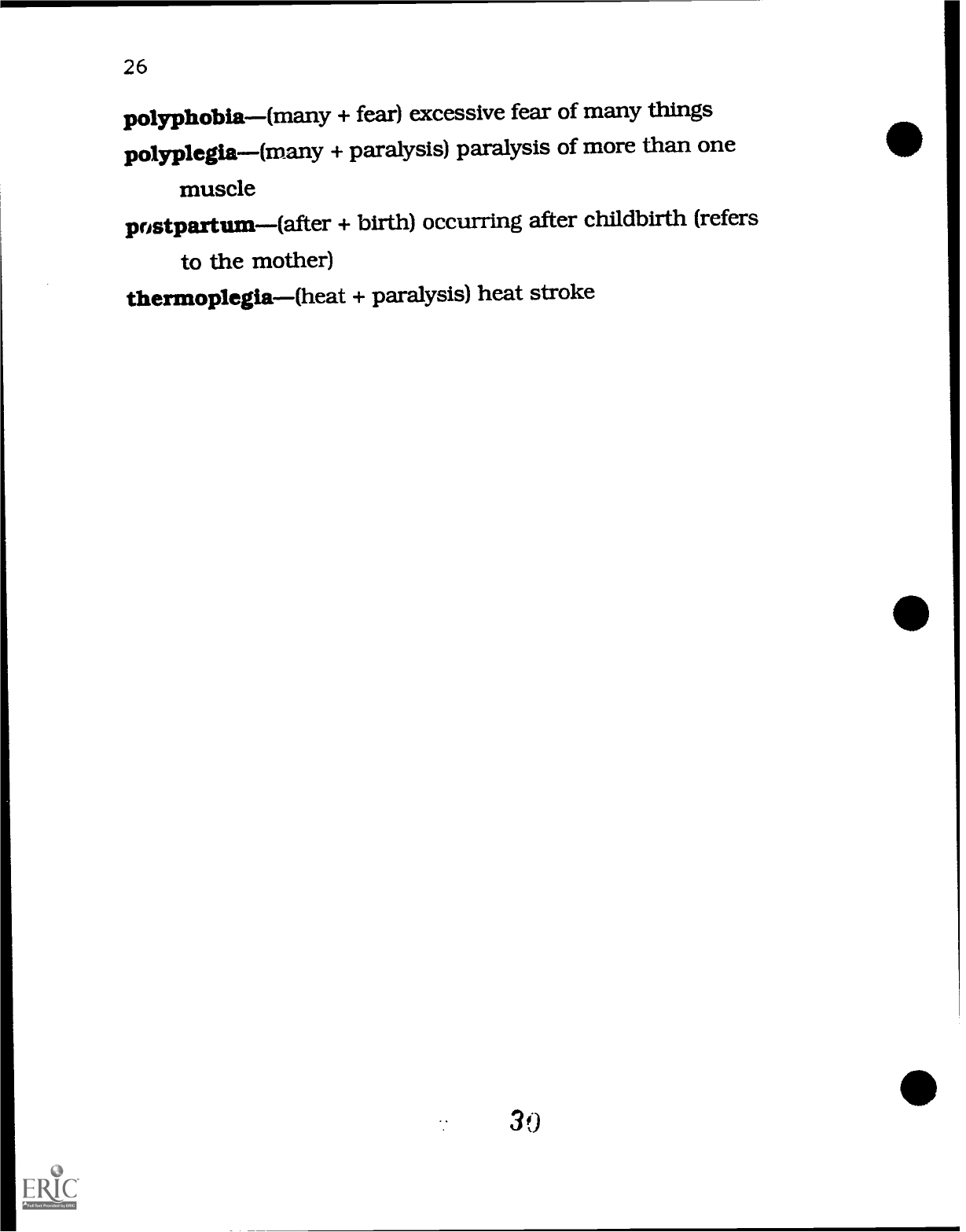
26
polyphobia(many + fear) excessive
fear of many things
polyplegia(many + paralysis) paralysis
of more than one
muscle
postpartum(after + birth) occurring
after childbirth (refers
to the mother)
thermoplegia(heat + paralysis) heat
stroke
30
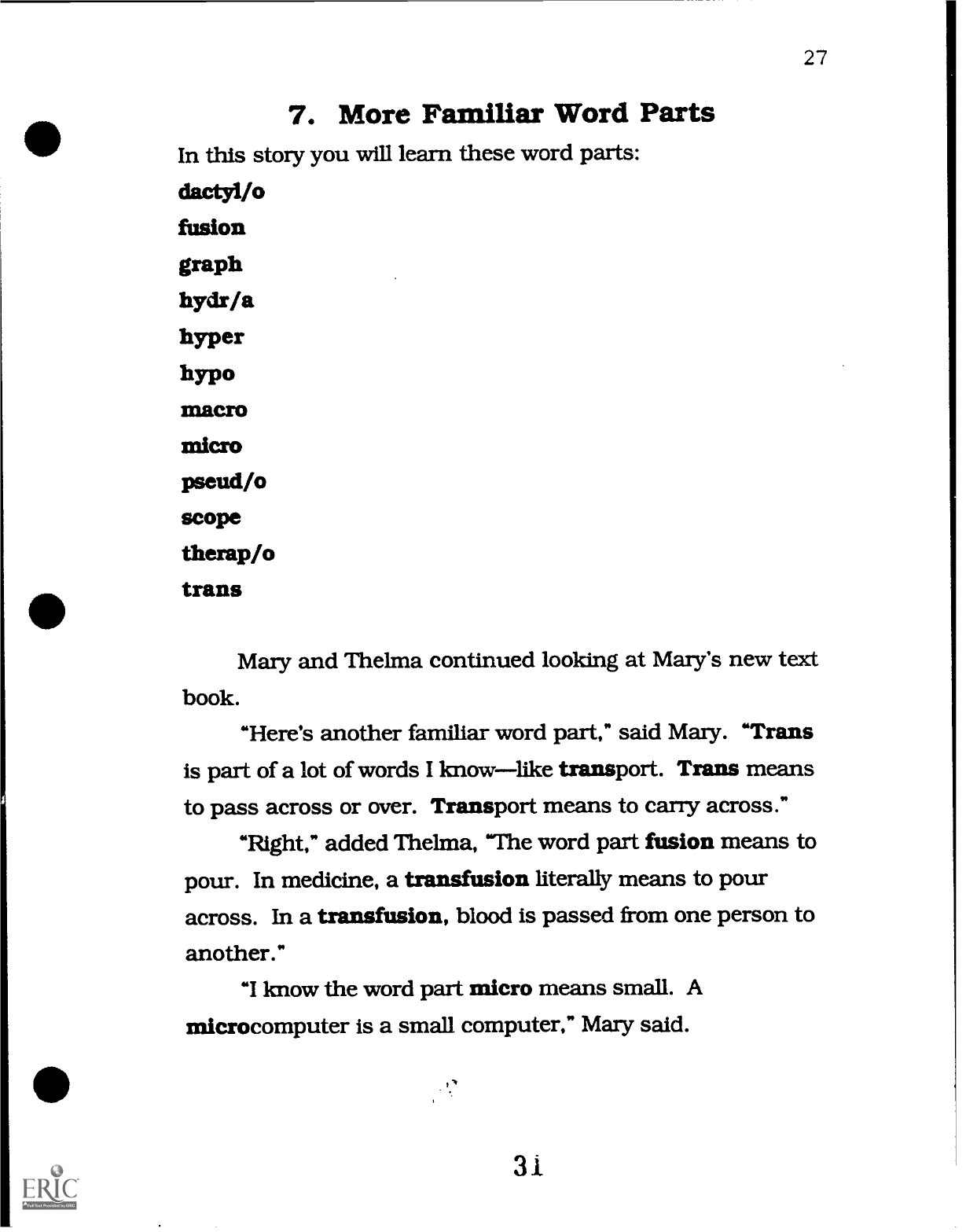
27
7. More Familiar Word Parts
In this story you will learn these word parts:
dactyl /o
fusion
graph
hydr/a
hyper
hypo
macro
micro
pseud/o
scope
therap/o
trans
Mary and Thelma continued looking at Mary's new text
book.
*Here's another familiar word part," said Mary. "Trans
is part of a lot of words I knowlike transport. Trans means
to pass across or over. Transport means to carry across."
*Right," added Thelma, "The word part fusion means to
pour. In medicine, a transfusion literally means to pour
across. In a transfusion, blood is passed
from one person to
another."
"I know the word part micro means small. A
microcomputer is a small computer," Mary said.
3i
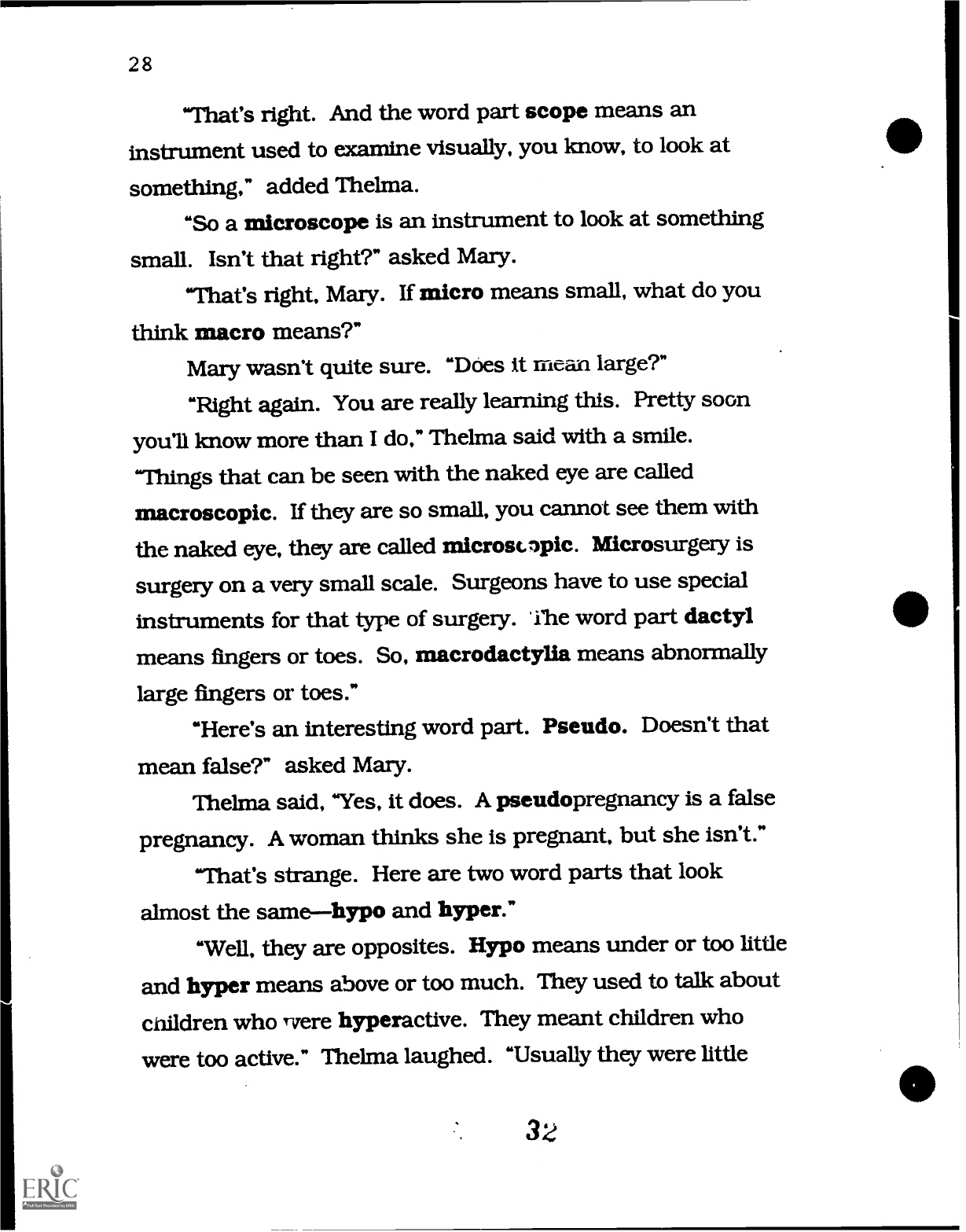
28
"That's right. And the word part scope means an
instrument used to examine visually, you
know, to look at
something," added Thelma.
"So a microscope is an instrument to
look at something
small. Isn't that right?" asked Mary.
"That's right, Mary. If micro means small,
what do you
think macro means?"
Mary wasn't quite sure. "Does it mean
large?"
"Right again. You are really learning
this. Pretty soon
you'll know more than I do," Thelma
said with a smile.
"Things that can be seen with the
naked eye are called
macroscopic. If they are so small, you cannot see
them with
the naked eye, they are called microscopic.
Microsurgery is
surgery on a very small scale.
Surgeons have to use special
instruments for that type of surgery. 'ibe
word part dactyl
means fingers or toes. So,
macrodactylia means abnormally
large fingers or toes."
"Here's an interesting word part. Pseudo. Doesn't
that
mean false?" asked Mary.
Thelma said, "Yes, it does. A pseudopregnancy is a
false
pregnancy. A woman thinks
she is pregnant, but she isn't."
"That's strange. Here are two word parts that
look
almost the samehypo and hyper."
"Well, they are opposites. Hypo means under or too
little
and hyper means above or too
much. They used to talk about
children who were hyperactive. They meant
children who
were too active."
Thelma laughed. "Usually they were little
32
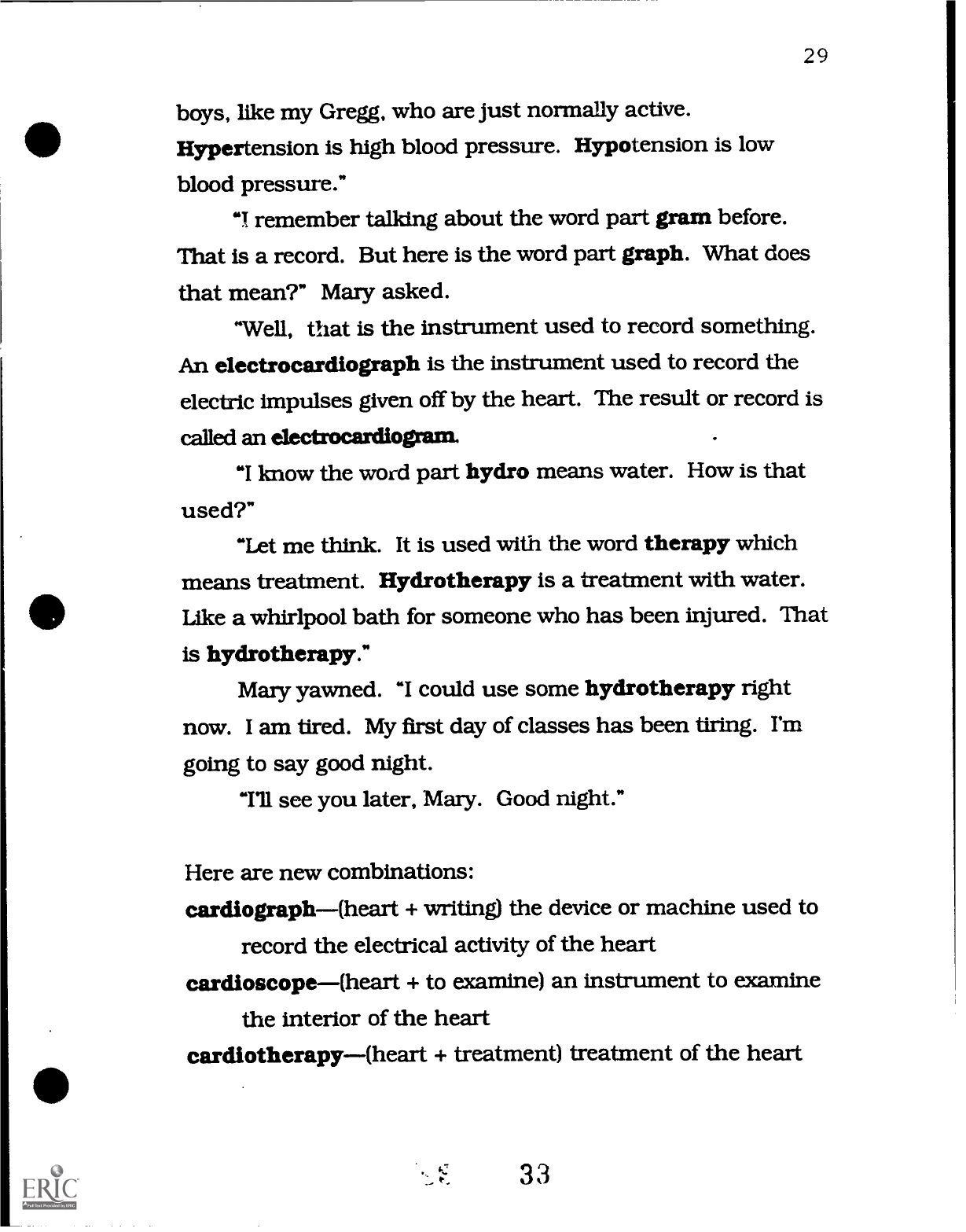
29
boys, like my Gregg, who are just normally active.
Hypertension is high blood pressure. Hypotension is low
blood pressure:
remember talking about the word part gram before.
That is a record. But here is the word part graph. What does
that mean?" Mary asked.
"Well, that is the instrument used to record something.
An electrocardiograph is the instrument used to record the
electric impulses given off by the heart. The result or record is
called an electrocardiogram.
"I know the word part hydro means water. How is that
used?"
"Let me think. It is used with the word therapy which
means treatment. Hydrotherapy is a treatment
with water.
Like a whirlpool bath for someone who has been injured. That
is hydrotherapy:
Mary yawned. "I could use some hydrotherapy right
now. I am tired. My first day of classes
has been tiring. I'm
going to say good night.
"Ill see you later, Mary. Good night:
Here are new combinations:
cardiograph(heart + writing) the device or machine used to
record the electrical activity of the heart
cardioscope(heart + to examine) an instrument to examine
the interior of the heart
cardiotherapy(heart + treatment) treatment of the heart
33
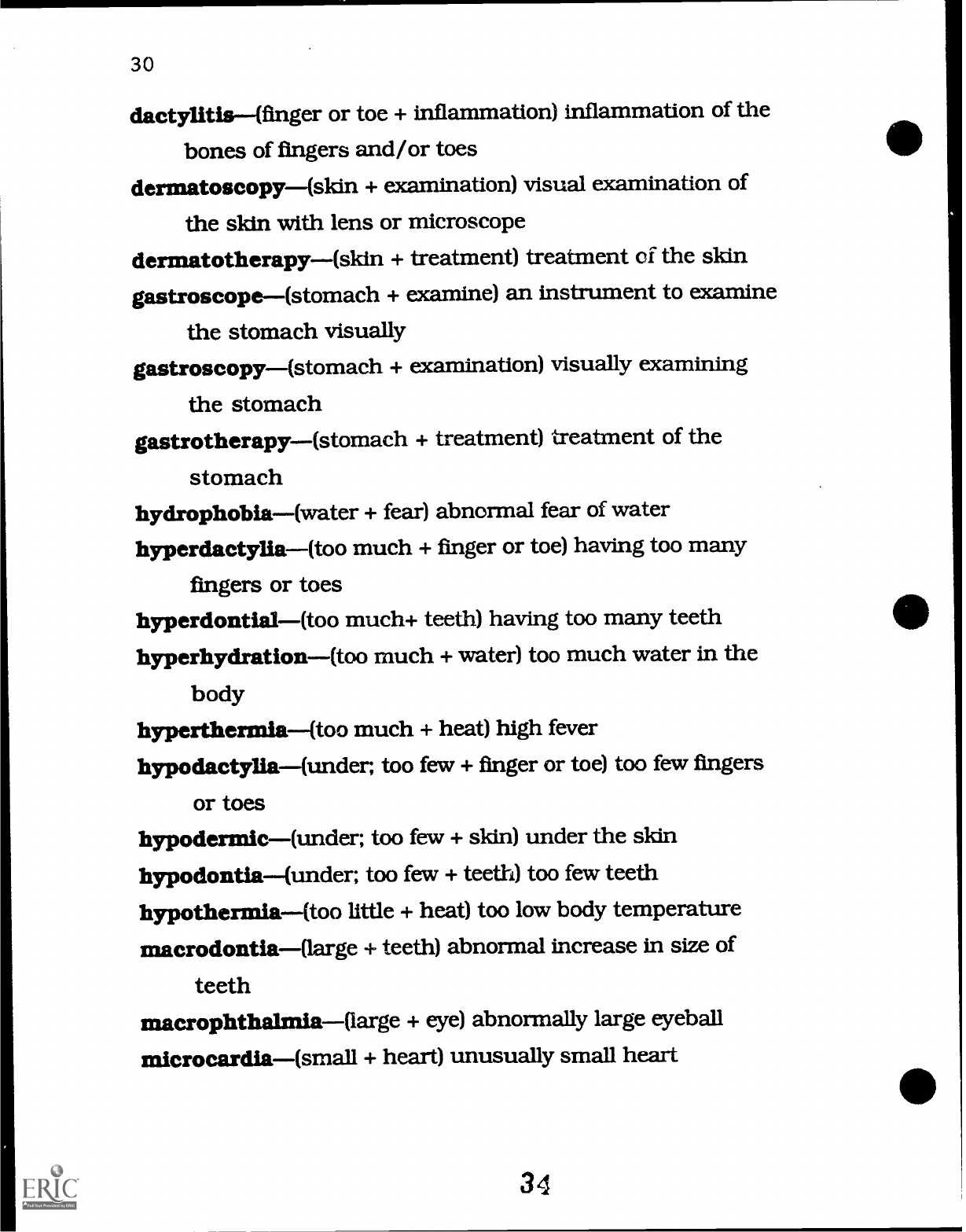
30
dactylitis(finger or toe + inflammation) inflammation
of the
bones of fingers and/or toes
dermatoscopy(skin + examination) visual examination
of
the skin with lens or microscope
dermatotherapy(skin + treatment) treatment of the skin
gastroscope(stomach + examine) an instrument to examine
the stomach visually
gastroscopy(stomach + examination) visually examining
the stomach
gastrotherapy(stomach + treatment) treatment of the
stomach
hydrophobia(water + fear) abnormal fear of water
hyperdactylia(too much + finger or toe) having too many
fingers or toes
hyperdontial(too much+ teeth) having too many teeth
hyperhydration(too much + water) too much water in the
body
hyperthermia(too much + heat) high fever
hypodactylia(under; too few + finger or toe) too few fingers
or toes
hypodermic(under; too few + skin) under the skin
hypodontia(under; too few + teeth) too few teeth
hypothermia(too little + heat) too low body temperature
macrodontia(large + teeth) abnormal increase in size of
teeth
macrophthalmia(large + eye) abnormally large eyeball
microcardia(small + heart) unusually small heart
34

31
microdactylia(small + finger or toe) abnormally small toes
and fingers
microdontia(small + teeth) unusually small teeth
microgastria(small + stomach) unusually small stomach
oncotherapy(tumor or cancer + treatment) treatment of
tumors
ophthalmoscope (eye + examine) instrument for examining
the inside of the eye
polydactyly(many + finger or toe) having more than the
usual number of fingers or toes
pseudoarthritis(false + Joint + inflammation) a condition
that imitates arthritis
submicroscopic(below + small + to examine) too small to be
seen with a microscope
therapist(treatment + specialist) a person who gives
therapy
thermotherapy(heat + treatment) treatment using heat
tonsilloscopy(tonsil + examine) looking at tonsils
transdermal(across + skin) through the skin
35

32
8. Places and Directions
4110
In this story you will learn these
word parts:
ante
anteri/o
caud/o
cephal/o
deep
dors/o
inferior
lateral
medial
midline
poster/o
superficial
superior
ventr/o
When Mary began studying her medical terminology
book, she realized that there are some special terms
used to
tell direction or places. It confused her at
first.
One day when she was talking to Thelma she
said, "Why
can't they use regular words like top when
talking about a
person's body?"
Thelma laughed. "It seems like it would make it easier to
learn, I know. But the medical terms are more
precise and can
36
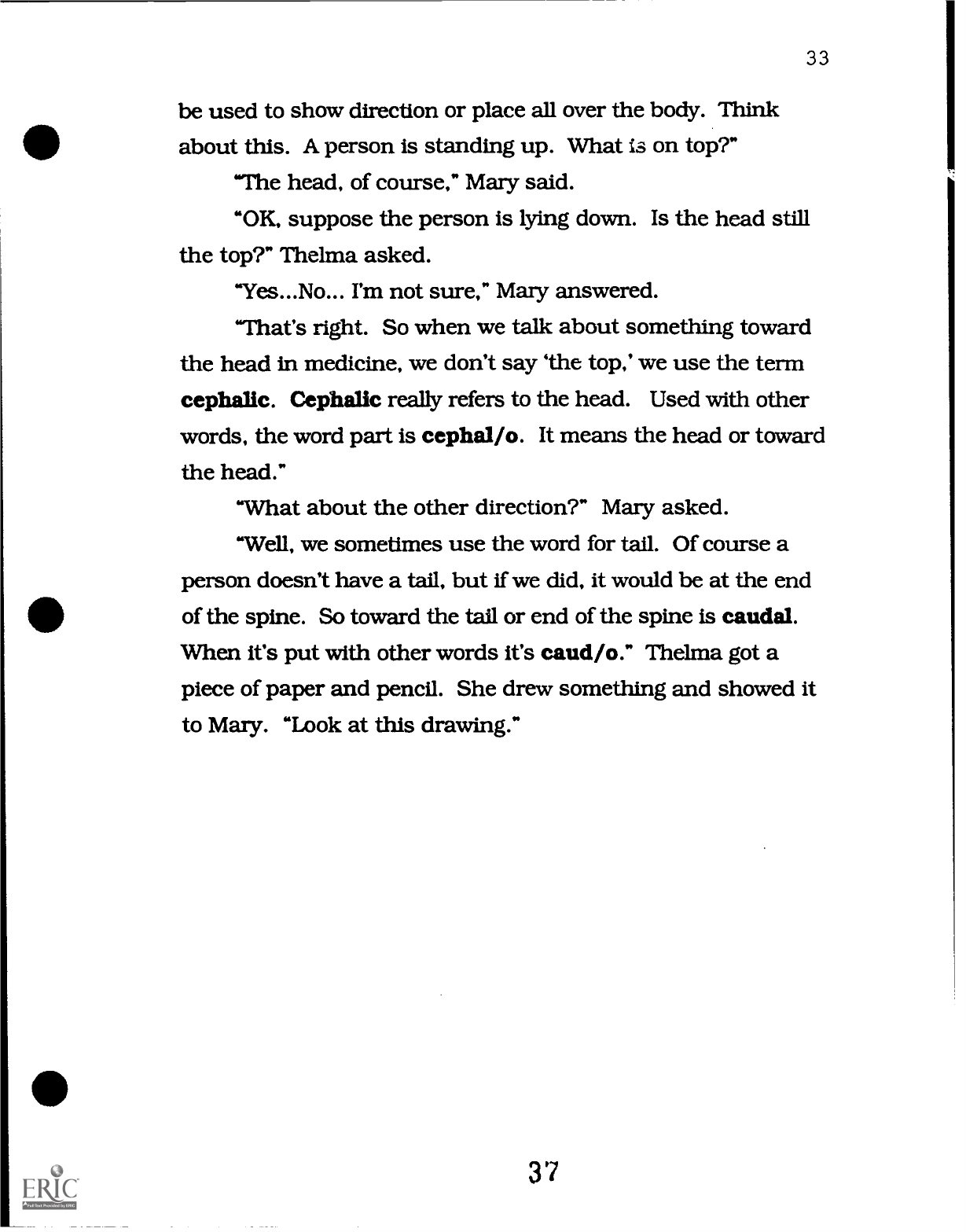
33
be used to show direction or place all over the body. Think
about this. A person is standing up. What is on top?"
"The head, of course," Mary said.
"OK, suppose the person is lying down. Is the head still
the top?" Thelma asked.
"Yes...No... I'm not sure," Mary answered.
"That's right. So when we talk about something toward
the head in medicine, we don't say 'the top,' we use the term
cephalic. Cephalic really refers to the head. Used with other
words, the word part is cephal/o. It means the head or toward
the head."
"What about the other direction?" Mary asked.
"Well, we sometimes use the word for tail. Of course a
person doesn't have a tail, but if we did, it would be at the end
of the spine. So toward the tail or end of the spine is caudal.
When it's put with other words it's caud/o." Thelma got a
piece of paper and pencil. She drew something and showed it
to Mary. "Look at this drawing."
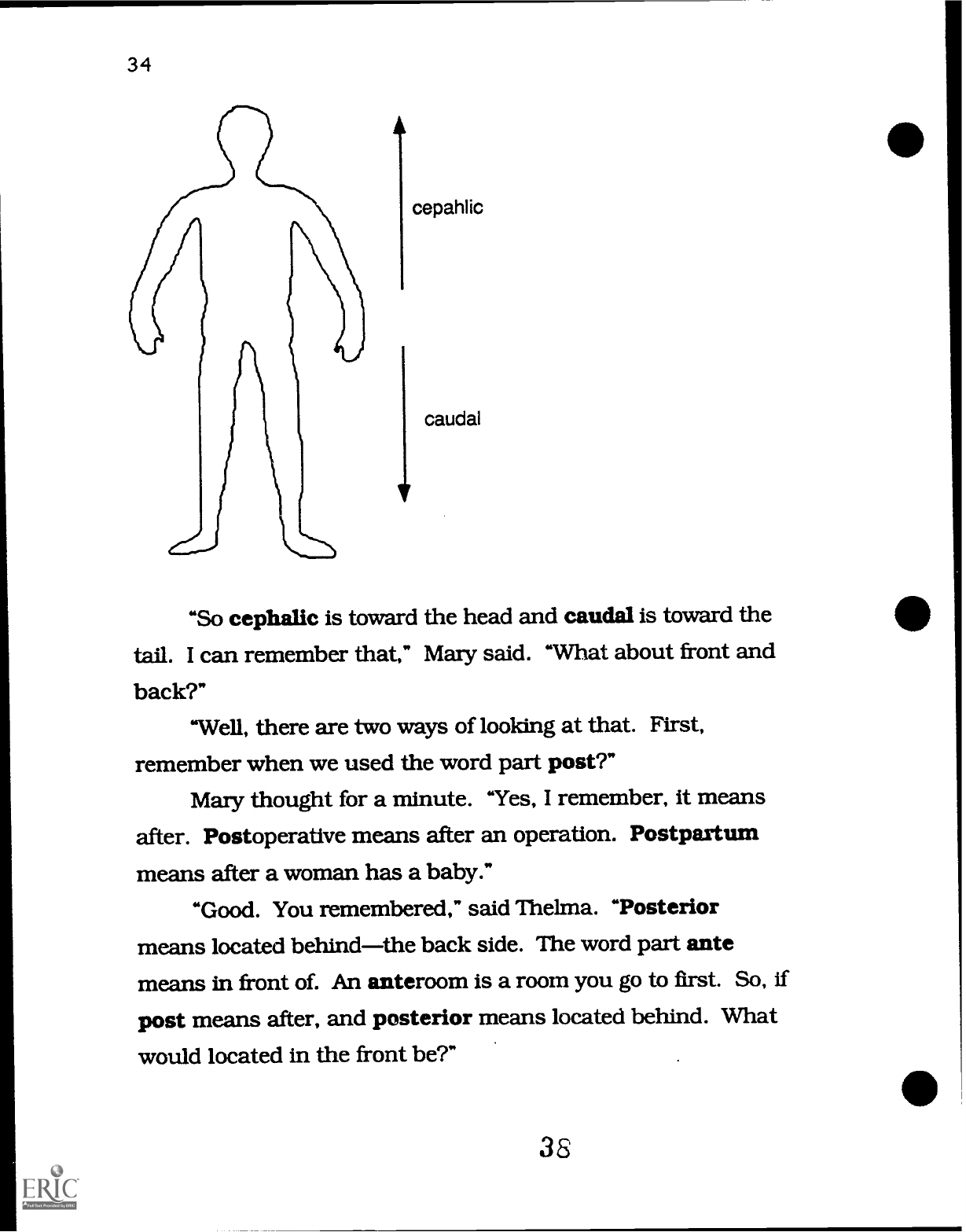
34
A
cepahlic
caudal
"So cephalic is toward the head and caudal is toward
the
tail.
I can remember that," Mary said. "What about front
and
back?"
"Well, there are two ways of looking at that. First,
remember when we used the word part post?"
Mary thought for a minute. "Yes, I remember, it means
after. Postoperative means after an operation. Postpartum
means after a woman has a baby."
"Good. You remembered," said Thelma. "Posterior
means located behindthe back side.
The word part ante
means in front of. An anteroom is a room you go
to first. So, if
post means after, and posterior means
located behind. What
would located in the front be?"
38
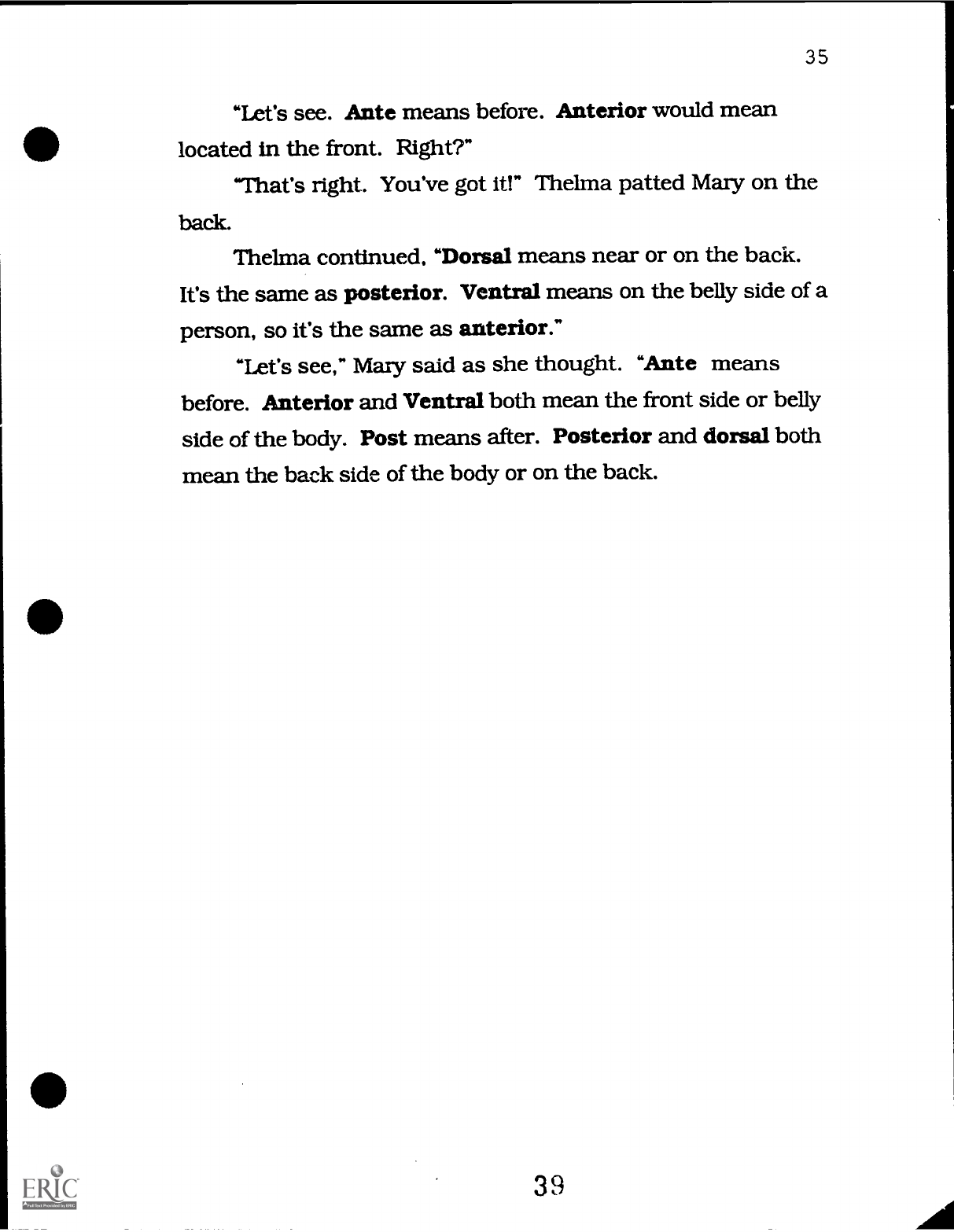
35
"Let's see. Ante means before. Anterior would mean
located in the front. Right?"
"That's right. You've got it!" Thelma patted Mary on the
back.
Thelma continued, "Dorsal means near or on the back.
It's the same as posterior. Ventral means on the belly side of a
person, so it's the same as
anterior."
"Let's see," Mary said as she thought. "Ante means
before. Anterior and Ventral both mean the front side or belly
side of the body. Post means after. Posterior and
dorsal both
mean the back side of the body or on
the back.
39
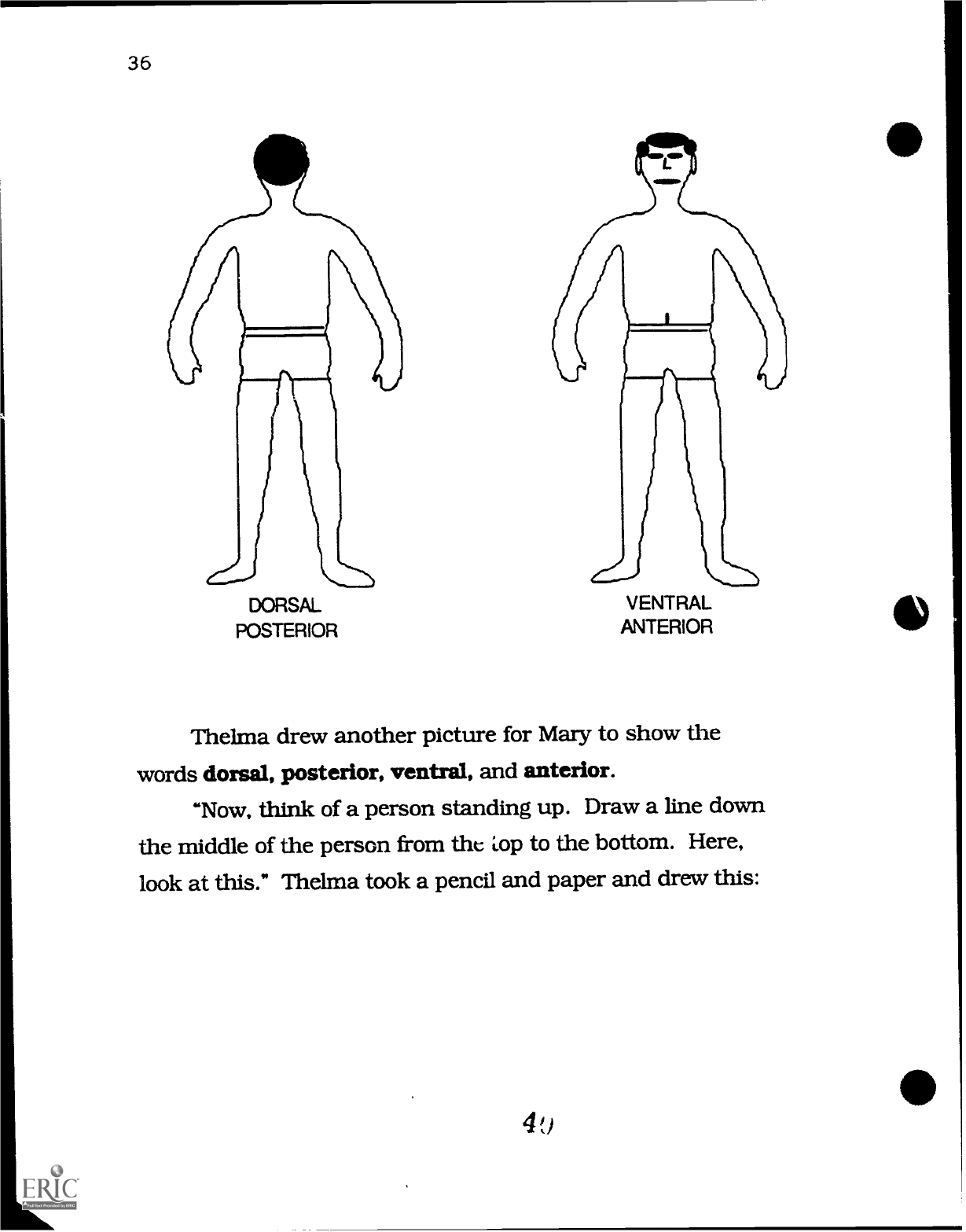
36
A
DORSAL
POSTERIOR
VENTRAL
ANTERIOR
Thelma drew another picture for Mary to show
the
words dorsal, posterior, ventral, and anterior.
"Now, think of a person standing up. Draw a
line down
the middle of the person from the i.op to the
bottom. Here,
look at this." Thelma took a pencil and paper
and drew this:
49
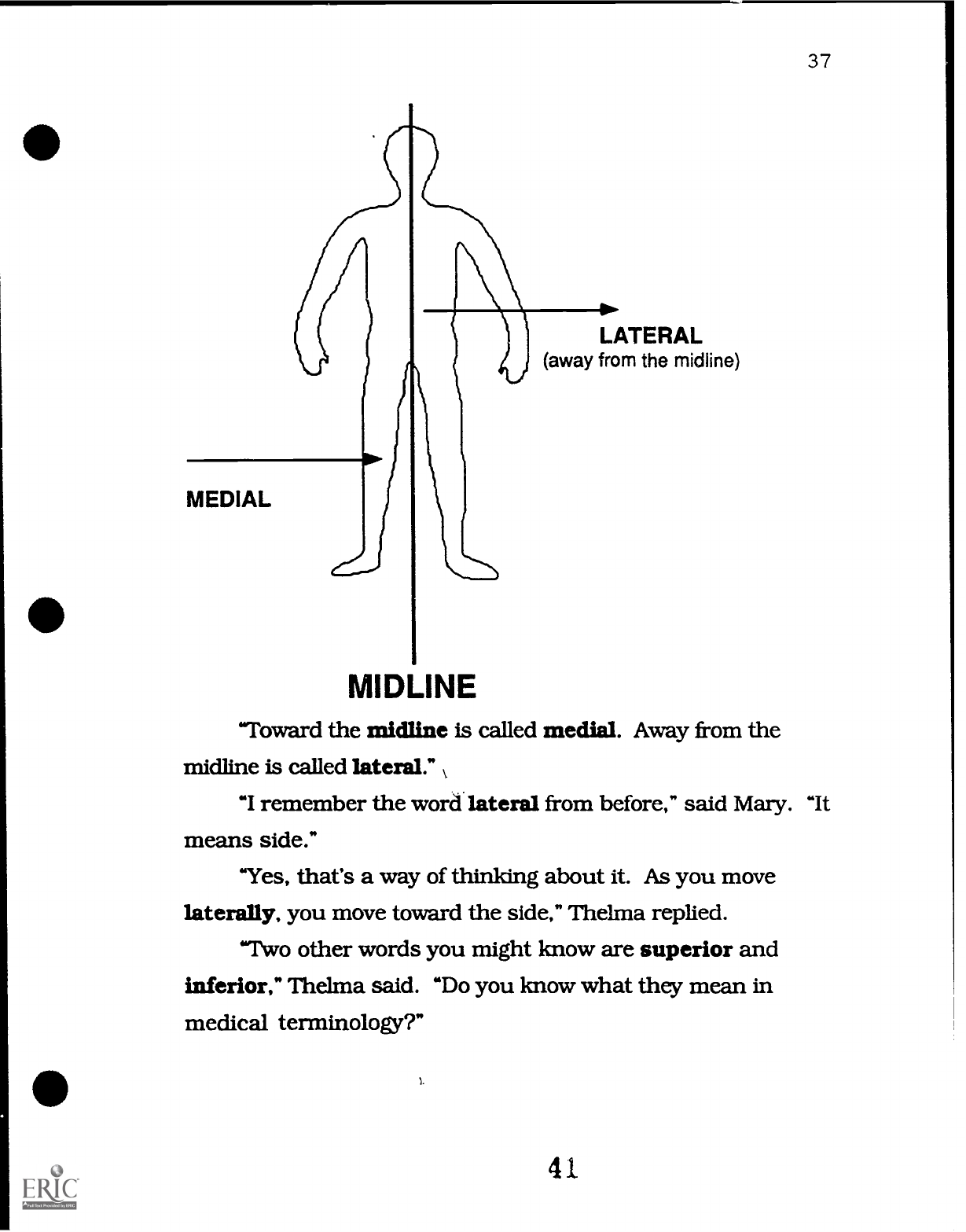
MEDIAL
I
LATERAL
(away from the midline)
37
MIDLINE
"Toward the midline is called medial. Away from the
midline is called lateral."
,
"I remember the word lateral from before," said Mary. "It
means side:
"Yes, that's a way of thinking about it. As you move
laterally, you move toward the side," Thelma replied.
"Two other words you might know are superior and
inferior," Thelma said. "Do you know what they mean in
medical terminology?"
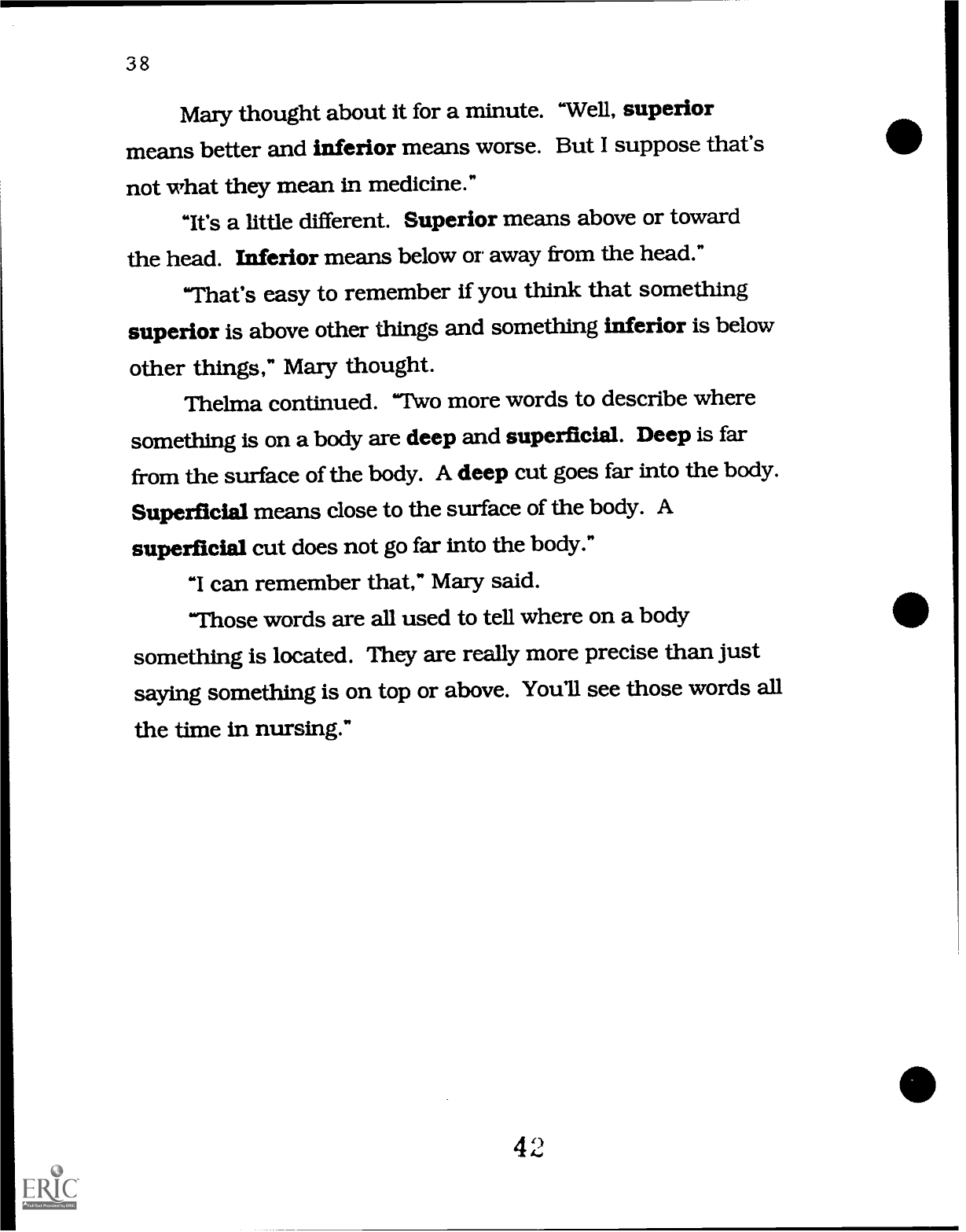
38
Mary thought about it for a minute.
Well, superior
means better and
inferior means worse. But I suppose that's
not what they mean in
medicine."
"It's a little different. Superior means
above or toward
the head. Inferior means below or away
from the head."
'That's easy to remember if you think
that something
superior is above other things and
something inferior is below
other things," Mary thought.
Thelma continued. "Two more words
to describe where
something is on a body are deep and
superficial. Deep is far
from the surface of the body. A deep cut goes
far into the body.
Superficial means close to the surface of
the body. A
superficial cut does not go far into the body."
"I can remember that," Mary said.
"Those words are all used to tell where on a
body
something is located. They are really more precise
than just
saying something is on top or above.
You'll see those words all
the time in nursing."
4 2

39
Here are new combinations:
antefebrile(before + fever) before the beginning of a fever
anterolateral(before + side) in front and on one side
bilateral(two + sides) two sides
cephalopatby(head + disease) any disease of the brain or
head
cephaloplegia(head + paralysis) paralysis of the muscles
about the head
dorsolateral(back + side) having to do with the back and the
side
dorsoventral(back + front) having to do with the back and
front of the body
hemicephalia(half + head) born with half of the brain and
skull
hydrocephalus(water + head) increased fluid in the brain
lateroabdomin.a1(side + belly) having to do with the side of
the body and the abdominal area
macrocephaly(large + head) abnormally large head
microcephaly(small + head) unusually small head
posteroanterior(behind + in front) moving from back to
front
posteroinferior(back + below) located back and below
posterolateral(back + side) located in the back and on the
side
posteromedial(back + middle) located on the back and in the
middle

40
posterosuperior(behind + above) located on
the back and
above
subdorsal(below + back) below the
back
superolateral(above + side) above
and to the side
superomedial(above + middle) above
the middle
41
1
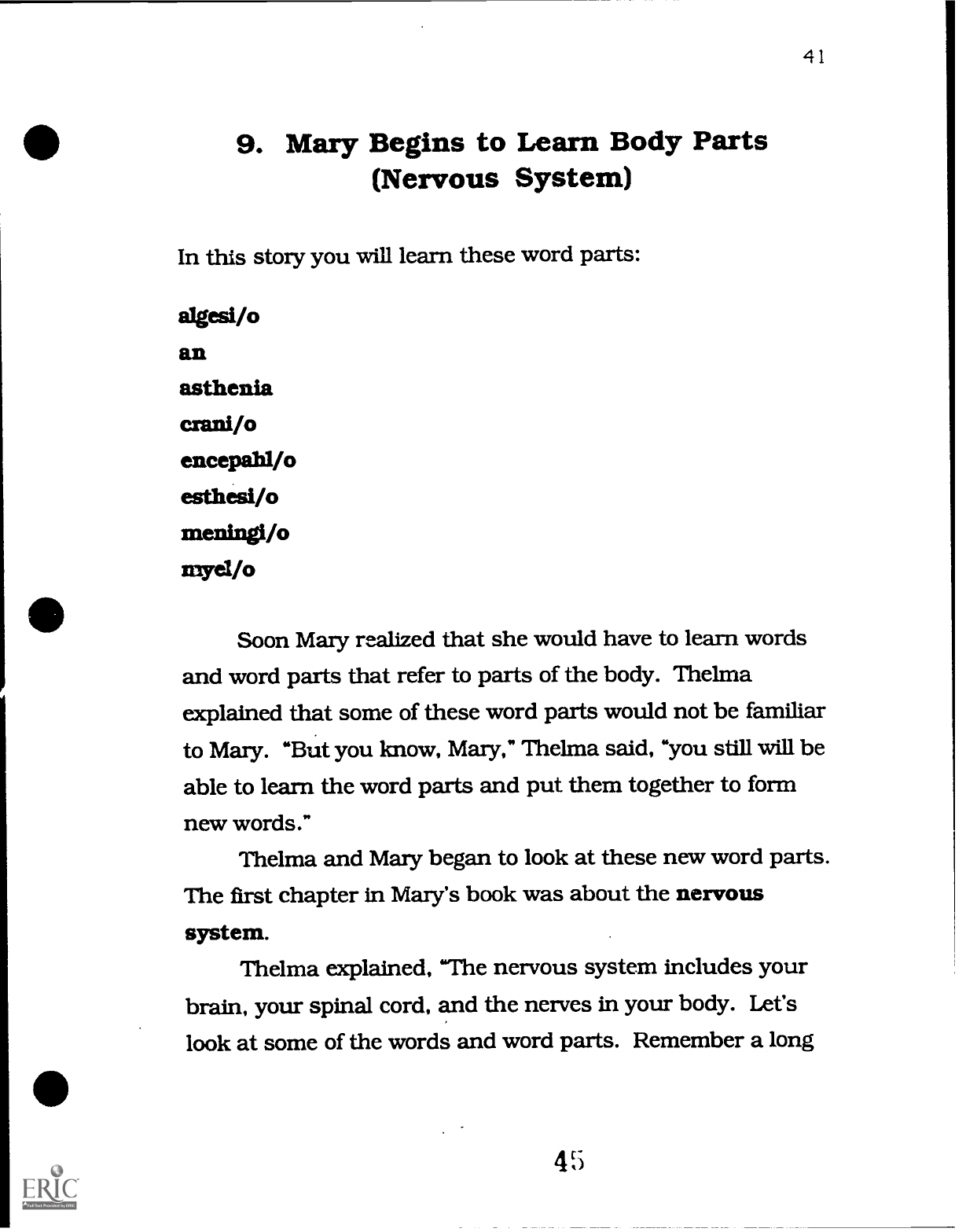
41
0
9. Mary Begins to Learn Body Parts
(Nervous System)
In this story you will learn these word parts:
algesi/o
an
asthenia
crani/o
encepahl/o
esthesi/o
meningi/o
myel/o
Soon Mary realized that she would have to learn words
and word parts that refer to parts of the body. Thelma
explained that some of these word parts would not be familiar
to Mary. "But you know, Mary," Thelma said, "you still will be
able to learn the word parts and put them together to form
new words."
Thelma and Mary began to look at these new word parts.
The first chapter in Mary's book was about the nervous
system.
Thelma explained, "The nervous system includes your
brain, your spinal cord, and the nerves in your body. Let's
look at some of the words and word parts. Remember a long
4`5
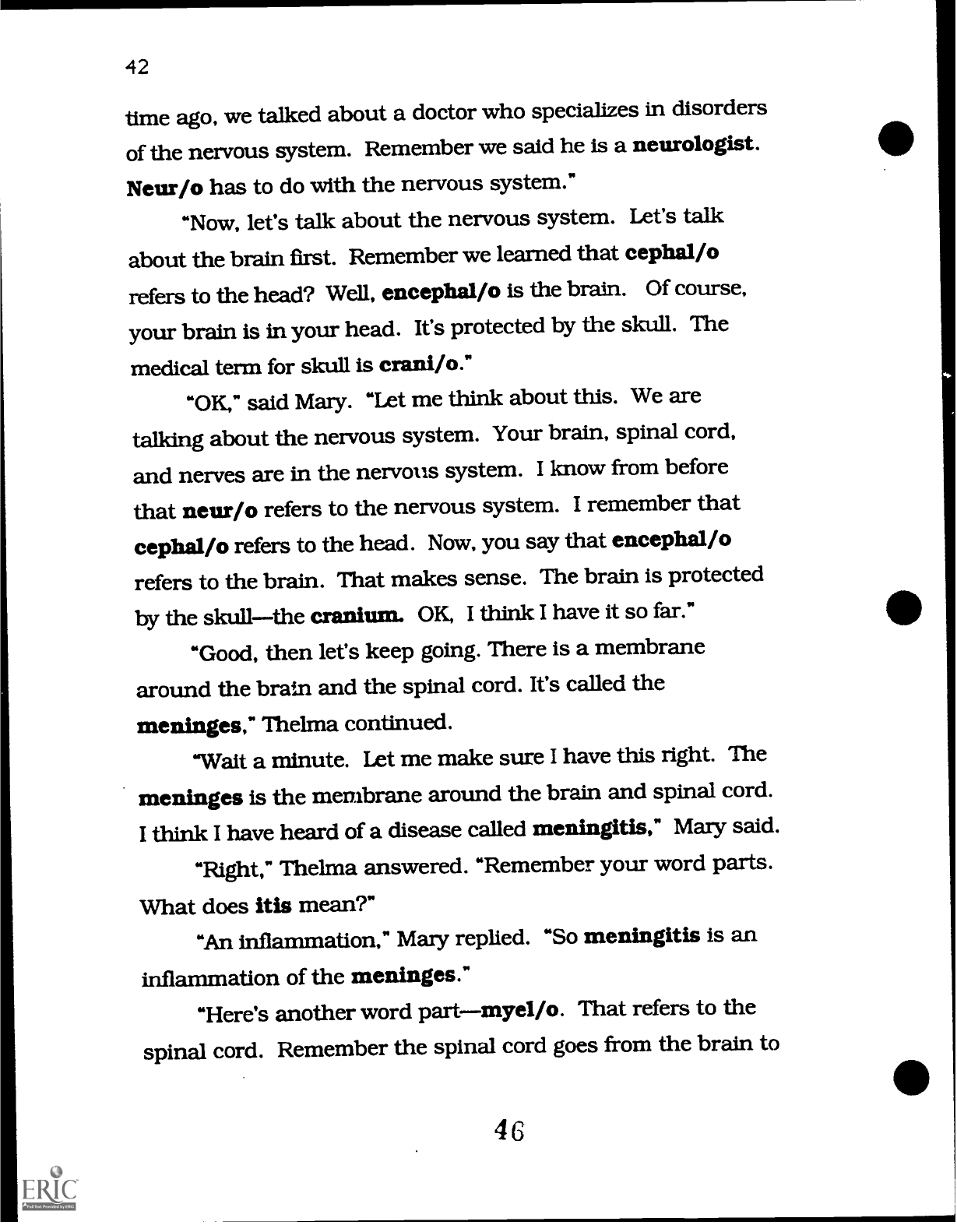
42
time ago, we talked
about a doctor who specializes in
disorders
of the nervous system.
Remember we said he is a neurologist.
Neur/o has to do with the nervous
system."
"Now, let's talk about the nervous
system. Let's talk
about the brain first. Remember we
learned that cephal/o
refers to the head? Well,
encephal/o is the brain. Of course,
your brain is in your
head. It's protected by the
skull. The
medical term for skull is crani/o."
"OK," said Mary. "Let me
think about this. We are
talking about the nervous system.
Your brain, spinal cord,
and nerves are in the nervous
system. I know from before
that neur/o refers to the nervous
system. I remember that
cephal/o refers to the head. Now, you say
that encephal/o
refers to the brain. That makes sense.
The brain is protected
by the skullthe cranium. OK I
think I have it so far."
"Good, then let's keep going. There is a
membrane
around the brain and the spinal
cord. It's called the
meninges," Thelma continued.
"Wait a minute. Let me make sure
I have this right. The
meninges is the membrane around
the brain and spinal cord.
I think I have heard of a
disease called meningitis," Mary said.
"Right," Thelma answered. "Remember your
word parts.
What does itis mean?"
"An inflammation," Mary
replied. "So meningitis is an
inflammation of the meninges."
"Here's another word
partmyel/o. That refers to the
spinal cord. Remember
the spinal cord goes from the brain to
46

43
the lower back. It goes down your spine. Remember
the
vertebrae? They are the bones of your back. They protect
the
spinal cord the way the cranium protects the brain."
I'm going to see if I can remember what you said so far.
The encephal/o refers to the brain. The brain is protected by
the cranium. The myel/o refers to the spinal cord. The
meninges is the membrane covering the spinal cord and the
brain."
"That's it," Thelma said. "Now here is some more
information. Algesi/o or algia is a word part meaning pain.
The pain can be anywhere. Whenever you see a word with
algia in it, it means pain someplace. The prefix an means no,
not, or without. Aspirin is an analgesic. What do you
think
that means?"
Mary was quiet for a minute. "I have to think about this.
If algesi/o means pain and an means without or no, then
analgesic is something to reduce pain. Aspirin does that."
"Good, you're right," said Thelma. "Now think of this.
Esthesi/o means feeling. Not feeling sad or happy, but feeling
with your body. What do you think anesthesia does?"
"Well, anesthesia would mean without feeling. I know
when you have an operation, you get anesthesia so you do
don't feel anything during the operation."
"Good," Thelma said. "You know, sometimes medical
word parts look alike. The word part asthenia is a word part
that means weakness. It looks something like esthesia, but
you know that means
feeling."
1

44
Mary frowned. "I have to be sure to
keep those words
straight. Esthesia means feeling, so
anesthesia is without
feeling. Asthenia means wealmess.
Here are new combinations:
abdominalgia(belly + pain) pain in the belly
algesimeter (pain + measure) an instrument
for measuring
sensitivity to pain
analgesia(without + pain) absence of pain
analgesic(without + pain) something that
relieves pain
anencephalus (without + brain ) a baby
born without a brain
and spinal cord
anesthesia(without + sensation) loss of sensation or
feeling
with or without loss of consciousness
anesthesiologist(without + sensation + specialist) a
physician who specializes in anesthesia
anesthetist(without + sensation + specialist) a person
who
gives anesthesia, may be a doctor or a nurse
anhydrous(without + water) lacking of water
anodontia(without + teeth) loss of teeth
anophthalmia(without + eyes) born with one or both eyes
missing
antineuraigic(against + nerve + pain) relieving neuralgia
(pain along a nerve)
appendalgia(appendix + pain) pain in the lower right
quadrant or quarter of the abdomen, where
the appendix
is located
48
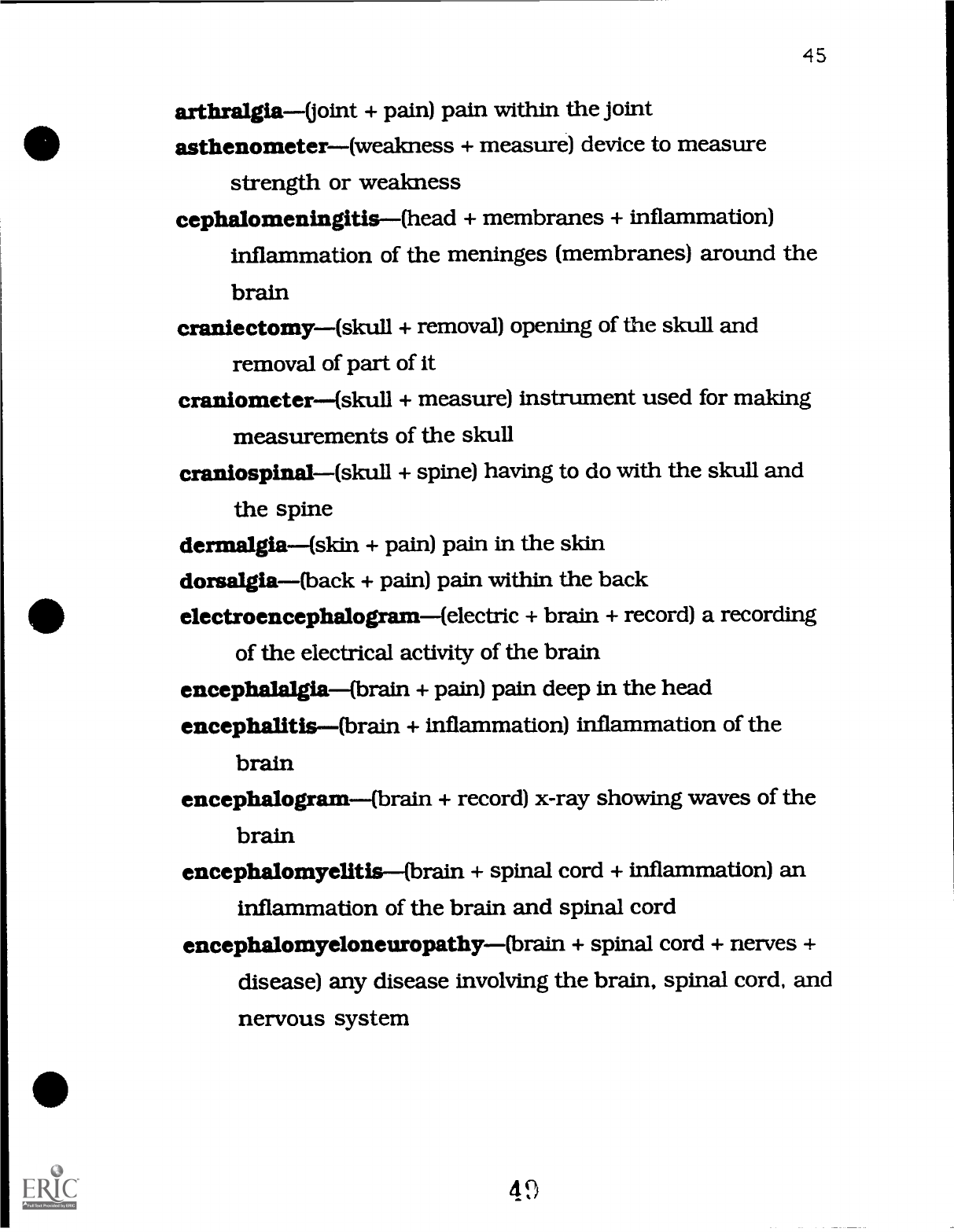
45
arthralgiaOoint + pain) pain within the joint
asthenometer(weakness + measure) device to measure
strength or weakness
cephalomeningitis(head + membranes + inflammation)
inflammation of the meninges (membranes) around the
brain
craniectomy(skull + removal) opening of the skull and
removal of part of it
craniomcter (skull + measure) instrument used for making
measurements of the skull
craniospinal(skull + spine) having to do with the skull and
the spine
dermalgia--(skin. + pain) pain in the skin
dorsalgia(back + pain) pain within the back
electroencephalogram(electric + brain + record) a recording
of the electrical activity of the brain
encephalalgia--(brain + pain) pain deep in the head
encephalitis(brain + inflammation) inflammation of the
brain
encephalogram(brain + record) x-ray showing waves of the
brain
encephalomyelitis(brain + spinal cord + inflammation) an
inflammation of the brain and spinal cord
encephalomyeloneuropathy(brain + spinal cord + nerves +
disease) any disease involving the brain, spinal cord, and
nervous system
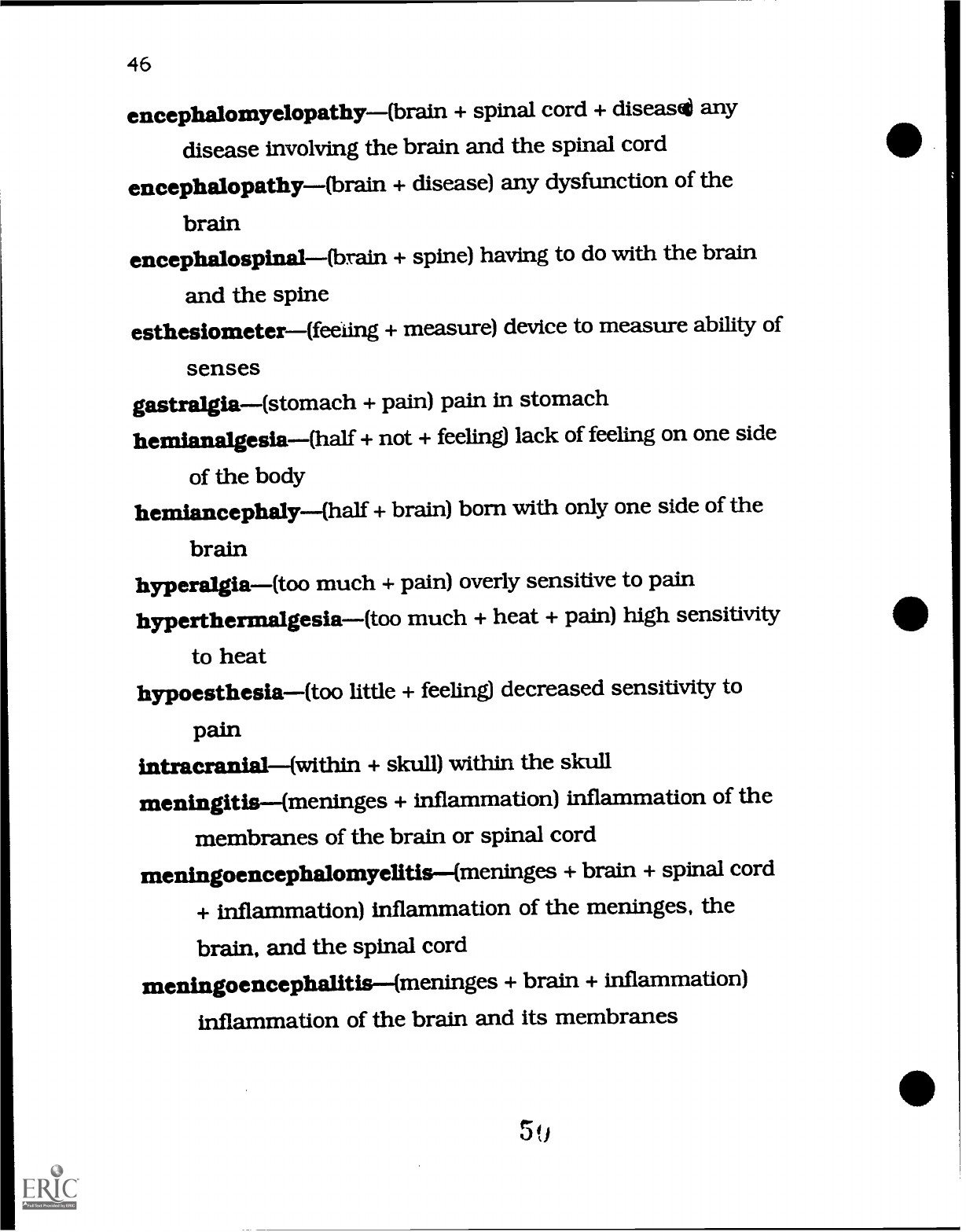
46
encephalomyelopathy(brain. + spinal cord +
diseasoi any
disease involving the brain and
the spinal cord
encephalopathy(brain + disease) any
dysfunction of the
brain
encephalospinal(brain + spine) having to do
with the brain
and the spine
esthesiometer(feeling + measure) device to measure
ability of
senses
gastralgia(stomach + pain) pain in
stomach
hemianalgesia(half + not + feeling) lack
of feeling on one side
of the body
hemiancephaly(half + brain) born with only one
side of the
brain
hyperalgia(too much + pain) overly sensitive to
pain
hyperthermalgesia(too much + heat + pain)
high sensitivity
to heat
hypoesthesia(too little + feeling) decreased
sensitivity to
pain
intracranial(within + skull) within the skull
meningitis(meninges + inflammation) inflammation
of the
membranes of the brain or spinal cord
meningoencephalomyelitis (meninges + brain +
spinal cord
+ inflammation)
inflammation of the meninges, the
brain, and the spinal cord
meningoencephalitis(meninges + brain +
inflammation)
inflammation of the brain and its membranes

47
meningomyelitis(meninges + spinal cord + inflammation)
inflammation of the meninges and the spinal cord
myelaigia(spinal cord + pain) pain in the spinal cord
myelitis(spinal cord + inflammation) inflammation of the
spinal cord
myeloencephalic(spinal cord + brain) having to do with the
spinal cord and the brain
myelogram(spinal cord + record) x-ray of the spine after dye
has been injected
myeloneuritis(spinal cord + nerve + inflammation)
inflammation of the spinal cord and the nerves
myelopathy(spinal cord + disease) disease of the spinal cord
nephralgia(kidney + pain) pain in the kidney
neuralgia(nerve + pain) pain along the nerve
neurocranium(nerve + skull) the part of the skull where the
brain is enclosed
neuromyelitis(nerve + spinal cord + inflammation)
inflammation of the nerves and the spinal cord
ophthsalirmigia(eye + pain) pain in the eye
polyneuralgia(many + nerve + pain) pain in several nerves
postanesthetic(after + not + feeling) time after anesthesia
postencephalitis(after + brain + inflammation) period of
time after encephalitis
pseudesthesia(false + feeling) a false sensation such as
feeling a leg after it has been amputated
subcranial(below + skull) beneath or below the skull
thermalgesia(heat + pain) pain caused by heat
5
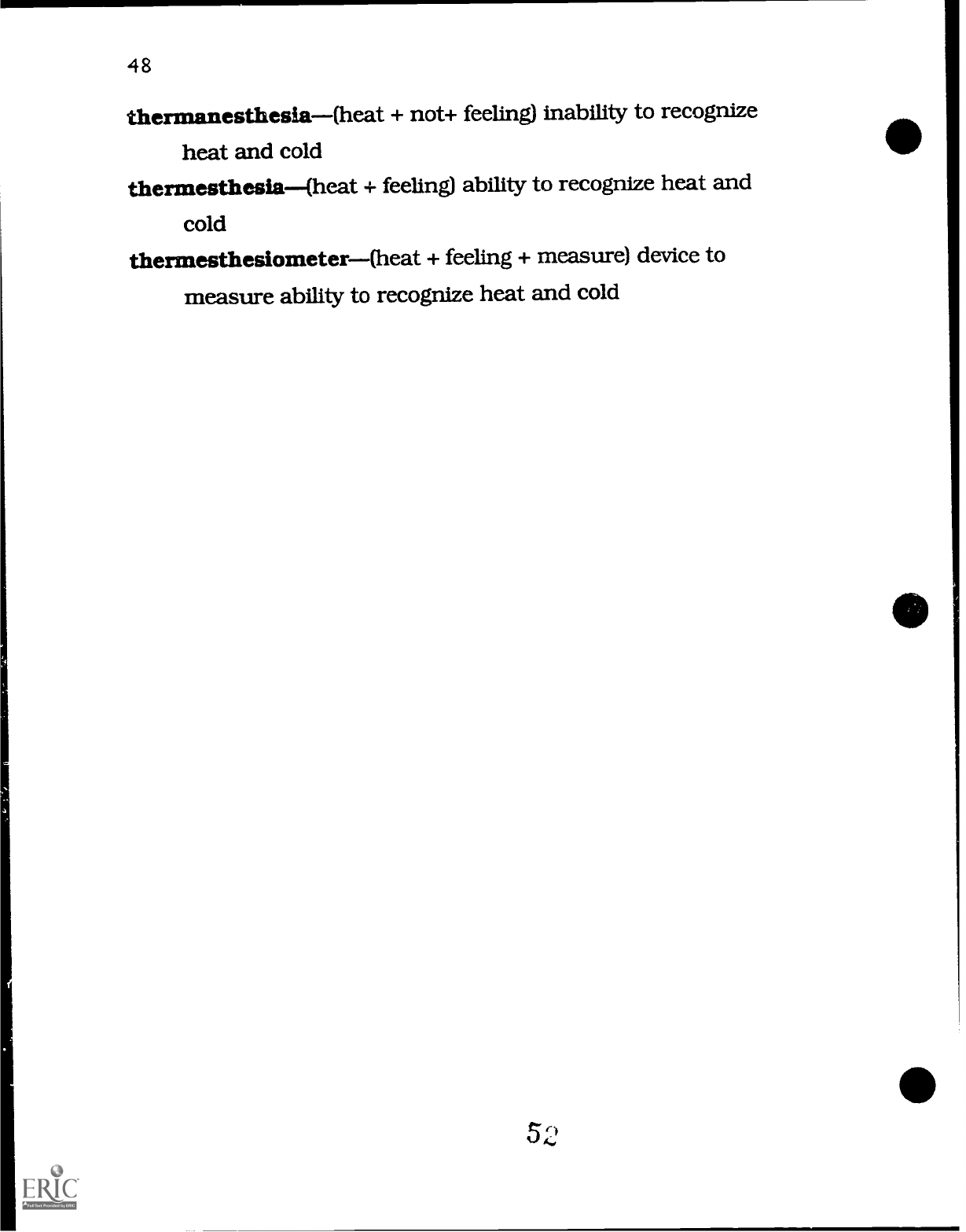
48
thermanesthesia(heat + not+ feeling) inability to recognize
heat and cold
thermesthesia(heat + feeling) ability to recognize
heat and
cold
thermesthesiometer(heat + feeling + measure) device to
measure ability to recognize
heat and cold
52
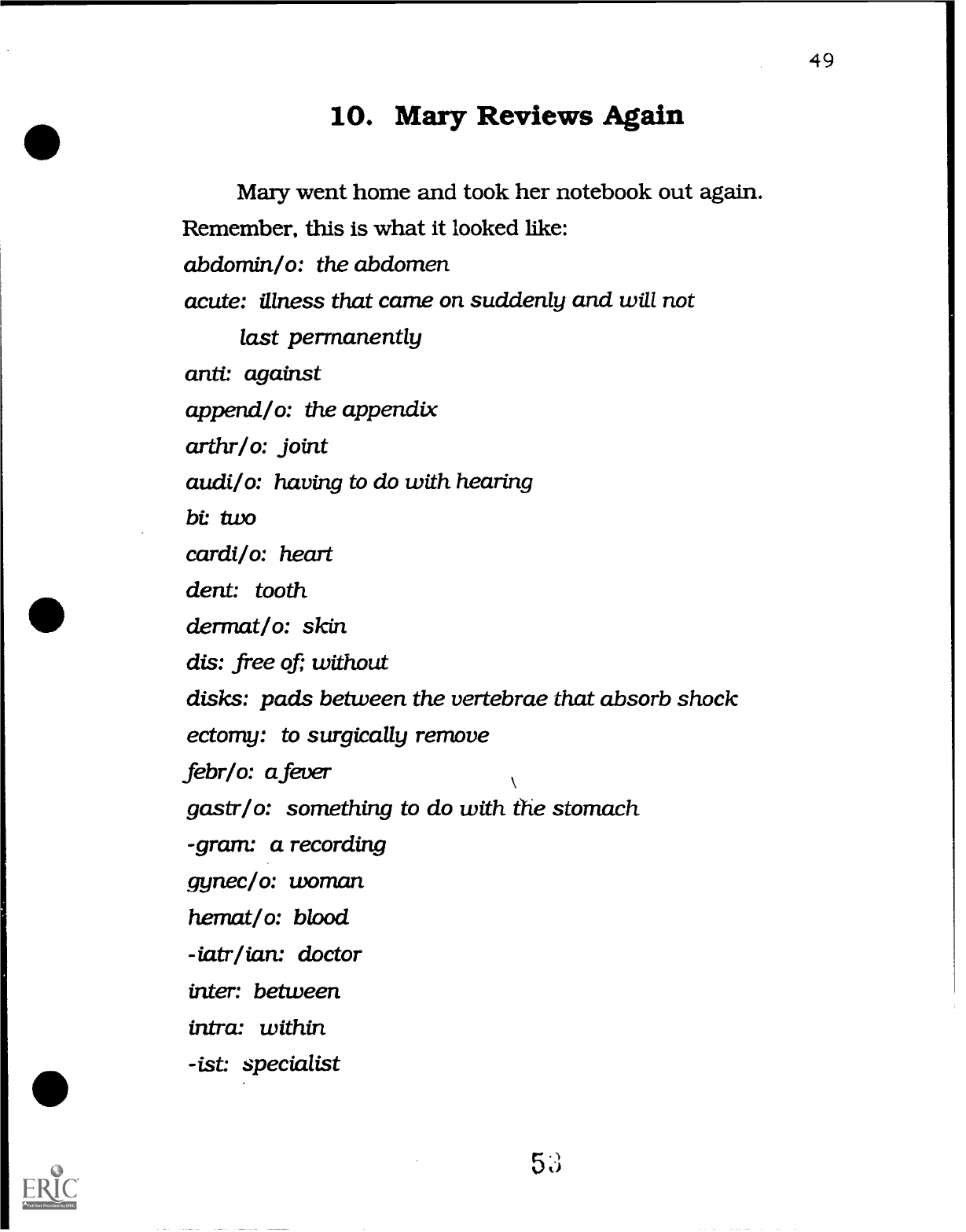
10. Mary Reviews Again
Mary went home and took her notebook out again.
Remember, this is what it looked like:
abdomin/o: the abdomen
acute: illness that came on suddenly and will not
last permanently
anti: against
append/ o: the appendix
arthr/o: joint
audi/o: having to do with hearing
bi: two
cardi/o: heart
dent: tooth
dermat/o: skin
dis: free of; without
disks: pads between the vertebrae that absorb shock
ectomy: to surgically remove
febr/o: afever
gastr/o: something to do with the stomach
-gram: a recording
gynec/o: woman
hemat/o: blood
-iatr/ian: doctor
inter: between
intro: within
-ist: specialist
49
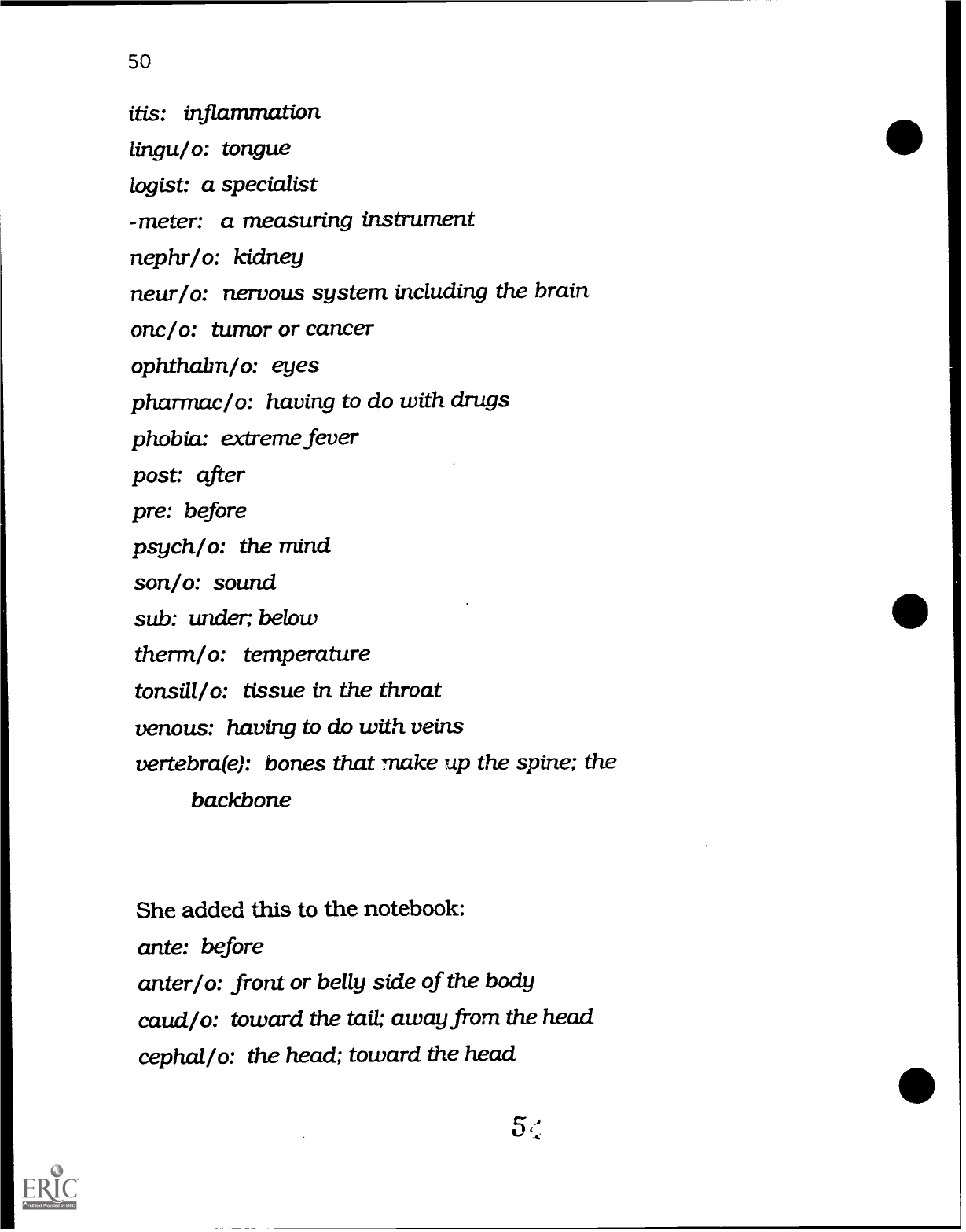
50
itis: inflammation
lingo /o: tongue
logist: a specialist
-meter: a measuring instrument
nephr/ o: kidney
neur/o: nervous system including the brain
one /o: tumor or cancer
ophthahn/o: eyes
pharmac /o: having to do with drugs
phobia: extreme fever
post: after
pre: before
psych/ o: the mind
son/ o: sound
sub: under; below
therm/ o: temperature
tonsill/ o: tissue in the throat
venous: having to do with veins
vertebra(e): bones that make up the spine; the
backbone
She added this to the notebook:
ante: before
anter/o: front or belly side of the body
caud/o: toward the tail; away from the head
cephal/ o: the head; toward the head
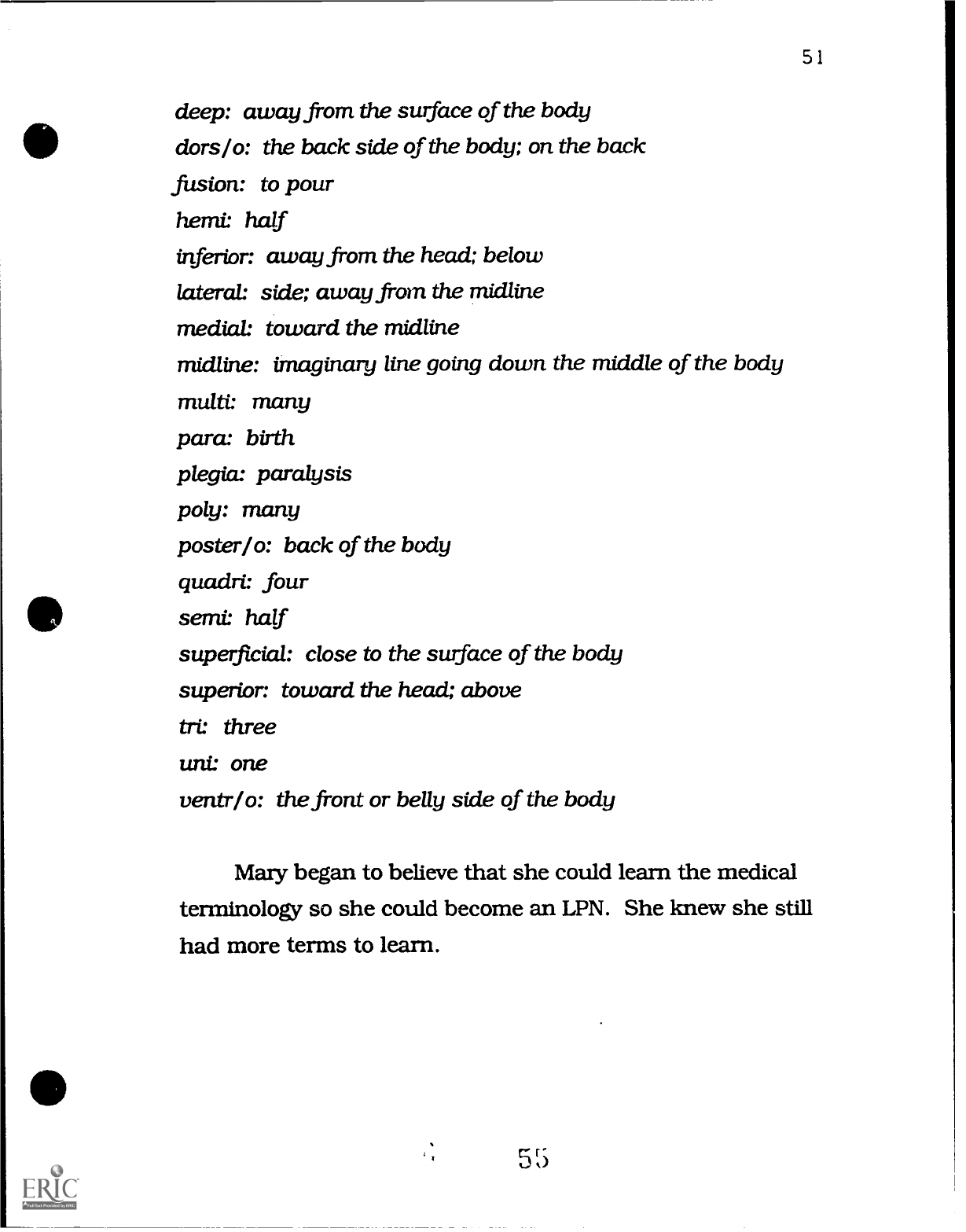
51
deep: away from the surface of the body
dors / o: the back side of the body; on the back
fusion: to pour
hemi: half
inferior: away from the head; below
Lateral: side; away from the midline
medial: toward the midline
midline: imaginary line going down the middle of the body
multi: many
pars: birth
plegia: paralysis
poly: many
poster/ o: back of the body
quadri: four
semi: half
superficial: close to the surface of the body
superior: toward the head; above
tri: three
uni: one
ventr/ o: the front or belly side of the body
Mary began to believe that she could learn the medical
terminology so she could become an LPN. She knew she still
had more terms to learn.
55

52
11. Mary Knows More Body Parts
In this story you will learn the following word parts:
hepa/to
hyster/o
mast/o
ot/o
pod/o
pulmon/o
thin/a
Mary finished her first course at the community college
and did very well. She couldn't believe that she actually earned
an "A" in the medical terminology. Her new course was
anatomystudying the body, its parts, and structure. She
learned where different body parts are and the word parts
that are used to represent the parts.
Mary learned that the liver is a very important part of
the body. Mary talked to Thelma about what she had learned.
"I know that the word part hep/a or hepat/o has
something to do with the liver. Hepatitis is a disease. It means
inflammation of the liver.
Thelma laughed. "You know, Mary, I remember when
you didn't think you would be
able to do this. Now you can
teach me the body parts and the words for them. Try this
onewhat does pubnon/o mean?"
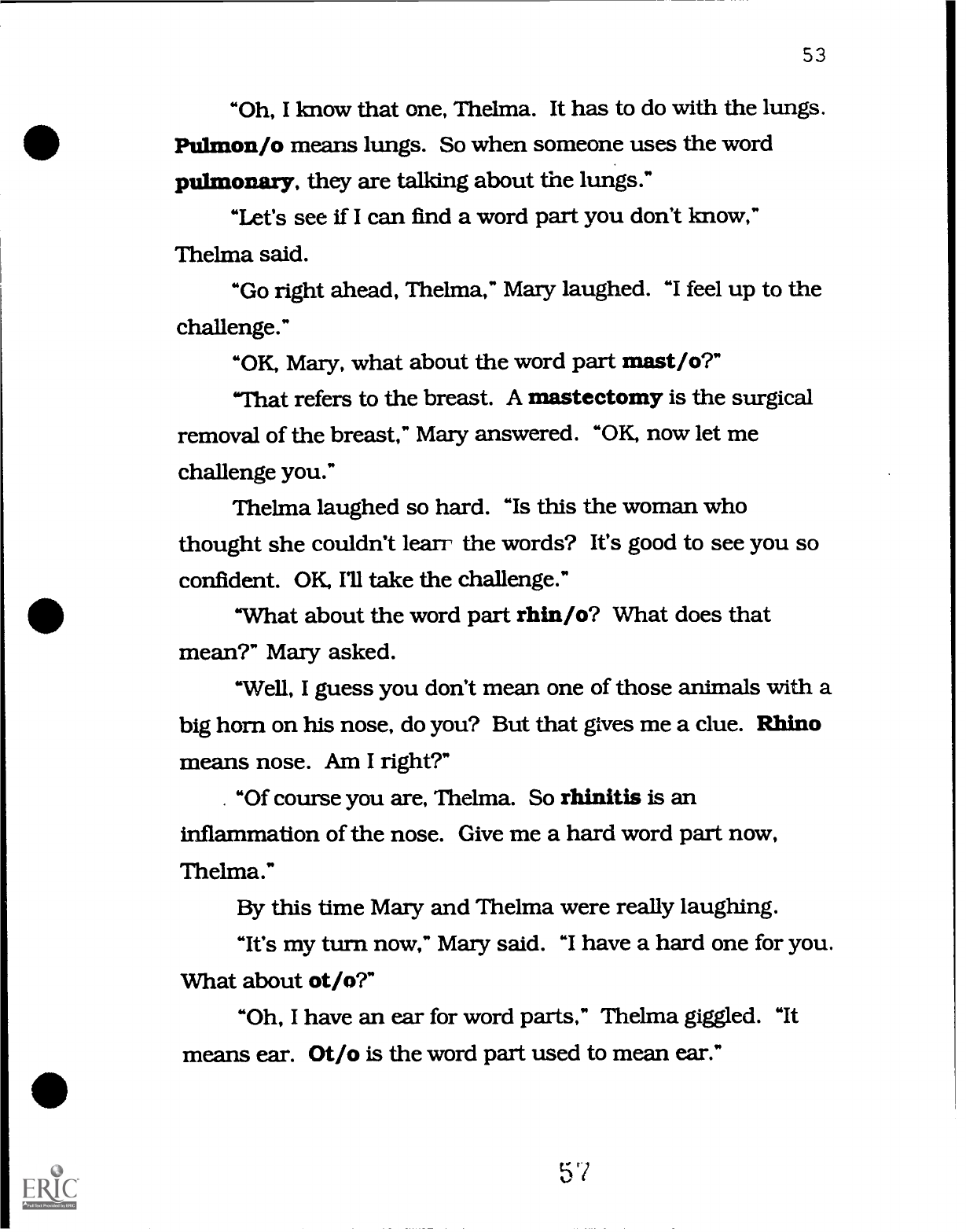
53
"Oh, I know that one, Thelma. It has to do with the lungs.
Pulmon/o means lungs. So when someone uses the word
pulmonary, they are talking about the lungs."
"Let's see if I can find a word part you don't know,"
Thelma said.
"Go right ahead, Thelma," Mary laughed. "I feel up to the
challenge."
"OK, Mary, what about the word part mast/o?"
"Mat refers to the breast. A mastectomy is the surgical
removal of the breast," Mary answered. "OK, now let me
challenge you."
Thelma laughed so hard. "Is this the woman who
thought she couldn't learn the words? It's good to see you so
confident. OK., I'll take the challenge."
"What about the word part rhln /o? What does that
mean?" Mary asked.
"Well, I guess you don't mean one of those animals with a
big horn on his nose, do you? But that gives me a clue. Rhino
means nose. Am I right?"
"Of course you are, Thelma. So rhinitis is an
inflammation of the nose. Give me a hard word part now,
Thelma."
By this time Mary and Thelma were really laughing.
"It's my turn now," Mary said. "I have a hard one for you.
What about of /o ?"
"Oh, I have an ear for word parts," Thelma giggled. "It
means ear. Ot/o is the word part used to mean ear."
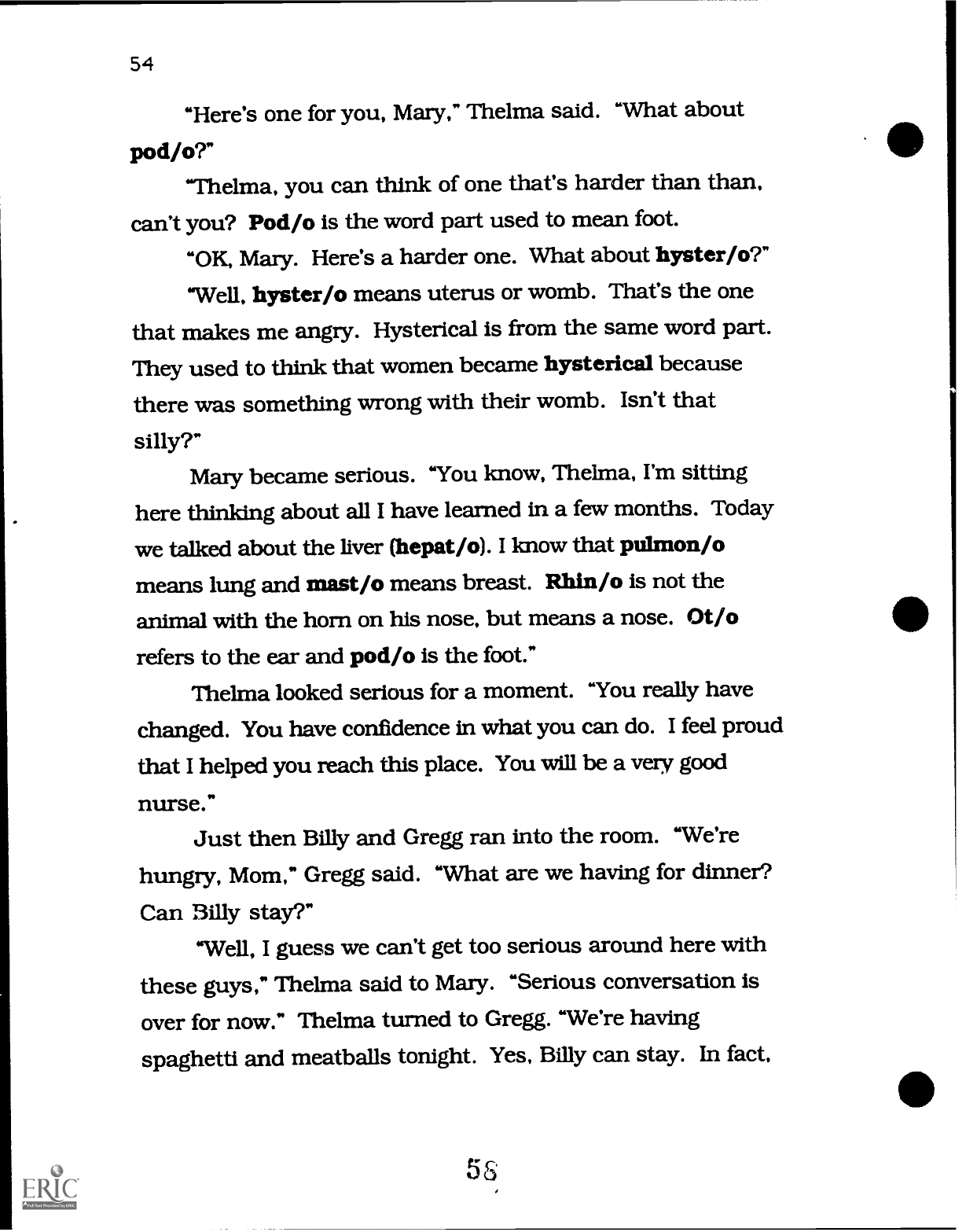
54
"Here's one for you, Mary," Thelma said.
"What about
pod/o?"
"Thelma, you can think of one that's harder than
than,
can't you? Pod/o is the word part used to mean
foot.
"OK, Mary. Here's a harder one. What about
hyster/o?"
"Well, hyster/o means uterus or womb. That's the one
that makes me angry. Hysterical is from
the same word part.
They used to think that women became
hysterical because
there was something wrong with their
womb. Isn't that
silly?"
Mary became serious. "You know,
Thelma, I'm sitting
here thinking about all I have learned in a
few months. Today
we talked about the liver
(hepat/o). I know that pulmon/o
means lung and mast/o means
breast. Rhin/o is not the
animal with the horn on his nose, but means a nose.
Ot/o
refers to the ear and pod/o is the foot."
Thelma looked serious for a moment. "You really have
changed. You have confidence in what you can do. I feel proud
that I helped you reach this place. You will be a very good
nurse."
Just then Billy and Gregg ran into the room. "We're
hungry, Mom," Gregg said. "What are we having for dinner?
Can Billy stay?"
"Well, I guess we can't get too serious around here with
these guys," Thelma said to Mary. "Serious conversation is
over for now." Thelma
turned to Gregg. "We're having
spaghetti and meatballs tonight. Yes, Billy can stay.
In fact,
58
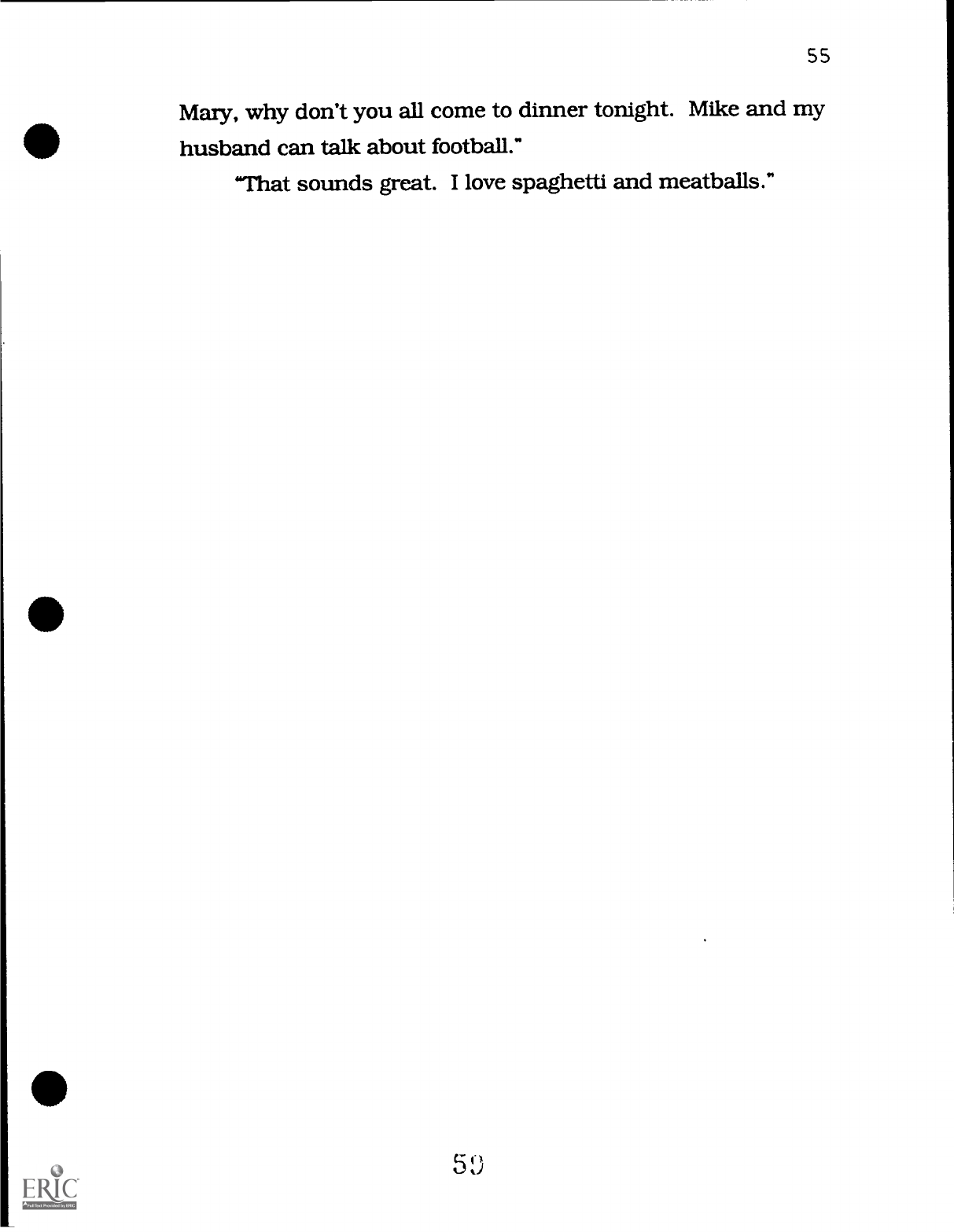
55
Mary, why don't you all come to dinner tonight. Mike and my
husband can talk about football."
`That sounds great. I love spaghetti and meatballs."
51)
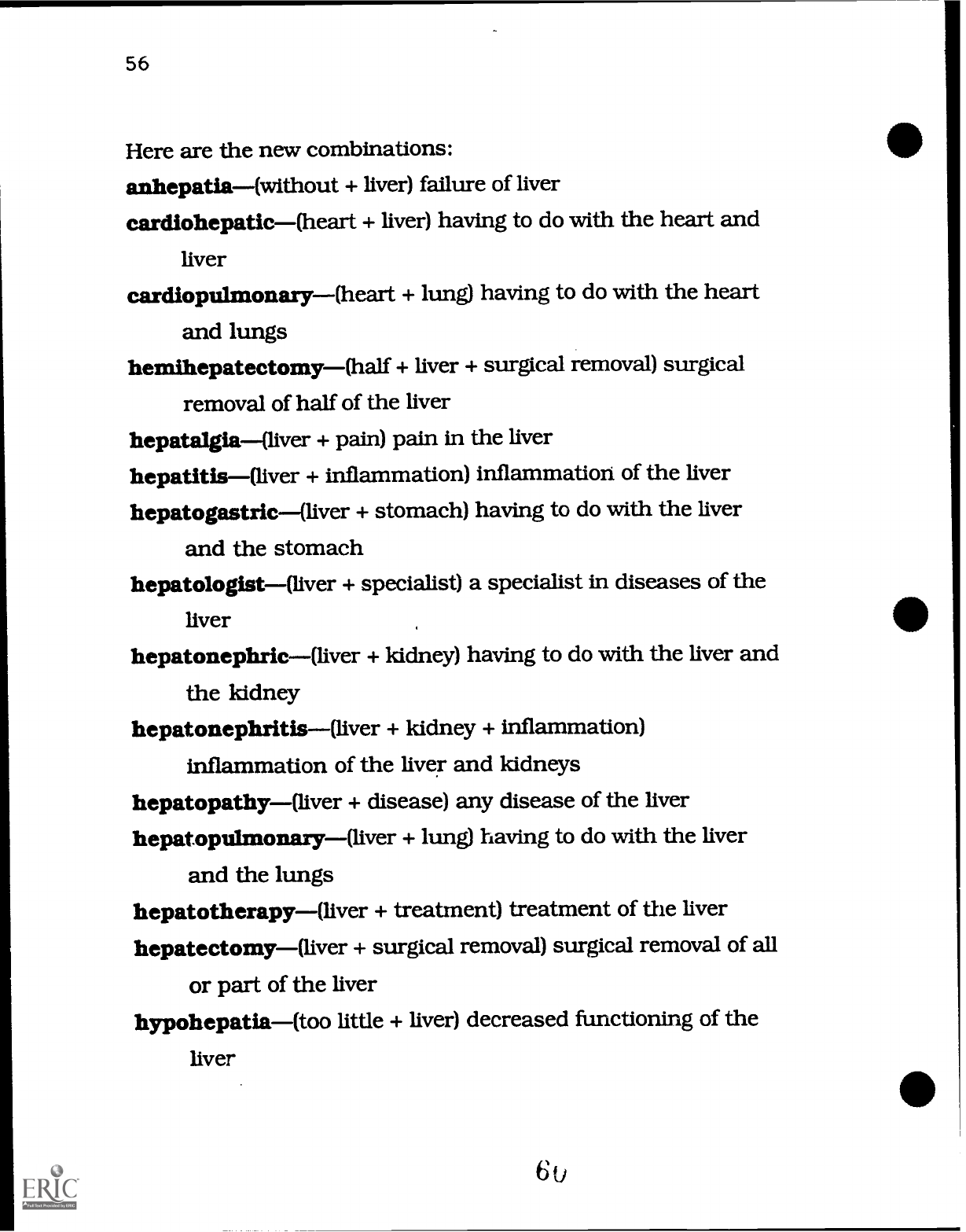
56
Here are the new combinations:
anhepatia(without + liver) failure of liver
cardiohepatic(heart + liver) having to do with the heart and
liver
cardiopulmonary(heart + lung) having to do with the heart
and lungs
hemihepatectomy(half + liver + surgical removal) surgical
removal of half of the liver
hepatalgia (liver + pain) pain in the liver
hepatitis
(liver + inflammation) inflammation of the liver
hepatogastric (liver + stomach) having to do with the liver
and the stomach
hepatologistfliver + specialist) a specialist in diseases of the
liver
hepatonephric(iver + kidney) having to do with the liver and
the kidney
hepatonephritis(liver + kidney + inflammation)
inflammation of the liver and kidneys
hepatopathy
(liver + disease) any disease of the liver
hepatopulmonary(liver + lung) having to do with the liver
and the lungs
hepatotherapy(liver + treatment) treatment of the liver
hepatectomy(liver + surgical removal) surgical removal of all
or part of the liver
hypohepatia(too little + liver) decreased functioning of the
liver
6 u
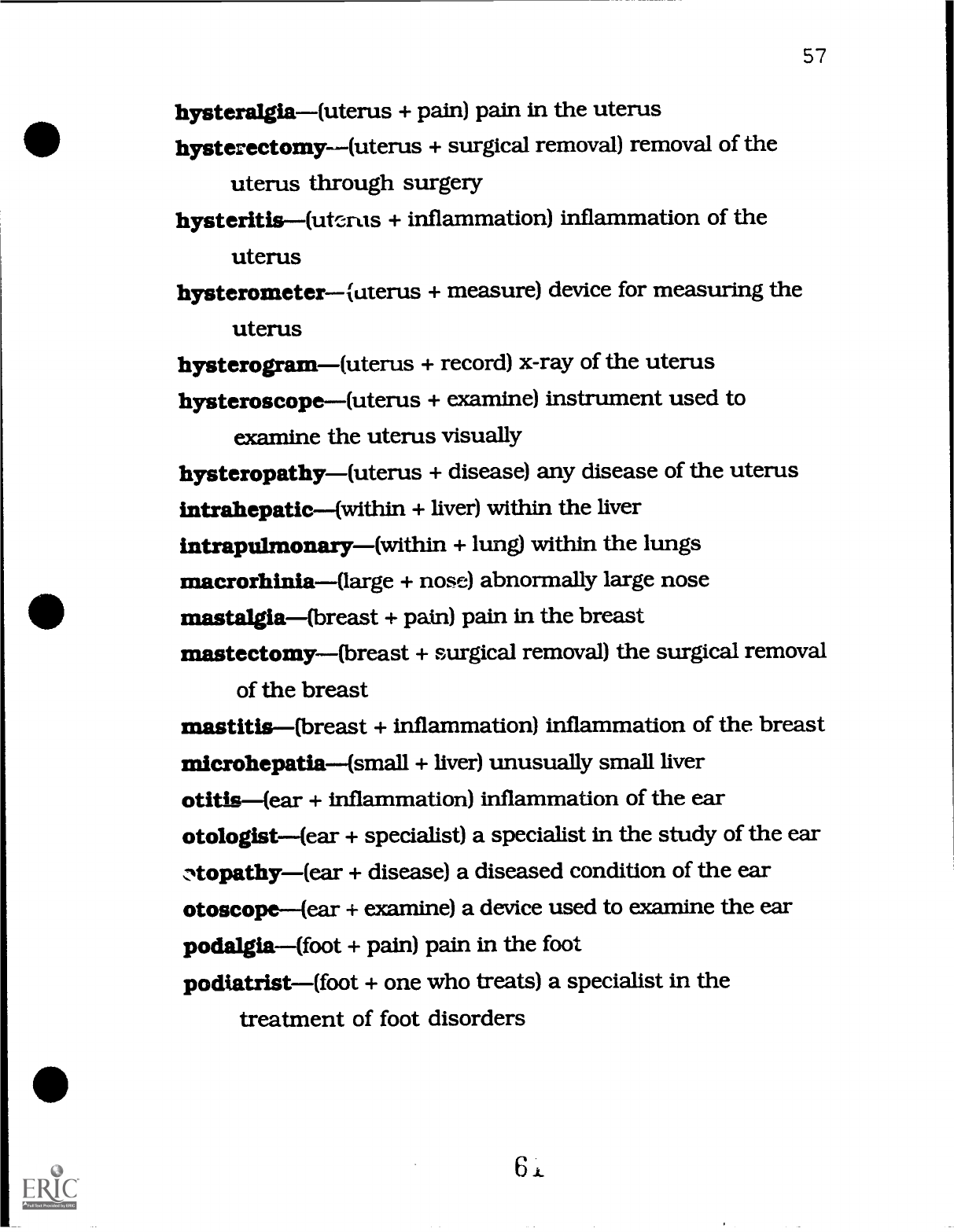
57
hysteralgia(uterus + pain) pain in the uterus
hysterectomy(uterus + surgical removal) removal of the
uterus through surgery
hysteritis(utcxus + inflammation) inflammation of the
uterus
hysterometer (uterus + measure) device for measuring the
uterus
hysterogram (uterus + record) x-ray of the uterus
hysteroscope(uterus + examine) instrument used to
examine the uterus visually
hysteropathy(uterus + disease) any disease of the uterus
intrahepatic(within + liver) within the liver
intrapulmonary(within + lung) within the lungs
macrorhinia(large + nose) abnormally large nose
mastalgia(breast + pain) pain in the breast
mastectomy(breast + surgical removal) the surgical removal
of the breast
mastitis(breast + inflammation) inflammation of the breast
microhepatia(small + liver) unusually small liver
otitis(ear + inflammation) inflammation of the ear
otologist(ear + specialist) a specialist in the study of the ear
ztopathy(ear + disease) a diseased condition of the ear
otoscope(ear + examine) a device used to examine the ear
podalgia(foot + pain) pain in the foot
podiatlist(foot + one who treats) a specialist in the
treatment of foot disorders
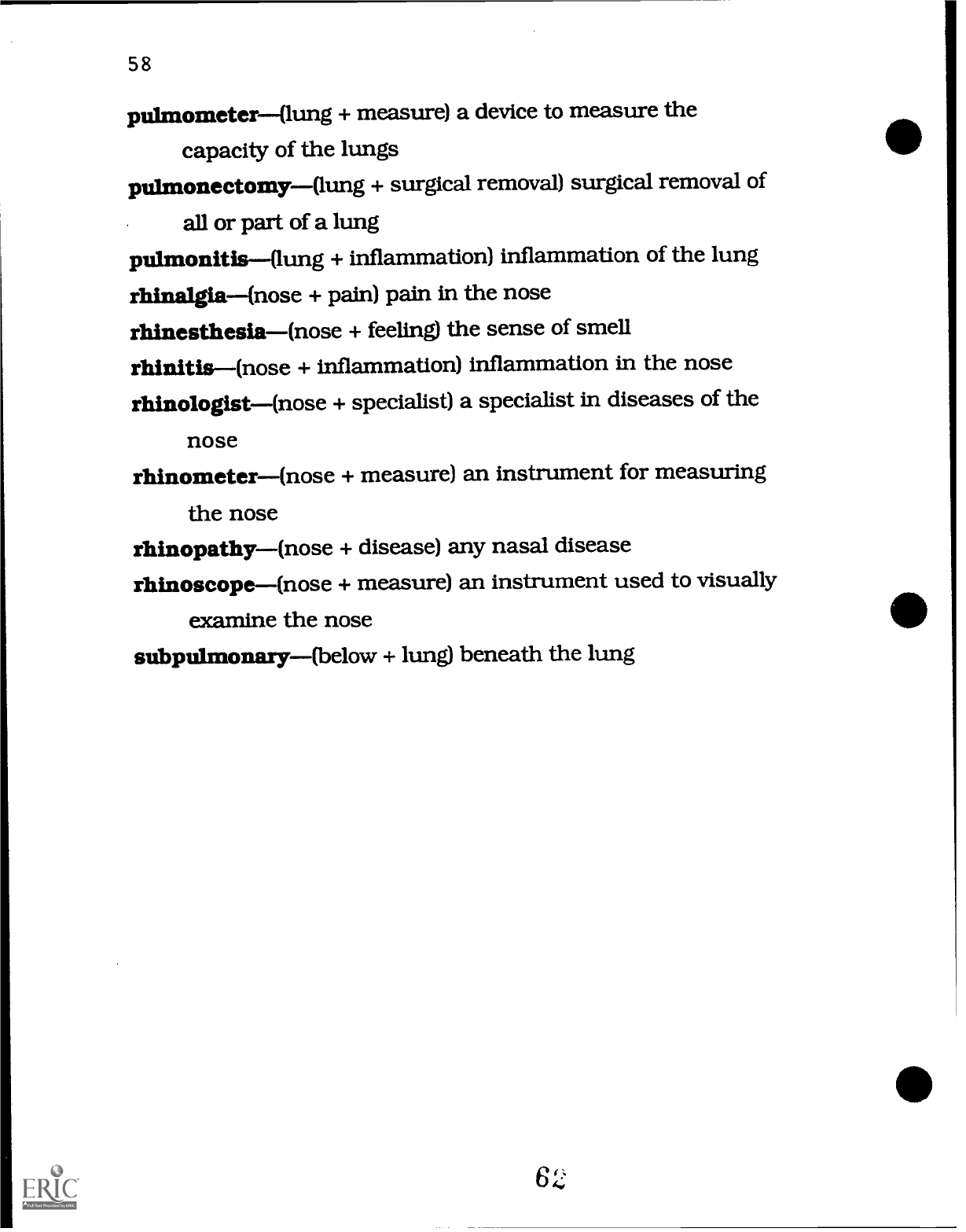
58
pulmometer (lung + measure) a device to measure
the
capacity of the lungs
pulmonectomy(lung + surgical removal) surgical
removal of
all or part of a lung
puhnonitis--(lung + inflammation) inflammation
of the lung
rhinalgia(nose + pain) pain in the nose
rhinesthesia(nose + feeling) the sense of smell
rhinitis(nose + inflammation) inflammation in the nose
rhinologist(nose + specialist) a specialist in diseases
of the
nose
rhin.ometer(nose + measure) an instrument for measuring
the nose
rhinopathy(nose + disease) any nasal disease
rhinoseope(nose + measure) an instrument used to visually
examine the nose
subpulmonary(below + lung) beneath the lung
ti
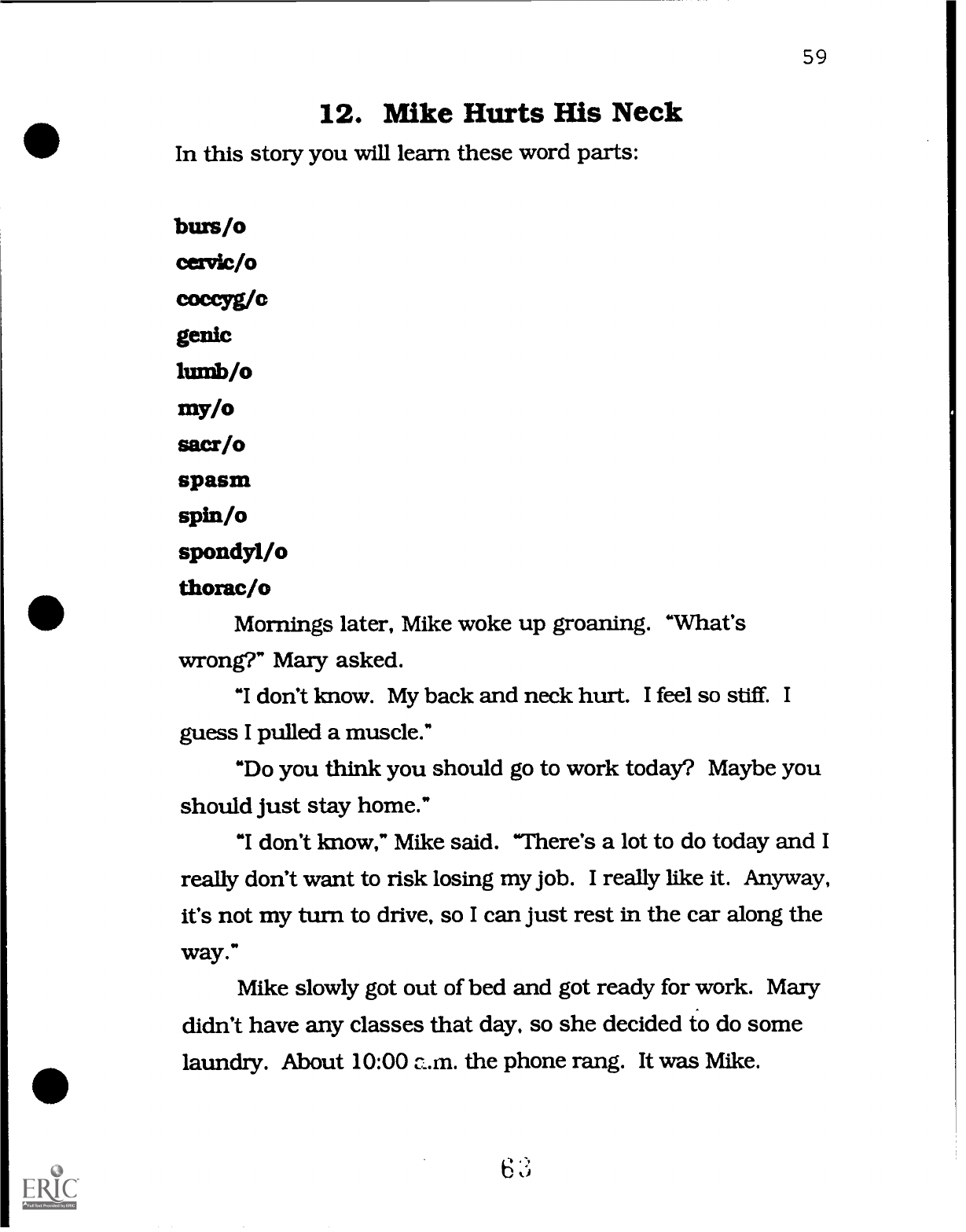
59
12. Mike Hurts His Neck
In this story you will learn these word parts:
burs/o
cervic/o
coccyg/o
genic
lumb/o
my/o
sacr/o
spasm
spin/o
spondyl/o
thorac/o
Mornings later, Mike woke up groaning. "What's
wrong?" Mary asked.
"I don't know. My back and neck hurt. I feel so stiff.
I
guess I pulled a muscle."
"Do you think you should go to work today? Maybe you
should just stay home."
"I don't know," Mike said. "There's a lot to do today and I
really don't want to risk losing my job. I really like it. Anyway,
it's not my turn to drive, so I can just rest in the car along the
way."
Mike slowly got out of bed and got ready for work. Mary
didn't have any classes that day, so she decided to do some
laundry. About 10:00 L.m. the phone rang. It was Mike.
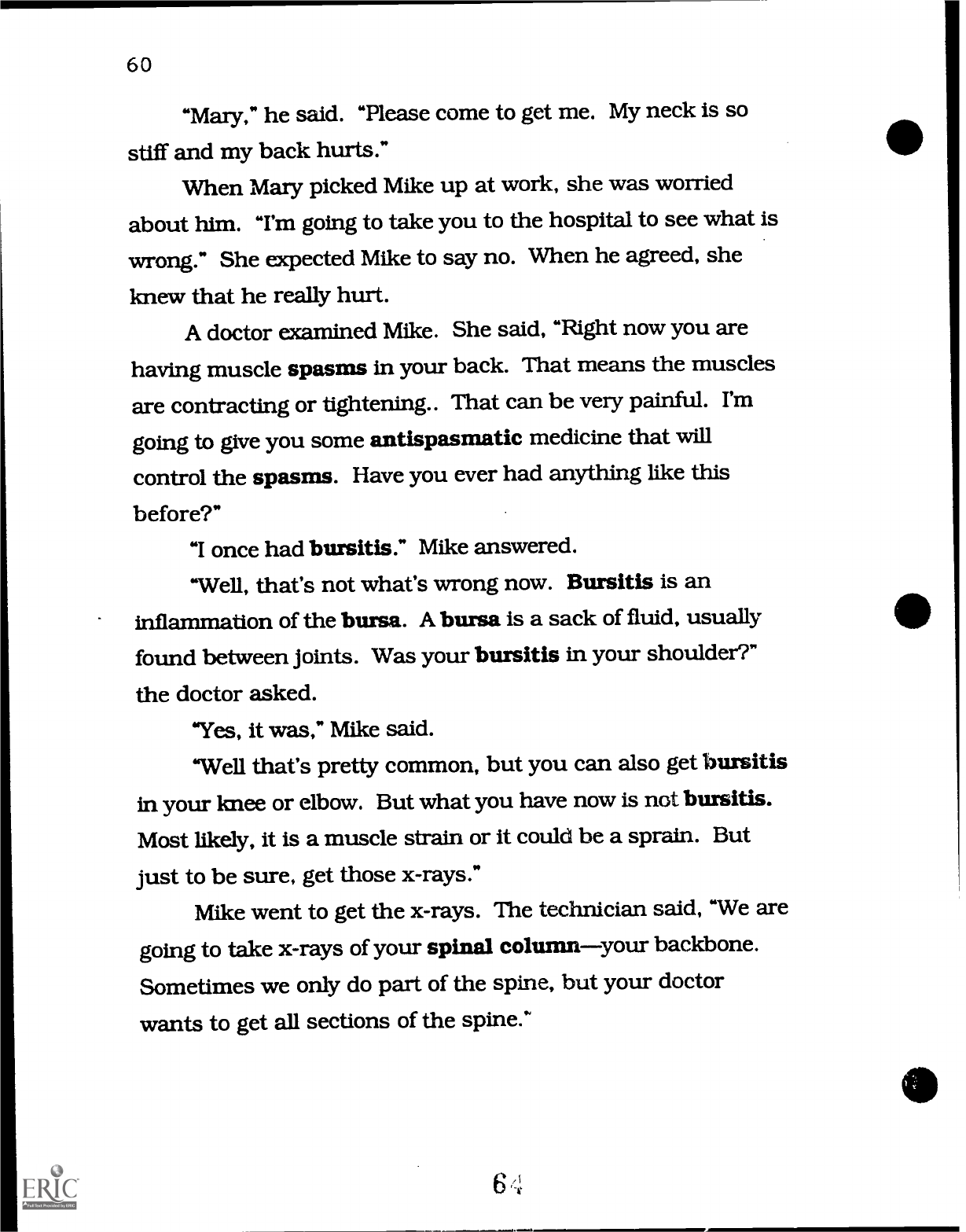
60
"Mary," he said. "Please come to get me. My
neck is so
stiff and my back hurts."
When Mary picked Mike up at work, she was
worried
about him. "I'm going to take you to
the hospital to see what is
wrong." She expected Mike to say no.
When he agreed, she
knew that he really hurt.
A doctor examined Mike. She said,
"Right now you are
having muscle spasms in your back.
That means the muscles
are contracting or tightening..
That can be very painful. I'm
going to give you some antispasmatic
medicine that will
control the spasms. Have you ever had
anything like this
before?"
"I once had bursitis." Mike answered.
"Well, that's not what's wrong now. Bursitis is an
inflammation of the bursa. A bursa is a sack of fluid,
usually
found between joints. Was your bursitis in your
shoulder?"
the doctor asked.
"Yes, it was," Mike said.
"Well that's pretty common, but you can also get
bursitis
in your knee or elbow. But what you have now
is not bursitis.
Most likely, it is a muscle strain or it could be a sprain.
But
just to be sure, get those x-rays."
Mike went to get the x-rays. The technician said,
"We are
going to take x-rays of your spinal
columnyour backbone.
Sometimes we only do part of the spine, but your
doctor
wants to get all sections of the spine."
6,

A week later, Mike and Mary went back to see Dr.
Lehman. She showed them this drawing.
cervical vertebrae
(cervic/o)
thoracic vertebrae
(thorac/o)
lumbar vertebrae
(lumb/o)
SOW=
(sacr/o)
coccyx
(coccyg/o)
61
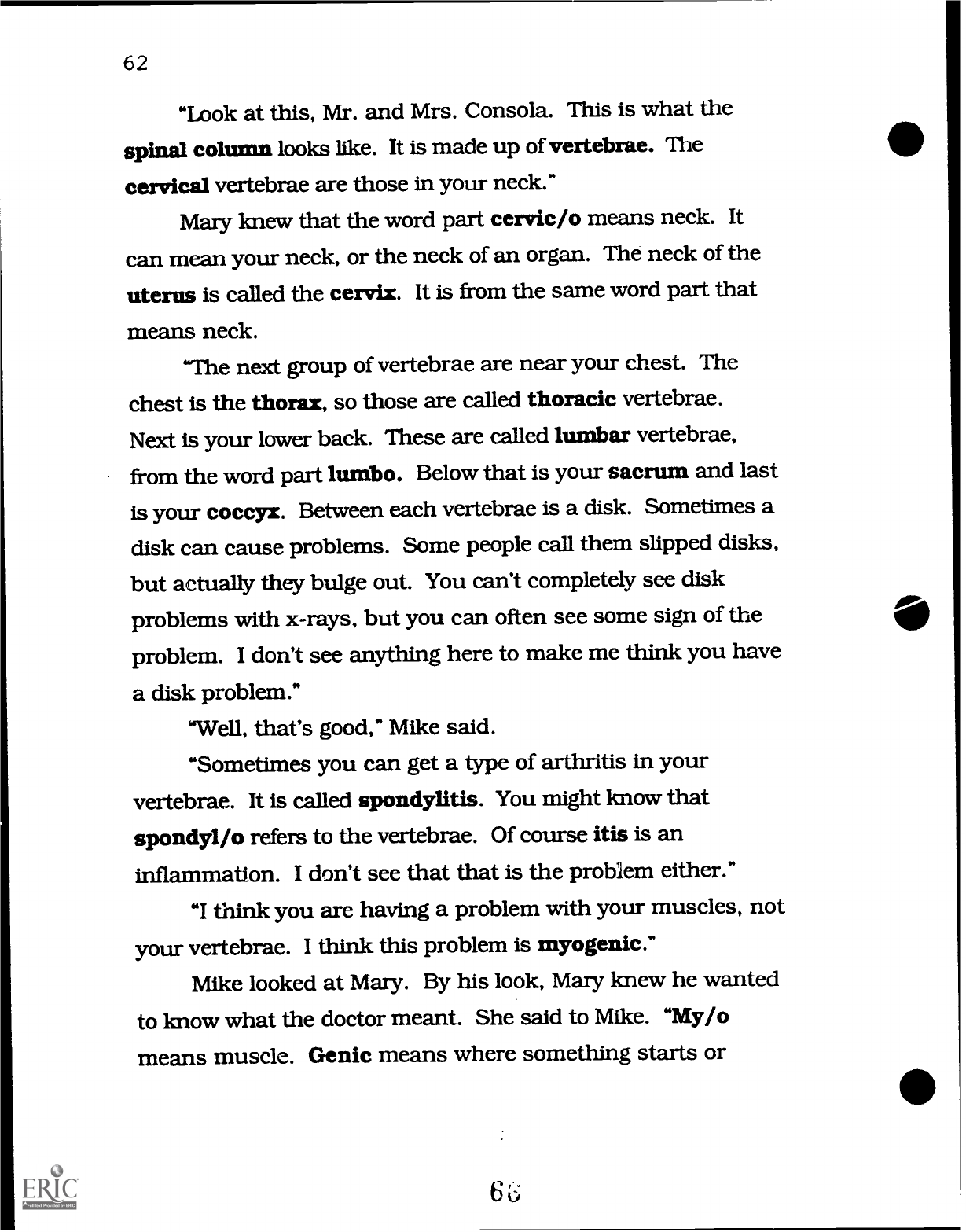
62
"Look at this, Mr. and Mrs. Consola. This is
what the
spinal column looks like. It is made up
of vertebrae. The
cervical vertebrae are those in your neck."
Mary knew that the word part cervic/o means
neck. It
can mean your neck, or
the neck of an organ. The neck of the
uterus is called the cervix. It is from
the same word part that
means neck.
"The next group of vertebrae are near your
chest. The
chest is the thorax, so those are called
thoracic vertebrae.
Next is your lower back. These are called
lumbar vertebrae,
from the word part lumbo. Below that is your sacrum
and last
is your coccyx. Between each vertebrae is a
disk. Sometimes a
disk can cause problems. Some people call
them slipped disks,
but actually they bulge out. You can't completely see
disk
problems with x-rays, but you can often see some sign
of the
problem. I don't see anything here to make me
think you have
a disk problem."
"Well, that's good," Mike said.
"Sometimes you can get a type of arthritis in your
vertebrae. It is called spondylitis. You might know that
spondyl/o refers to the vertebrae. Of course itis is an
inflammation. I don't see that that is the problem
either."
"I think you are having a problem with your
muscles, not
your vertebrae. I think
this problem is myogenic."
Mike looked at Mary. By his look, Mary knew he
wanted
to know what the doctor meant.
She said to Mike. "My/o
means muscle.
Genic means where something starts or
6 6

63
comes from. Mike, it's like the beginninglike Genesis in
the
Bible. So myogenic means something that started in the
muscles."
"That's right," said Dr. Lehman. "So, I think you need
some physical therapy. Let's see if that helps. If you are still
having problems in a month after having physical therapy,
come back to see me again."
Mike started his physical therapy. They put heat on his
sore back and taught him special exercises.
Within two weeks
he was feeling better. He didn't to go back to Dr. Lehman about
his back.
Here are the new word combinations:
bursectomy(bursa + surgical removal) surgical removal of
the bursa
bursitis(bursa + inflammation) inflammation of the bursa
bursopathy(bursa + disease) diseased condition of the bursa
cephalothoracic {head + chest) having to do with the head
and chest
cervicetomy(neck or neck of an organ + surgical removal) the
removal of the cervix or neck of the uterus
cervicitis(neck or neck of an organ + inflammation)
inflammation of the neck of the uterus
dorsosacral(back + sacrum) having to do with the lower back
gastrogenic(stomach + beginning) originating in the
stomach
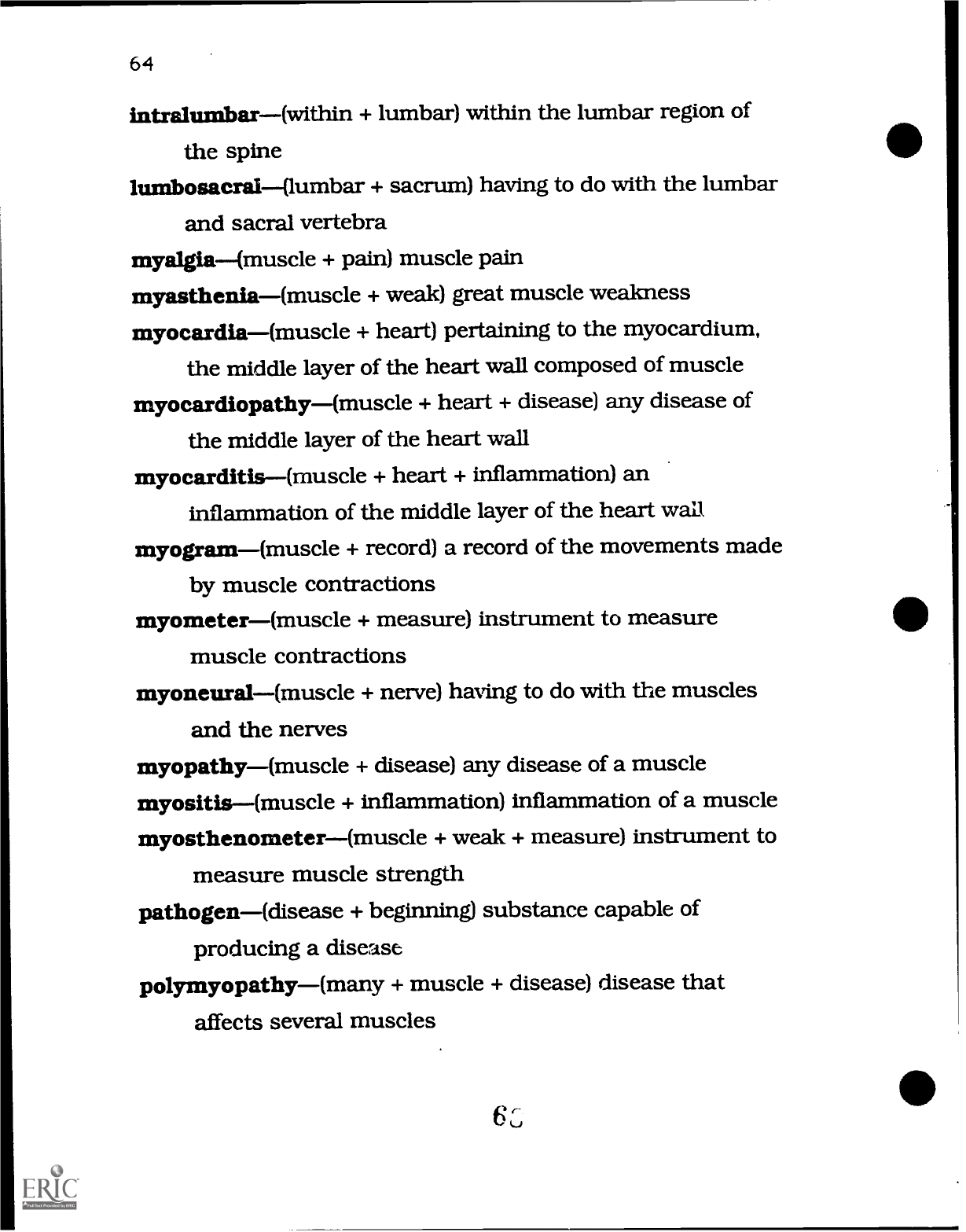
64
intralumbar(within + lumbar) within the lumbar region of
the spine
lumbosacral(lumbar + sacrum) having to do with the lumbar
and sacral vertebra
myalgia(muscle + pain) muscle pain
myasthenia(muscle + weak) great muscle weakness
myocardia(muscle + heart) pertaining to the myocardium,
the middle layer of the heart wall composed of muscle
myocardiopathy(muscle + heart + disease) any disease of
the middle layer of the heart wall
myocarditis(muscle + heart + inflammation) an
inflammation of the middle layer of the heart wail
myogram(muscle + record) a record of the movements made
by muscle contractions
myometer(muscle + measure) instrument to measure
muscle contractions
myoneural(muscle + nerve) having to do with the muscles
and the nerves
myopathy(muscle + disease) any disease of a muscle
myositis(muscle + inflammation) inflammation of a muscle
myosthenometer(muscle + weak + measure) instrument to
measure muscle strength
pathogen(disease + beginning) substance capable of
producing a disease
polymyopathy(many + muscle + disease) disease that
affects several muscles
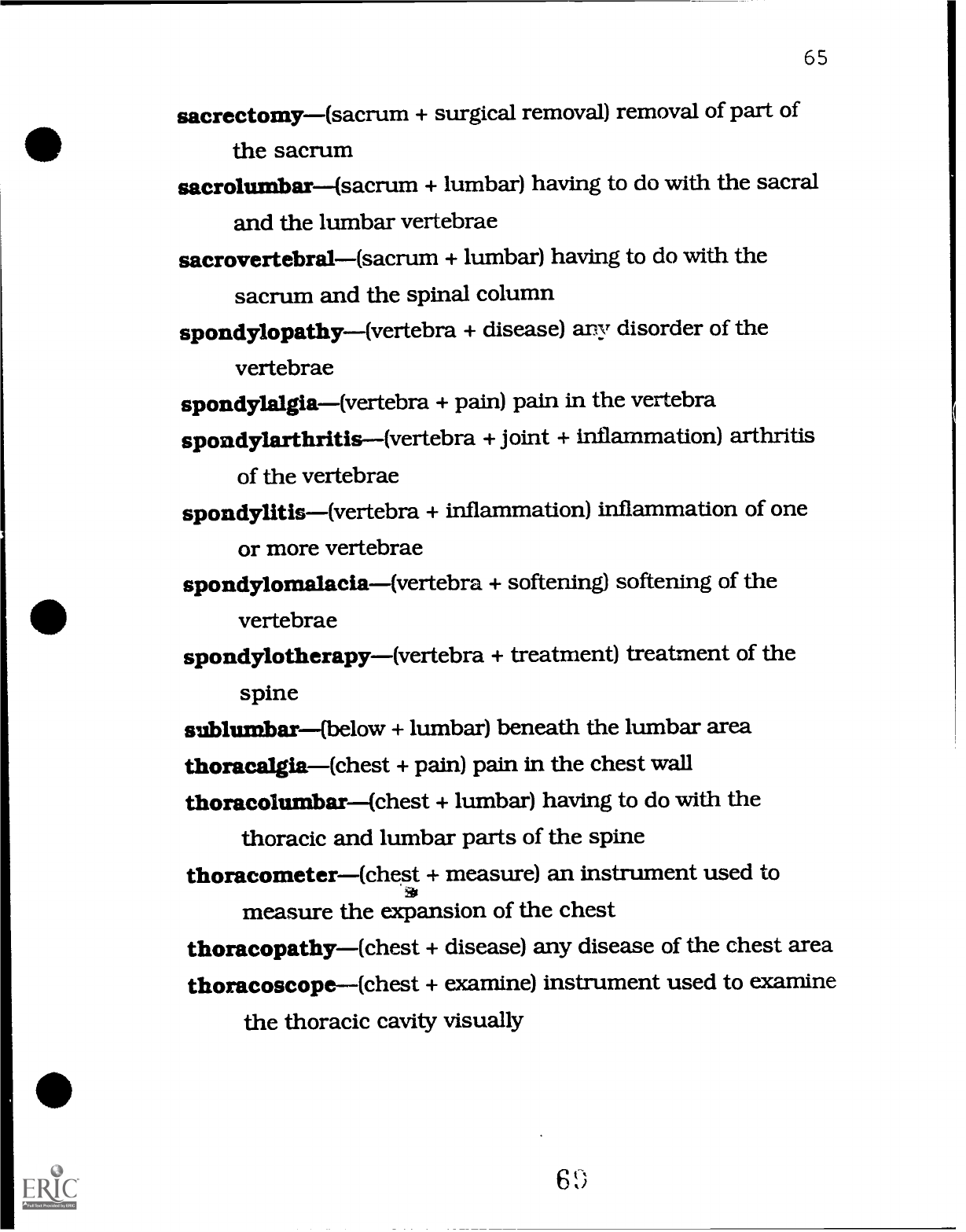
65
sacrectomy(sacrum + surgical removal) removal
of part of
the sacrum
sacrolumbar(sacrum + lumbar) having to do with the sacral
and the lumbar vertebrae
sacrovertebral(sacrum + lumbar) having to do with the
sacrum and the spinal
column
spondylopathy(vertebra + disease) any disorder of the
vertebrae
spondylalgia(vertebra + pain) pain in the vertebra
spondylarthritis(vertebra + joint + inflammation) arthritis
of the vertebrae
spondylitis(vertebra + inflammation) inflammation of one
or more vertebrae
spondyloinalacia(vertebra + softening) softening of the
vertebrae
spondylotherapy(vertebra + treatment) treatment of the
spine
sublumbar(below + lumbar) beneath the lumbar area
thoracalgia(chest + pain) pain in the chest wall
thoracolumbar(chest + lumbar) having to do with the
thoracic and lumbar parts of the spine
thoracometer(chest + measure) an instrument used to
measure the expansion of the chest
thoracopathy(chest + disease) any disease of the chest area
thoracoscope(chest + examine) instrument used to examine
the thoracic cavity visually

66
13. Mary Moves
In this story you will learn the following word parts:
brady
cost/o
edema
malacia
nat/i
oma
osis
oste/o
plasty
sclerosis
seps/o
tacky
tomy
tox/o
trauma
Two years passed. Mary finished school and became a
licensed practical nurse. It seemed like a dream come true.
But Mary knew how hard she had worked for that dream.
Mike was doing well in his job. He had been promoted to
foreman. His boss told him that if he went back to school, he
might get more promotions. So Mike started back to school
part-time so he could work toward his degree. Billy was doing
well in school, too. Thelma and her husband moved to their
70
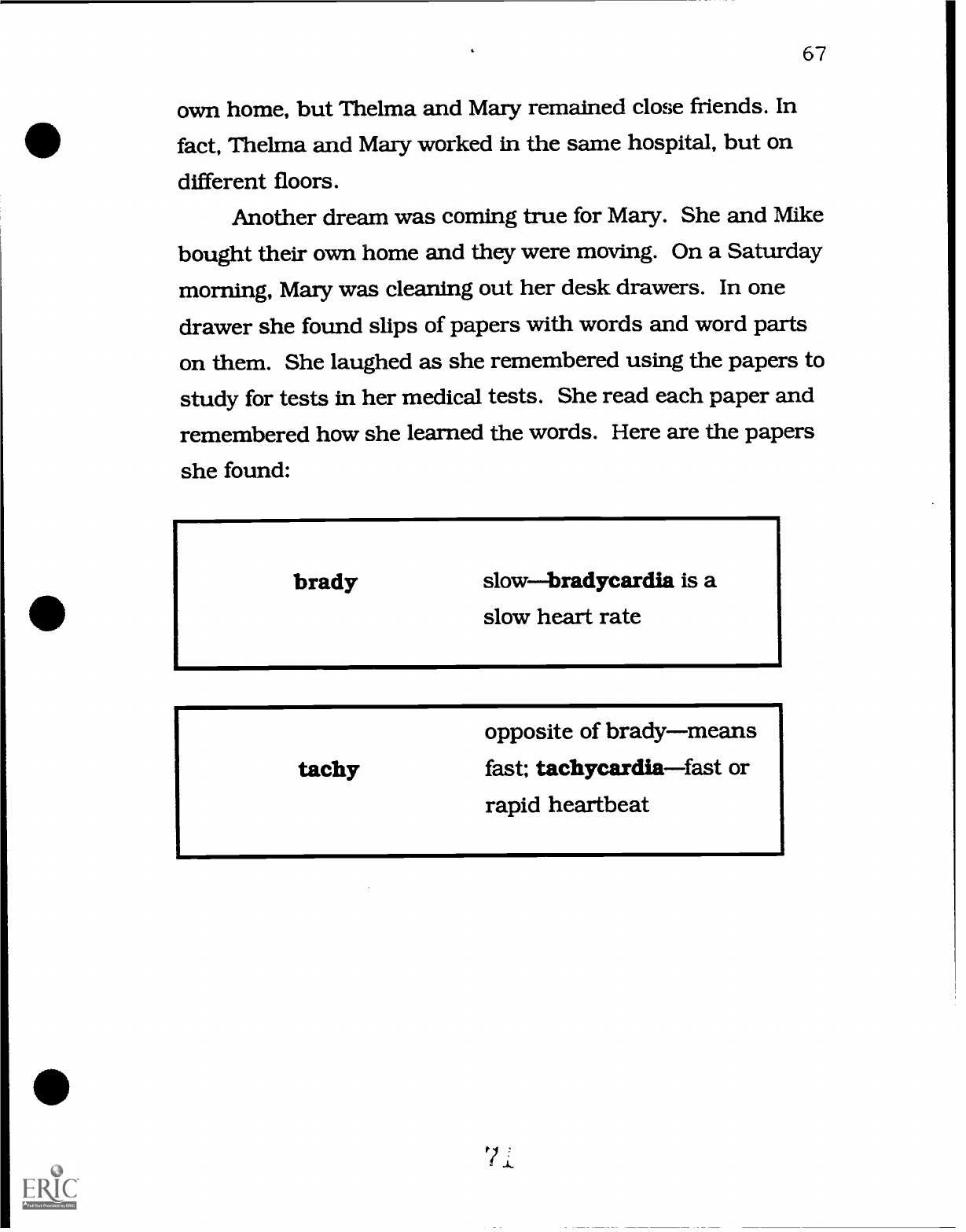
67
own home, but Thelma
and Mary remained close friends. In
fact, Thelma and Mary worked in the same hospital, but on
different floors.
Another dream was coming true for Mary. She and Mike
bought their own home and they were moving. On a Saturday
morning, Mary was cleaning out her desk drawers. In one
drawer she found slips of papers with words and word parts
on them. She laughed as
she remembered using the papers to
study for tests in her medical tests. She read each paper and
remembered how she learned the words. Here are the papers
she found:
brady
slow bradycardia is a
slow heart rate
tachy
opposite of bradymeans
fast; tachycardiafast or
rapid heartbeat
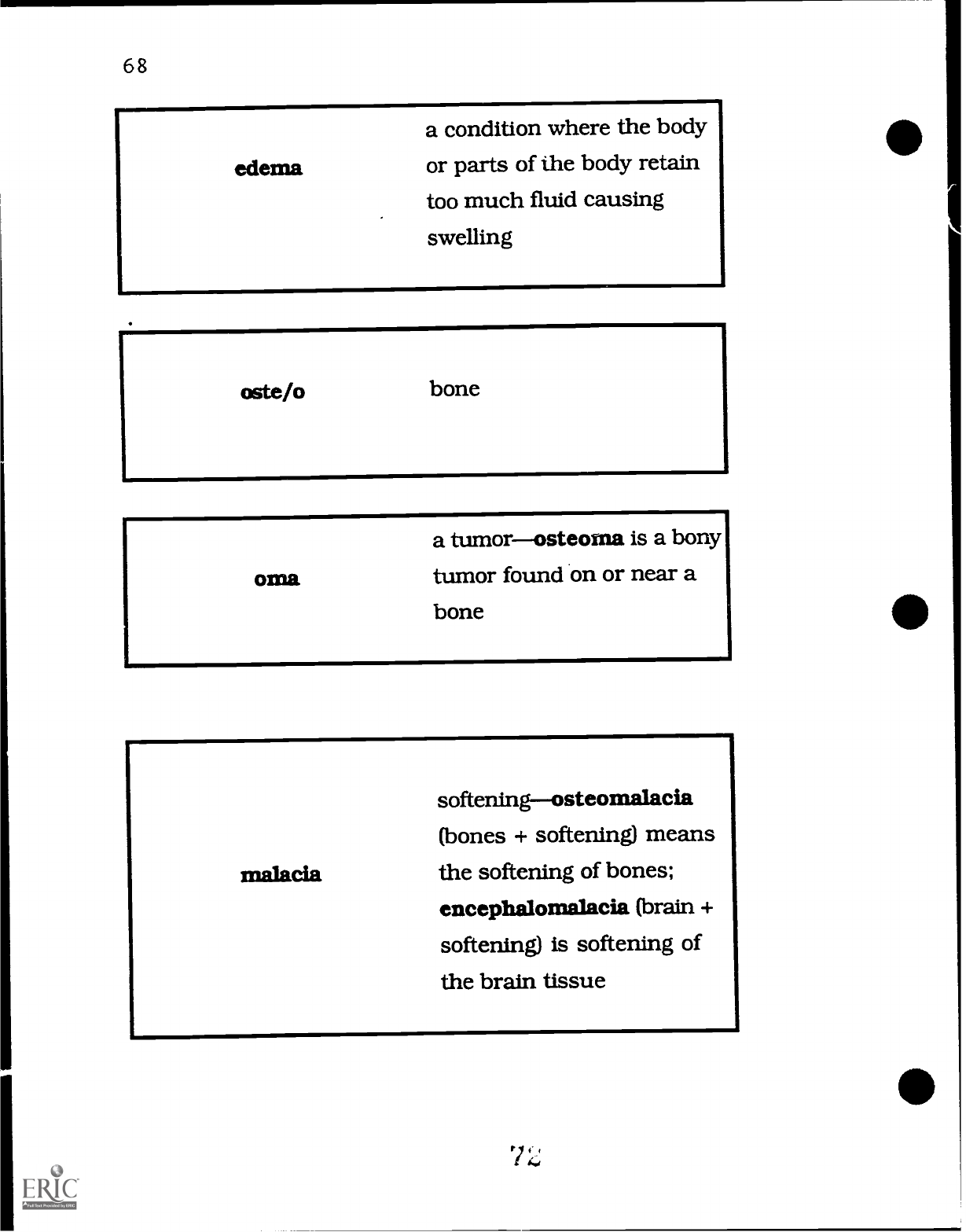
68
edema
a condition where
the body
or parts of the body retain
too much fluid causing
swelling
oste/o
bone
a tumorosteoina is a
bony
oma
tumor found on or near a
bone
malacia
softeningosteomalacia
(bones + softening) means
the softening of bones;
encephalomalacia (brain +
softening) is softening of
the brain tissue
T.;

birthprenatal (before +
nat/i
birth) care means medical
care while pregnant, before
the baby is born
neo
newneonatal (new +
birth) means a newly born
baby
osis
a conditiondermatosis
(skin + condition) is a
condition of the skin
without inflammation (not
the same as dermatitis
which is an inflammation
of the skin)
tomy
making an incision or cut;
craniotomy is cutting into
the skull.
69
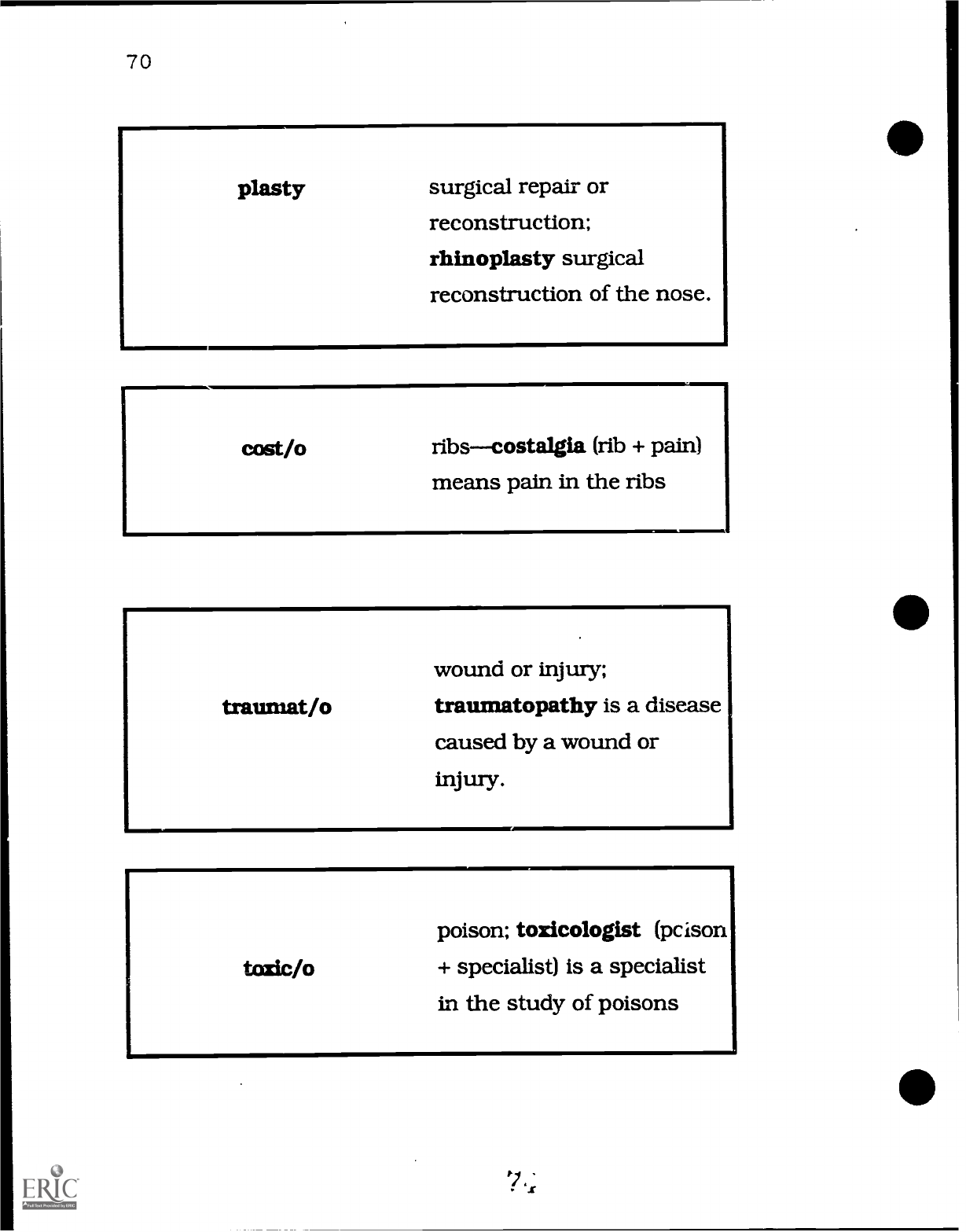
70
plasty
surgical repair or
reconstruction;
rhinoplasty surgical
reconstruction of the nose.
cost /o
ribscostalgia (rib + pain)
means pain in the ribs
tmumat/o
wound or injury;
traumatopathy is a disease
caused by a wound or
injury.
toxic/o
poison; toxicologist (pcison
+ specialist) is a specialist
in the study of poisons

71
septic
having to do with
organisms that can cause
disease; antiseptic is
something that can kill
disease-causing
organisms.
sclerosis
hardening
Here are new word combinations:
antiseptic(against + disease causing organisms) something
that kills bacteria and other disease causing organisms
antitoxin (against + poison) neutralizing a poison
bradycardia(slow + heart) slow heart beat
cardiomalacia(heart + softening) softening of the heart
muscle
cardiosclerosis(heart + hardening) hardening of the heart
and arteries (arteriosclerosis)
costalgia--(rib + pain) pain in the ribs
costectomy(rib + surgical removal) surgical removal of a rib
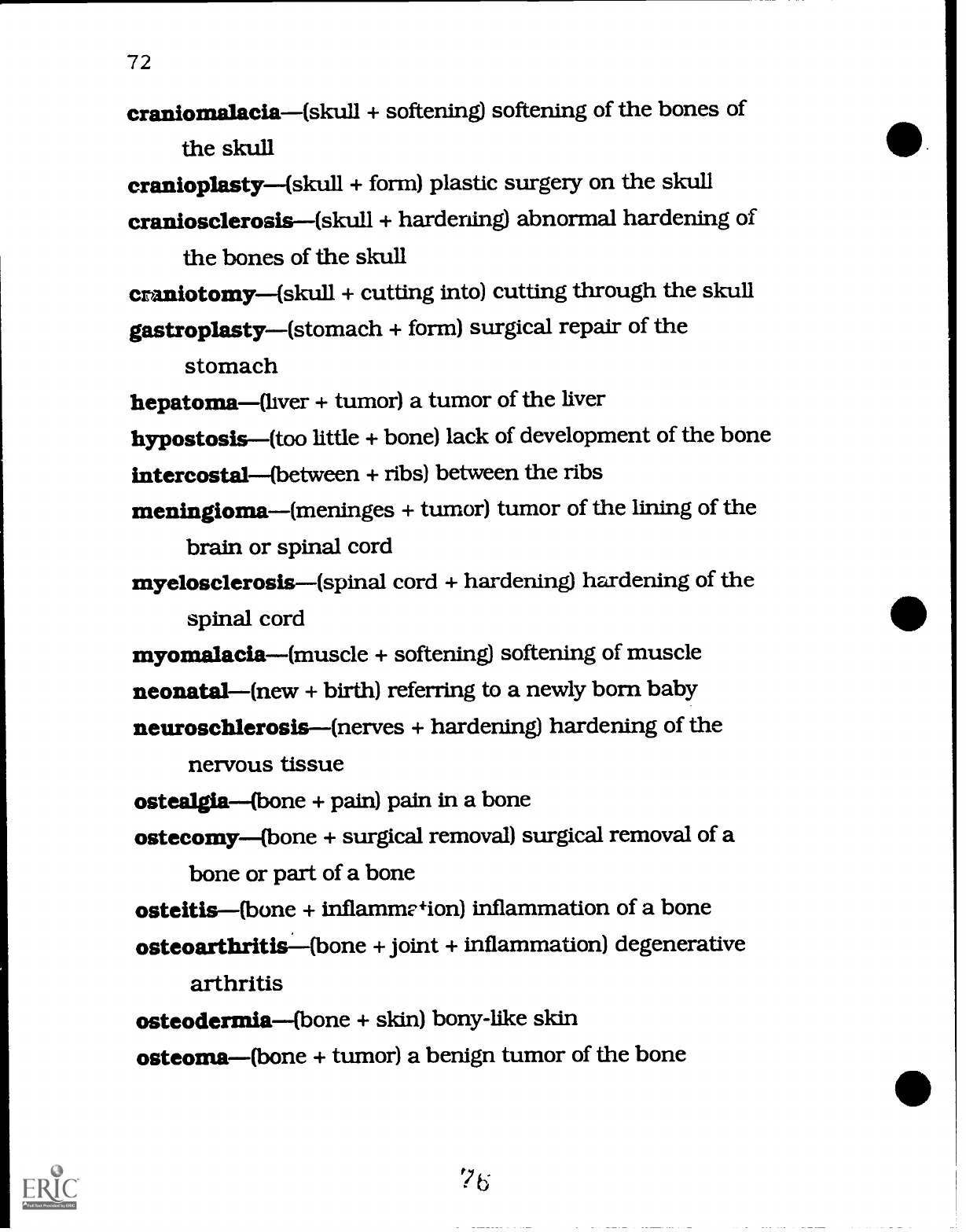
72
cranioraalacia(skull + softening) softening of the bones of
the skull
cranioplasty(skull + form) plastic surgery on the skull
craniosclerosis(skull + hardening) abnormal hardening of
the bones of the skull
craniotomy(skull + cutting into) cutting through the skull
gastroplasty(stomach + form) surgical repair of the
stomach
hepatoma(liver + tumor) a tumor of the liver
hypostosis(too little + bone) lack of development of the bone
intercostal(between + ribs) between the ribs
meningioma(meninges + tumor) tumor of the lining of the
brain or spinal cord
myelosclerosis(spinal cord + hardening) hardening of the
spinal cord
myomalacia(muscle + softening) softening of muscle
neonatal(new + birth) referring to a newly born baby
neuroschlerosis(nerves + hardening) hardening of the
nervous tissue
ostealgla(bone + pain) pain in a bone
ostecomy(bone + surgical removal) surgical removal of a
bone or part of a bone
osteitis(bone + inflammz+ion) inflammation of a bone
osteoarthritisL(bone + joint + inflammation) degenerative
arthritis
osteodermia(bone + skin) bony-like skin
osteoma(bone + tumor) a benign tumor of the bone

73
otoplasty(ear + to form) plastic surgery of the ear
ototomy(ear + cut) cutting into the ear
plastic surgery(form + surgery) surgery to repair,
reconstruct, or restore body parts
podedema(foot + swelling) retention of fluid in the foot
causing swelling
prenatal(before + birth) before birth
rhinoplasty(nose + form) plastic surgery of the nose
spondylmalacia(vertebra + softening) softening of the
vertebrae
subcostal(below + ribs) below the ribs
tachycardia(fast + heart) a fast heart beat
thoracoplasty(chest + form) plastic surgery involving the
chest and lung
toxic(poison) having to do with or caused by poison
toxicoderma(poison + skin) any skin disease caused by
poison
toxicodermatitis(poison + skin + inflammation) any skin
inflammation caused by poison
toxicologist(poison + specialist) a specialist in the field of
poisons
toxicopathy(poison + disease) any disease caused by
poisons
toxicophobia(poison + fear) abnormal fear of being poisoned
toxicotherapy(poison + treatment) use of poisons to treat a
disease
77
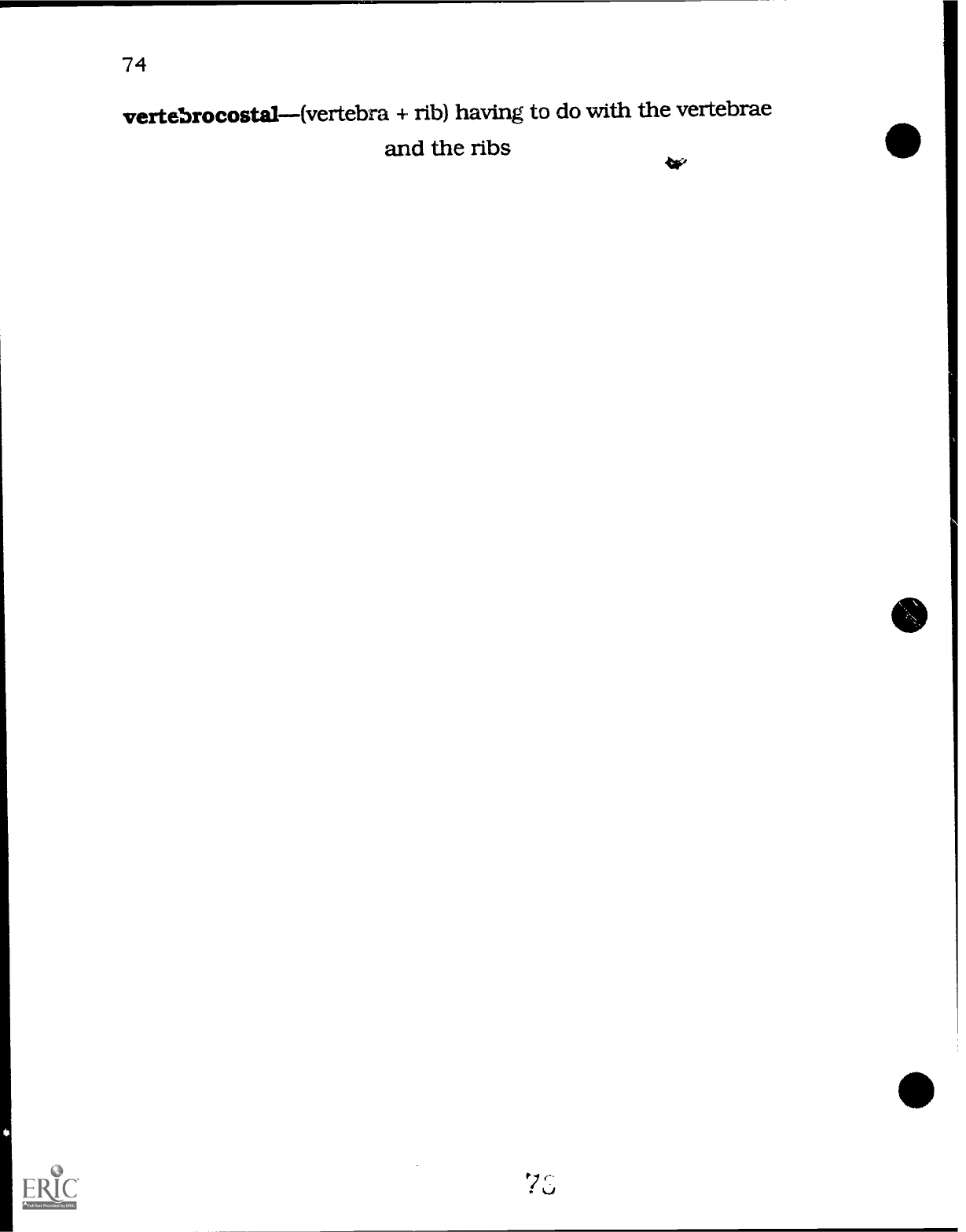
74
vertebrocostal(vertebra + rib) having to do with
the vertebrae
and the ribs
L,
Aso

75
CONCLUSION
Mary stopped in the supermarket one dry right after
work. She was still wearing her white uniform. While she was
putting her groceries into her car a young woman with a baby
stopped to talk to her.
"Are you a nurser" the woman asked.
"Yes," answered Mary. "My name is Mary Consola. I'm
an LPN. I work in the hospital across
the street."
"My name is Debbie. I would really like to be a nurse," the
young woman said.
Mary said, "Well, why don't you start school at the
community college. They have an LPN course. That's where I
went to school."
The young woman looked down at the ground. "I don't
think I could learn everything. All the long medical wordsI'd
never be able to read them."
Mary smiled. She remembered the time she first met
Thelma. "You know, Debbie, I felt that way too. I never thought
I could learn those long words. But you can learn them. A
friend helped me learn them. I can help you."
Debbie looked up. "Would you do that?" Debbie said.
"Sure! We have to help each other. Someone helped me
and I can help someone else. Let's talk about this."
Mary and Debbie continued talking...
TJ

76
Glossary
androman
antebefore
anter/ofront or belly side of the body
antiagainst
append/ohaving to do with the
appendix
arthr/ojoint
asthenialack of strength
audi/ohearing
1:4two
bradyslow
burs/oa sac filled with fluid found
between tissues, especially
joints
earth /o--the heart
caud/otoward the tail; away from the head
cephal/othe head; toward the head
cervic/oneck or neck of an organ
coccyg/obone at the bottom of the spinal
column
cost/orib
crani/othe skull
dactyl/ofinger or toe
deepaway from the surface of the body
dent/itooth
dermat /o -skin
disto be free from; not
dors/othe back side of the body; on
the back
8 Li

77
ectomyto remove surgically
edema--collection of fluid in the tissues
encephal/obrain
esthesi/ofeeling
febr/ifever
fusionto pour
gastr/ostomach
genicthe origin
gramrecording
gynec/owoman; female
hemat/oblood
hemihalf
hepat/oliver
hydr/owater
hyperabove; too much; too many
hypobelow; too few
hyster/othe uterus; the womb
iatricianphysician
inferioraway from the head; below
interbetween
antra within
ista physician
itisinflammation
later/oside; away from the midline
lingu/otongue
logistan expert
lumb/opart of the back between the thorax and the sacrum
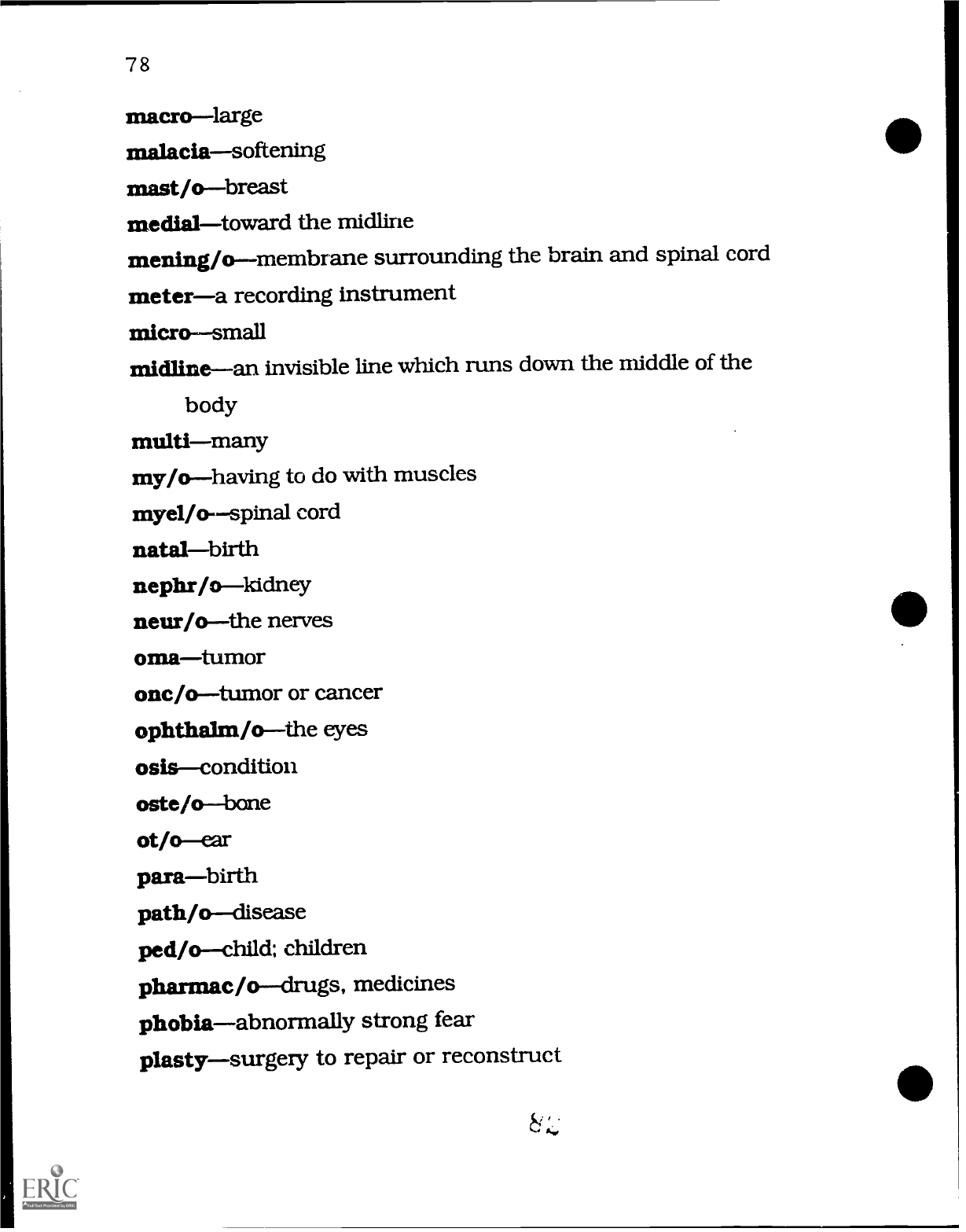
78
macrolarge
malaciasoftening
mast /o-- breast
medialtoward the midline
mening/omembrane surrounding the brain
and spinal cord
metera recording instrument
microsmall
midlinean invisible line which runs down
the middle of the
body
multimany
my/ohaving to do with muscles
myel/o--spinal cord
natalbirth
nephr/o--kidney
neur/othe nerves
omatumor
onc/otumor or cancer
ophthalm/othe eyes
osiscondition
oste/obone
of /o --ear
parabirth
path/odisease
ped/ochild; children
pharmac /o drugs, medicines
phobiaabnormally strong fear
plastysurgery to repair or reconstruct

plegiaparalysis
pod/ofoot
polymany
postafter
poster/oback of the body
prebefore
pseud/ofalse
psych/othe mind
pub aon/olung
quadr/ifour
rhin/onose
sacr/opart of the back between the lumbar area and the
coccyx
scope--instrument used to examine
scopyto examine visually
semihalf
septicdisease causing organisms
sonosound
spasmcontraction or tightening
spinal columnthe backbone
spondyl/ohaving to do with the vertebrae
subunder
superficialclose to the surface of the body
superiortoward the head; above
tachyfast
therapytreatment
therm/oheat
79

80
thorac/othe chest area; thorax
-tomy cutting into
tonsill/otonsil (tissues found in the throat)
toxic/o--poison
transacross
traumawound or injury
trithree
unione
venousvein
ventr/othe front or belly side of the body
vertebra(e)bones that make up the spine or backbone
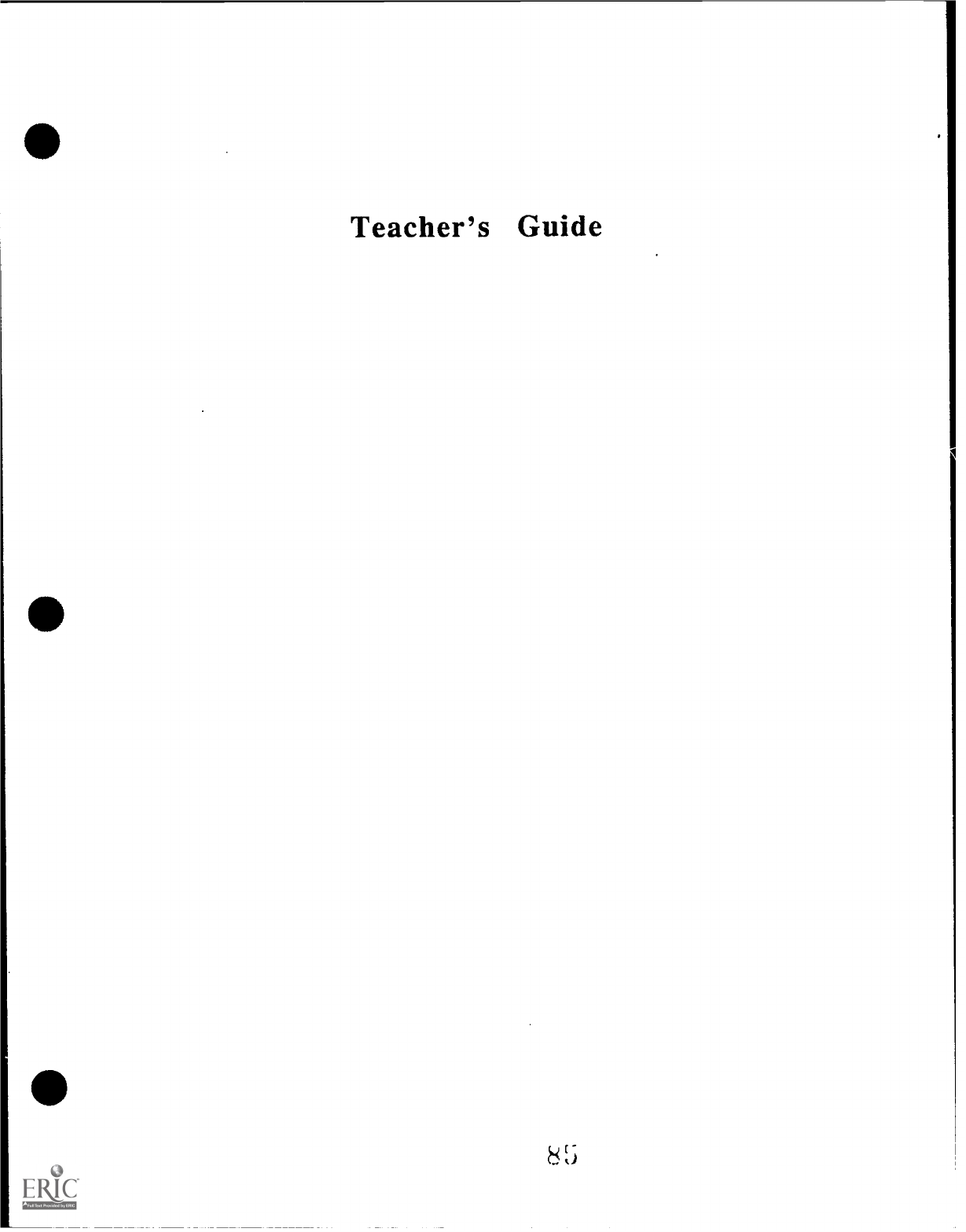
Teacher's Guide
85
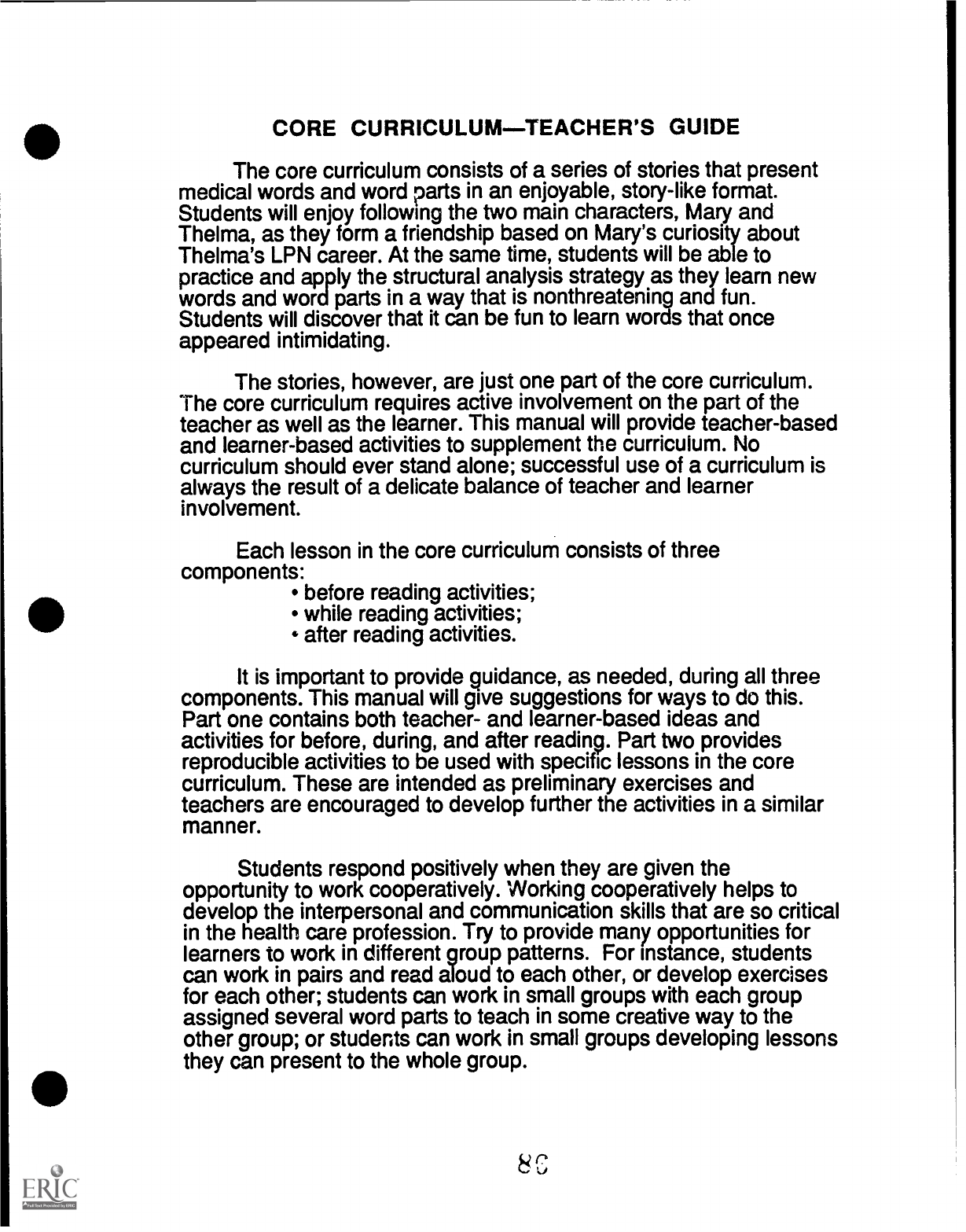
CORE CURRICULUMTEACHER'S GUIDE
The core curriculum consists of a series of stories that present
medical words and word parts in an enjoyable, story-like format.
Students will enjoy following the two main characters, Mary and
Thelma, as they form a friendship based on Mary's curiosity about
Thelma's LPN career. At the same time, students will be able to
practice and apply the structural analysis strategy as they learn new
words and word parts in a way that is nonthreatening and fun.
Students will discover that it can be fun to learn words that once
appeared intimidating.
The stories, however, are just one part of the core curriculum.
The core curriculum requires active involvement on the part of the
teacher as well as the learner. This manual will provide teacher-based
and learner-based activities to supplement the curriculum. No
curriculum should ever stand alone; successful use of a curriculum is
always the result of a delicate balance of teacher and learner
involvement.
Each lesson in the core curriculum consists of three
components:
before reading activities;
while reading activities;
after reading activities.
It is important to provide guidance, as needed, during all three
components. This manual will give suggestions for ways to do this.
Part one contains both teacher- and learner-based ideas and
activities for before, during, and after reading. Part two provides
reproducible activities to be used with specific lessons in the core
curriculum. These are intended as preliminary exercises and
teachers are encouraged to develop further the activities in a similar
manner.
Students respond positively when they are given the
opportunity to work cooperatively. Working cooperatively helps to
develop the interpersonal and communication skills that are so critical
in the health care profession. Try to provide many opportunities for
learners to work in different group patterns. For instance, students
can work in pairs and read aloud to each other, or develop exercises
for each other; students can work in small groups with each group
assigned several word parts to teach in some creative way to the
other group; or students can work in small groups developing lessons
they can present to the whole group.
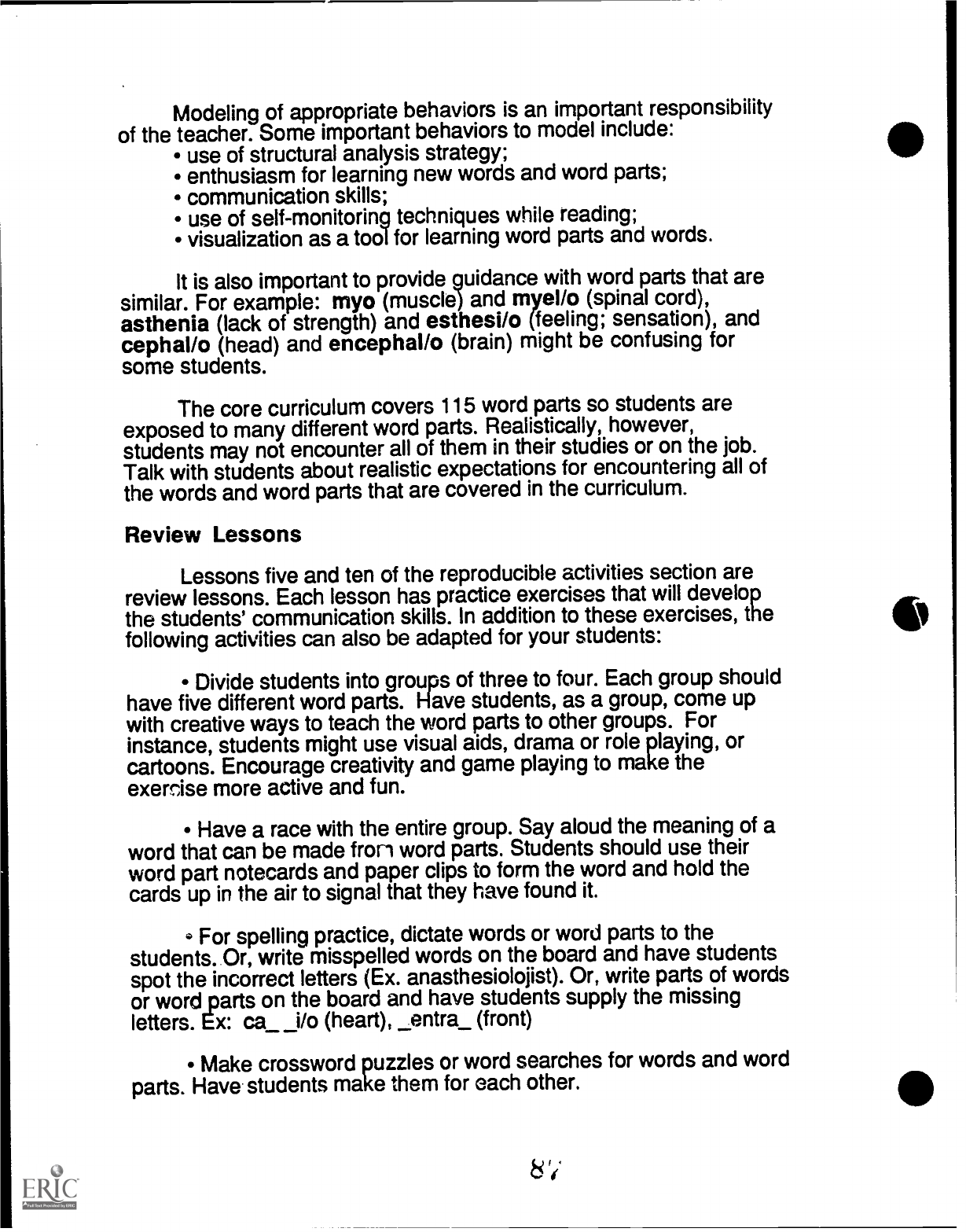
Modeling of appropriate behaviors is an important
responsibility
of the teacher. Some important behaviors to
model include:
use of structural
analysis strategy;
enthusiasm for learning new words and word parts;
communication skills;
use of self-monitoring
techniques while reading;
visualization as a tool for learning word parts and words.
It is also important to provide guidance
with word parts that are
similar. For example: myo (muscle) and
myel/o (spinal cord),
asthenia (lack of strength) and esthesi/o
(feeling; sensation), and
cephal/o (head) and encephal/o (brain)
might be confusing for
some students.
The core curriculum covers 115 word parts so
students are
exposed to many different word parts.
Realistically, however,
students may not encounter all of them in
their studies or on the job.
Talk with students about realistic expectations
for encountering all of
the words and word parts that are covered
in the curriculum.
Review Lessons
Lessons five and ten of the reproducible activities section are
review lessons. Each lesson has practice exercises that will
develop
the students' communication skills. In addition to these
exercises, the
following activities can also be adapted for your students:
Divide students into groups of three to four. Each group
should
have five different word parts. Have students, as a group, come up
with creative ways to teach the word parts to other groups.
For
instance, students might use visual aids, drama or role playing, or
cartoons. Encourage creativity and game playing to
make the
exercise more active and fun.
Have a race with the entire group. Say aloud the meaning of a
word that can be made from word parts. Students
should use their
word part notecards and paper clips to form the word
and hold the
cards up in the air to signal that they have found it.
For spelling practice, dictate words or word parts to the
students. Or, write misspelled words on the board
and have students
spot the incorrect letters (Ex.
anasthesiolojist). Or, write parts of words
or word parts on the
board and have students supply the missing
letters. Ex: ca_ _i/o (heart), _entry_ (front)
Make crossword puzzles or word searches
for words and word
parts. Have students make them
for each other.
8
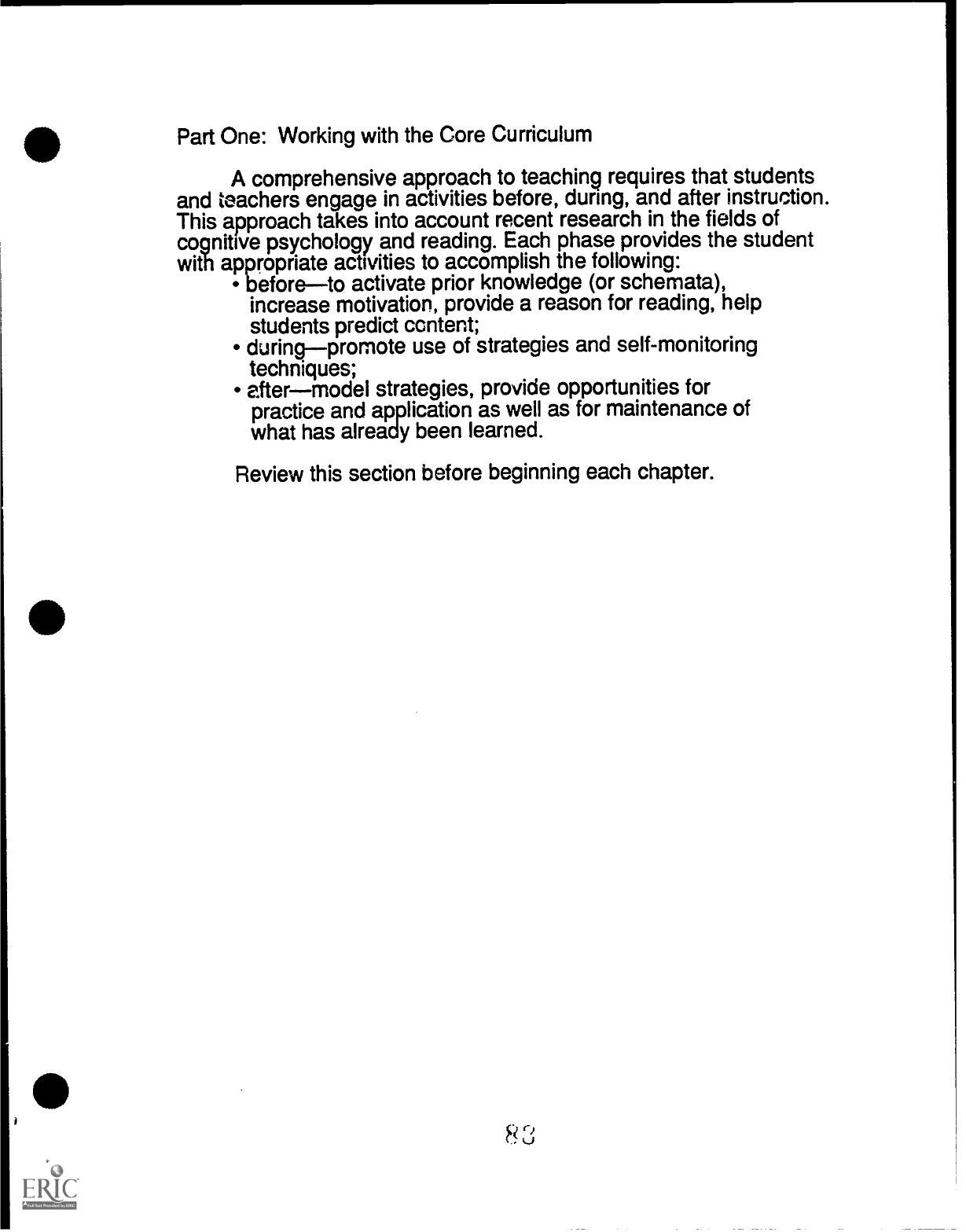
Part One: Working with the Core Curriculum
A comprehensive approach to teaching requires that students
and teachers engage in activities before, during, and after instruction.
This approach takes into account recent research in the fields of
cognitive psychology and reading. Each phase provides the student
with appropriate activities to accomplish the following:
beforeto activate prior knowledge (or schemata),
increase motivation, provide a reason for reading, help
students predict content;
duringpromote use of strategies and self-monitoring
techniques;
aftermodel strategies, provide opportunities for
practice and application as well as for maintenance of
what has already been learned.
Review this section before beginning each chapter.
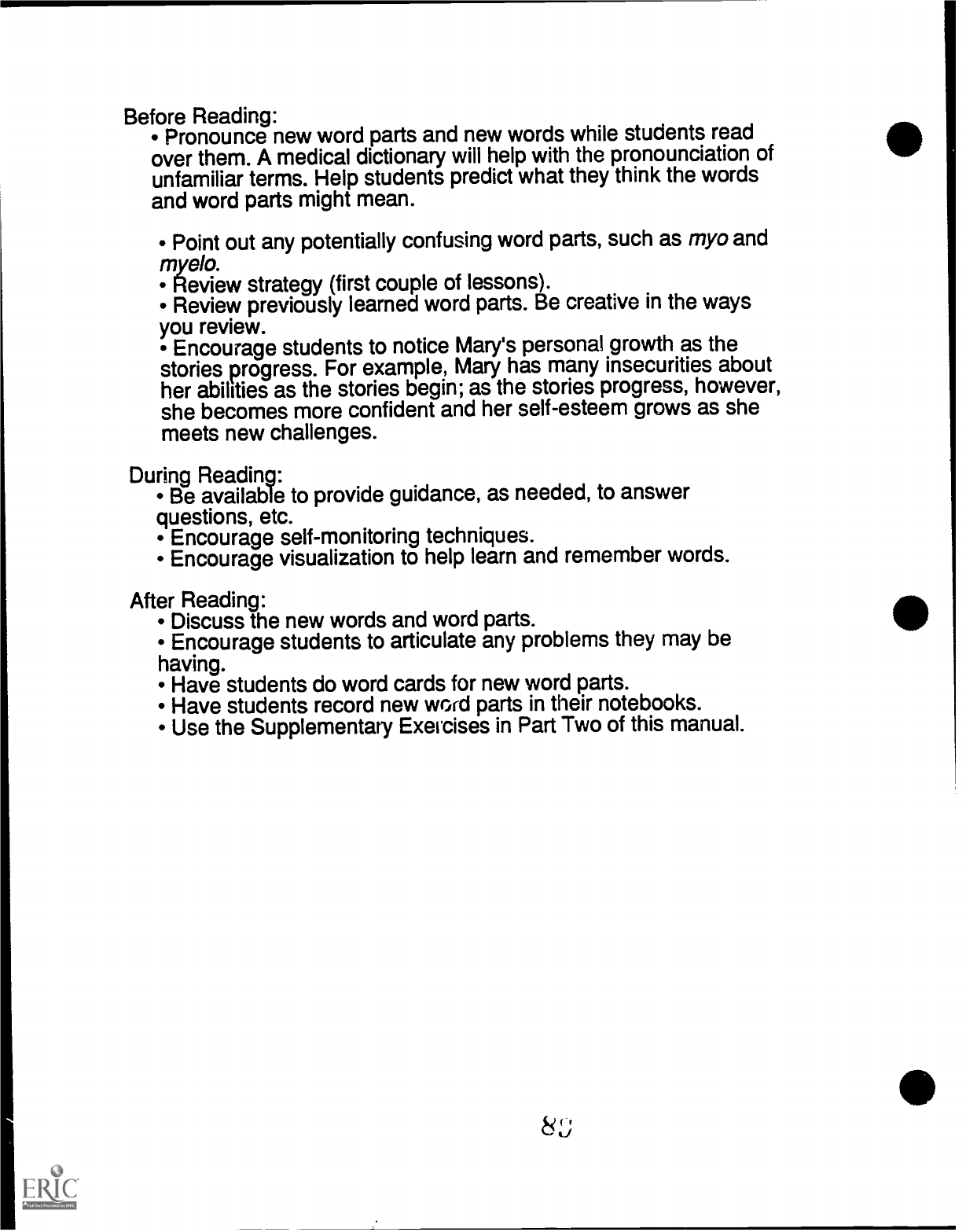
Before Reading:
Pronounce new word parts and new words while
students read
over them. A medical
dictionary will help with the pronounciation of
unfamiliar terms. Help students predict what they think
the words
and word parts might mean.
Point out any potentially confusing word parts, such as myo
and
myelo.
Review strategy (first couple of lessons).
Review previously learned word parts. Be creative in the ways
you review.
Encourage students to notice Mary's personal growth as the
stories progress. For example, Mary has many
insecurities about
her abilities as the stories begin; as the stories progress,
however,
she becomes more confident and her self-esteem grows as
she
meets new challenges.
During Reading:
Be available to provide guidance, as needed, to answer
questions, etc.
Encourage self-monitoring techniques.
Encourage visualization to help learn and remember words.
After Reading:
Discuss the new words and word parts.
Encourage students to articulate any problems they may be
having.
Have students do word cards for new word parts.
Have students record new word parts in their notebooks.
Use the Supplementary Exercises in Part Two of this manual.
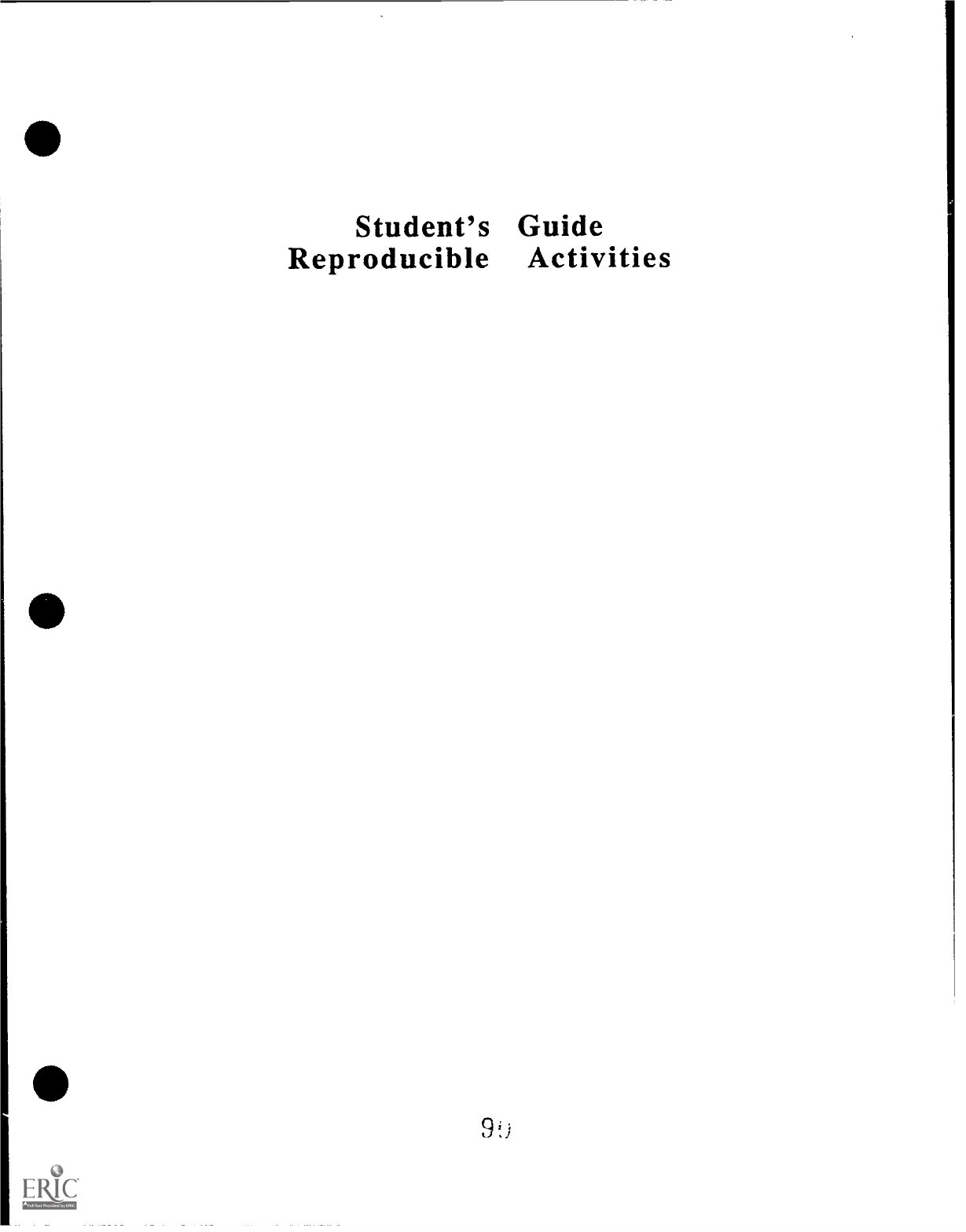
Student's Guide
Reproducible
Activities

STUDENT'S GUIDE
Introduction
Part One
You will begin your career in the health care field soon. You will
see and hear many new words.
You may hear doctors, nurses, or
other people using words you haven't heard before. You might see
new words on charts, bulletin boards,
reading materials, or other
places. You will have to read and understand these new words to do
well on the job.
This program will help build your medical vocabulary. You will
learn an important strategy for figuring out new words. You will find
that you already know many medical words. The words you already
know will help you figure out new words.
First, think about what you do now when you see or hear
unfamiliar words. Write about some of the things you do to help you
figure out new words.
OUR GROWING LANGUAGE
Most people are unaware of how much the English language
changes in their lifei;me. But it does change. New words come into
use, others are goins; out of style, and old words take on new
meanings. The English language has been changing constantly since
it first developed around 400-600 AD. This lesson will explore some of
the reasons why language changes.
Think back to when you were a child. Then slowly begin to trace
forward. Try to remember when you first heard words that are now
familiar to you. Here are some words you probably didn't hear during
childhood: microwave, digital, VCR, Ninja Turtles.
There may be hundreds of words that have become part of the
language in your lifetime. If you went back in time to your childhood,
what are some words that wouldn't have been heard then? Write
them here.

You should have an idea of how much the language has
changed in ycur lifetime. You should also understand some
of the
reasons why the language changes.
There are influences from our
own culture and from cultures around
the world. You can say that
language is like a mirror of culture and time.
Now, let's look at the special language used in the health care
field. Think back to when you were a child. Suppose you were to go
back in time and talk with people in the health care field. What are
some words that are common now
but wouldn't have been known
back then? Write them here.

A SHORT HISTORY OF THE ENGLISH LANGUAGE
Part One
The English language has been spoken for a long time. It was
being spoken in 400 AD! Think about how many changes there must
have been in the language since then.
This lesson will tell you about the three main periods in the
history of the English language.
1.
Old English (Around 400 to 1100 AD)
At the beginning of this period, England was known only as
Britain. It was occupied by the Celts, who were the ancestors of the
Irish, Scots, and Welsh. Britain was invaded in the 400s by three
Germanic tribesthe Angles, Saxons, and Jutes. The influence of
these invading tribes marked the beginning of the English language
as we know it. In fact, the name
England came from one of these
tribes, the Angles (England = the land of the Angles). The
language
spoken then was very different from what we speak today. But a
few
words remain unchanged from that time: run, man, a, child, the,
for. This sample of Old English is taken from the Anglo-Saxon
Gospels, which was written about 995 AD:
Behealdap heofonan fuglas, foraam De hig ne sawap, ne
hig ne ripap, ne hig ne gadriap on berne; and eower
heofonlica fader hig fet. Hu ne synt ge selran aonne
hig?
(Look at the birds of the air: they neither sow nor reap nor
gather into barns, and yet your heavenly Father feeds them. Are
you not of more value than they?)
Another major influence during this period was the spread of
Christianity, which began around 500 AD. Latin was the language of
the Church, and to this day our language contains thousands of
words from Latin. Some examples of words that have survived
unchanged include: hymn, priest, bishop, nun, shrine, monk,
and psalm.

2.
Middle English (1150 to 1500 AD)
There was an enormous French influence on the
language of
this time. The Normans, who were French,
invaded England in 1066
AD. After the invasion, the official language
of England was Anglo-
Norman French, but it never replaced English.
The common people
still spoke English. But the French
influence was strong. It added
nearly ten thousand words to the English
language. For example, the
English used the names of animals when they
talked about meat. We
can thank the French for
giving us the words veal for calf, beef for
cow, mutton for sheep,
venison for deer, and pork for pig.
As the Norman influence began to fade,
English was once again
the major language. This example of Middle
English is taken from The
Canterbury Tales, by Geoffrey Chaucer. It was
written between 1370
and 1399 AD:
Wel he loved he garleek, oynons, and eek
lekes
And for to drynken strong wyn, reed as blood;
Thanne wolde he speke and crie as he were wood
And when that he wel dronken hadde the wyn,
Than wolde he speke no word but Latyn.
Another important influence was the printing press, which was
brought to England in 1476 AD.
3.
Modern English (1500 AD to present)
The printing press made reading materials available to more
people. At the same time, formal education was available to more
people. The teaching of Latin and Greek was important in
the schools
at that time. Some Latin and Greek words have
survived intact:
alibi, bonus, doctor, junior, stimulus from Latin; and
asbestos,
chaos, echo, and idea from Greek.
Two other important influences on the growth of the English
language were colonization and the spread of commerce.
During their
travels for trade and colonization, the English brought back to
the
vocabulary many new words from around the world. Some examples
include:
kindergarten (Germany), piano, pizza (Italy), wigwam
(American), tank (Portugal), and rodeo (Spain).
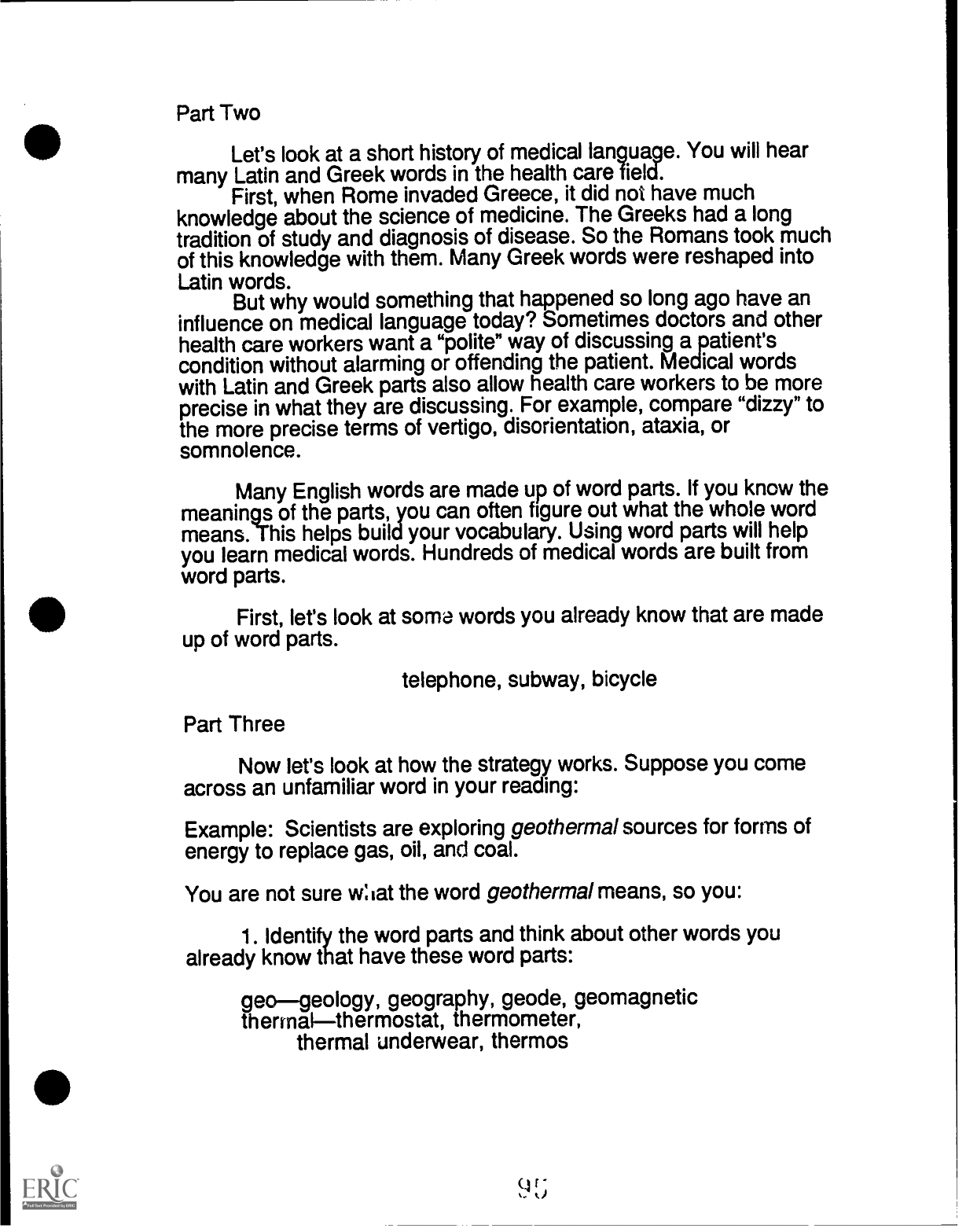
Part Two
Let's look at a short history of medical language. You will hear
many Latin and Greek words in
the health care field.
First, when Rome invaded Greece, it did not have much
knowledge about the science of medicine. The Greeks had a long
tradition of study and diagnosis of disease. So the Romans took much
of this knowledge with them. Many Greek words were
reshaped into
Latin words.
But why would something that happened so long ago have an
influence on medical language today? Sometimes doctors and other
health care workers want a "polite" way of discussing a patient's
condition without alarming or offending the patient. Medical words
with Latin and Greek parts also allow health care workers to be more
precise in what they are discussing. For example, compare
"dizzy" to
the more precise terms of vertigo, disorientation,
ataxia, or
somnolence.
Many English words are made up of word parts. If you know the
meanings of the parts, you can often figure out what the whole word
means. This helps build your vocabulary.
Using word parts will help
you learn medical words. Hundreds
of medical words are built from
word parts.
40
First, let's look at some words you already know that are made
up of word parts.
telephone, subway, bicycle
Part Three
Now let's look at how the strategy works. Suppose you come
across an unfamiliar word in your
reading:
Example: Scientists are exploring geothermal sources for forms of
energy to replace gas, oil, and coal.
You are not sure w:Iat the word geothermal means, so you:
1. Identify the word parts and think about other words you
already know that have these word parts:
geogeology, geography, geode, geomagnetic
therrnalthermostat, thermometer,
thermal underwear, thermos

2. Identify the meanings of the parts from
the familiar words.
geoearth
thermalheat
3. Come up with what you think might be the
definition.
geothermalheat from the earth
4. Read the sentence again and ask
yourself if the definition
makes sense in the sentence.
It is important for you to become comfortable
with this strategy.
It will be used in all the lessons of the healti. care
vocabulary unit. A
word of caution, however: when it is important to
be ata2me4 certain
and precise about a definition, always use a
glossary or a dictionary.
A Closer Look
Word parts may be at the beginning, middle, or end
of a word.
This lesson will teach you the names for each type of word part.
1. All words have a main part called the root. The root
of the word
carries the meaning of the word. For example:
What do you think is the root of these words?
breaking, breakable, break, unbreakable
Some words have more than one root. They are called compound
words.
Look at these compound words.
breakfast, breakdown
2. Some words have a word part added to the beginning of
the word.
The group of letters added to the beginning of the word is called
the
prefix. The prefix adds to or changes the meaning of the root.
What do you think is the prefix of these words?
unbreakable, unfriendly, mistreat
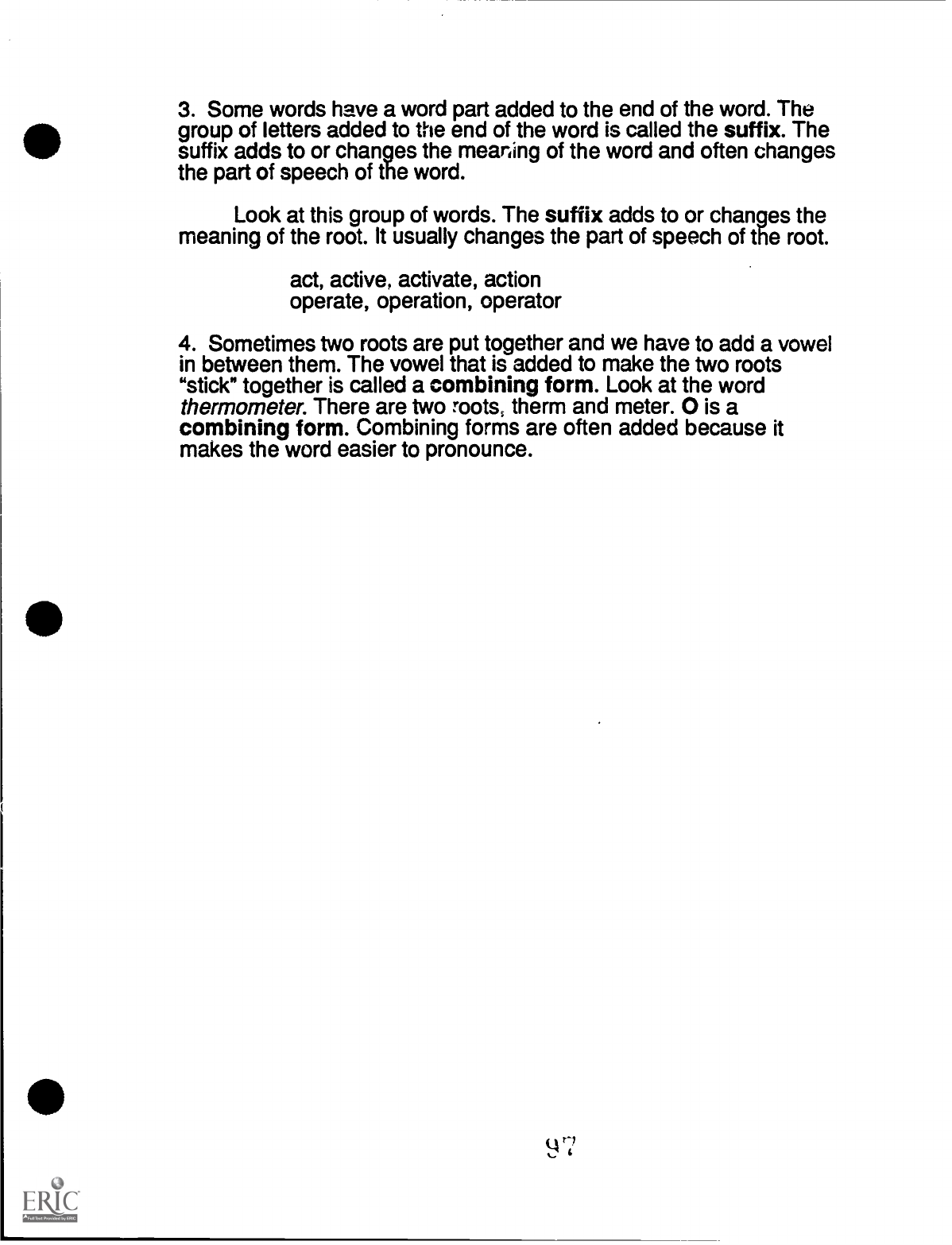
3. Some words have a word part added to the end of the word. The
group of letters added to the end of the word is called the suffix. The
suffix adds to or changes the meaning of the word and often changes
the part of speech of the word.
Look at this group of words. The suffix adds to or changes the
meaning of the root. It usually changes the part of speech of the root.
act, active, activate, action
operate, operation, operator
4. Sometimes two roots are put together and we have to add a vowel
in between them. The vowel that is added to make the two roots
"stick" together is called a combining form. Look at the word
thermometer. There are two roots, therm and meter. 0 is a
combining form. Combining forms are often added because it
makes the word easier to pronounce.
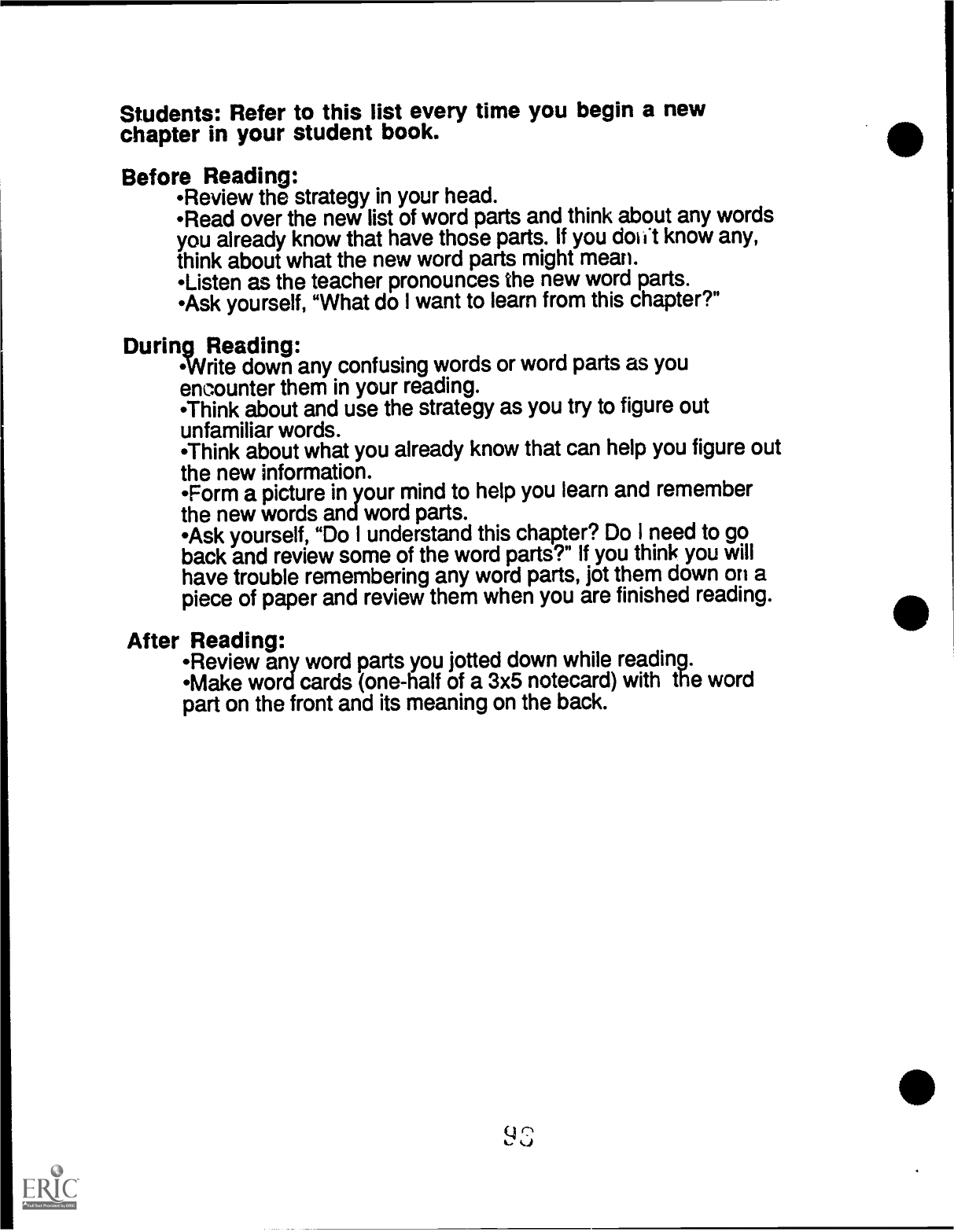
Students: Refer to this list every time you begin a new
chapter in your student book.
Before Reading:
"Review the strategy in your head.
-Read over the new list of word parts and think about any words
you already know that have those parts.
If you doill know any,
think about what the new word parts might mean.
'Listen as the teacher pronounces the new word parts.
-Ask yourself, "What do I want to learn from this chapter?"
During Reading:
-Write down any confusing words or word parts as you
encounter them in your reading.
'Think about and use the strategy as you try to figure out
unfamiliar words.
'Think about what you already know that can help you figure out
the new information.
Form a picture in your mind to help you learn and remember
the new words and word parts.
-Ask yourself, "Do I understand this chapter? Do I need to go
back and review some of the word parts ?" If you think you will
have trouble remembering any word parts, jot them down on a
piece of paper and review them when you are finished reading.
After Reading:
-Review any word parts you jotted down while reading.
-Make word cards (one-half of a 3x5 notecard) with the word
part on the front and its meaning on the back.
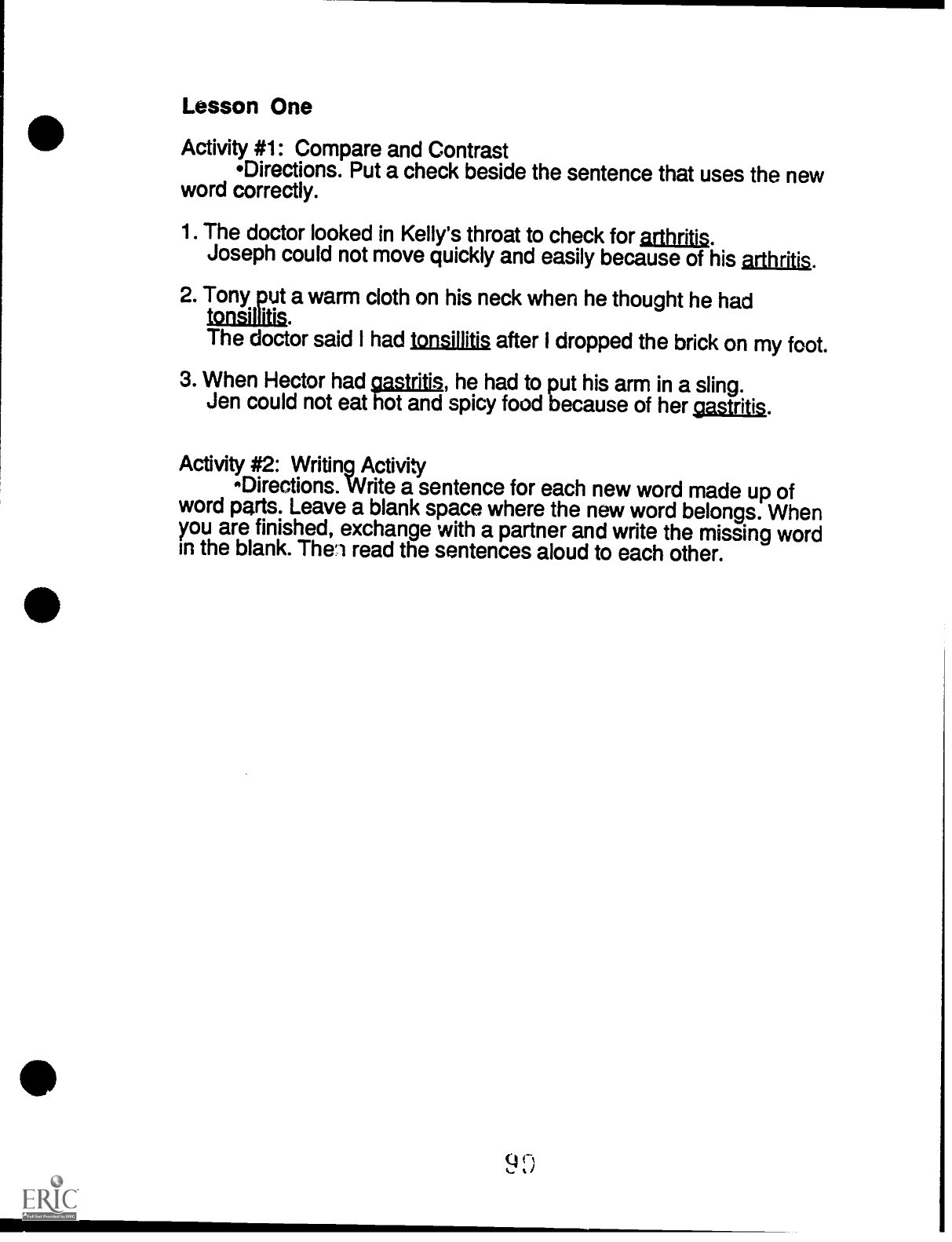
Lesson One
Activity #1: Compare and Contrast
Directions. Put a check beside the sentence that
uses the new
word correctly.
1. The doctor looked in Kelly's throat to check for
Arthritis.
Joseph could not move quickly and easily because
of his Arthritis.
2. Tony put a warm cloth on his neck when he thought
he had
The doctor said I had tonsillitis after I dropped the
brick on my foot.
3. When Hector had gastritis, he had to put his
arm in a sling.
Jen could not eat hot and spicy food because of her
gastritis.
Activity #2: Writing Activity
- Directions. Write a sentence for each new word made
up of
word parts. Leave a blank
space where the new word belongs. When
you are finished, exchange with a partner and write the
missing word
in the blank. Thee read the sentences aloud to each other.
(;)
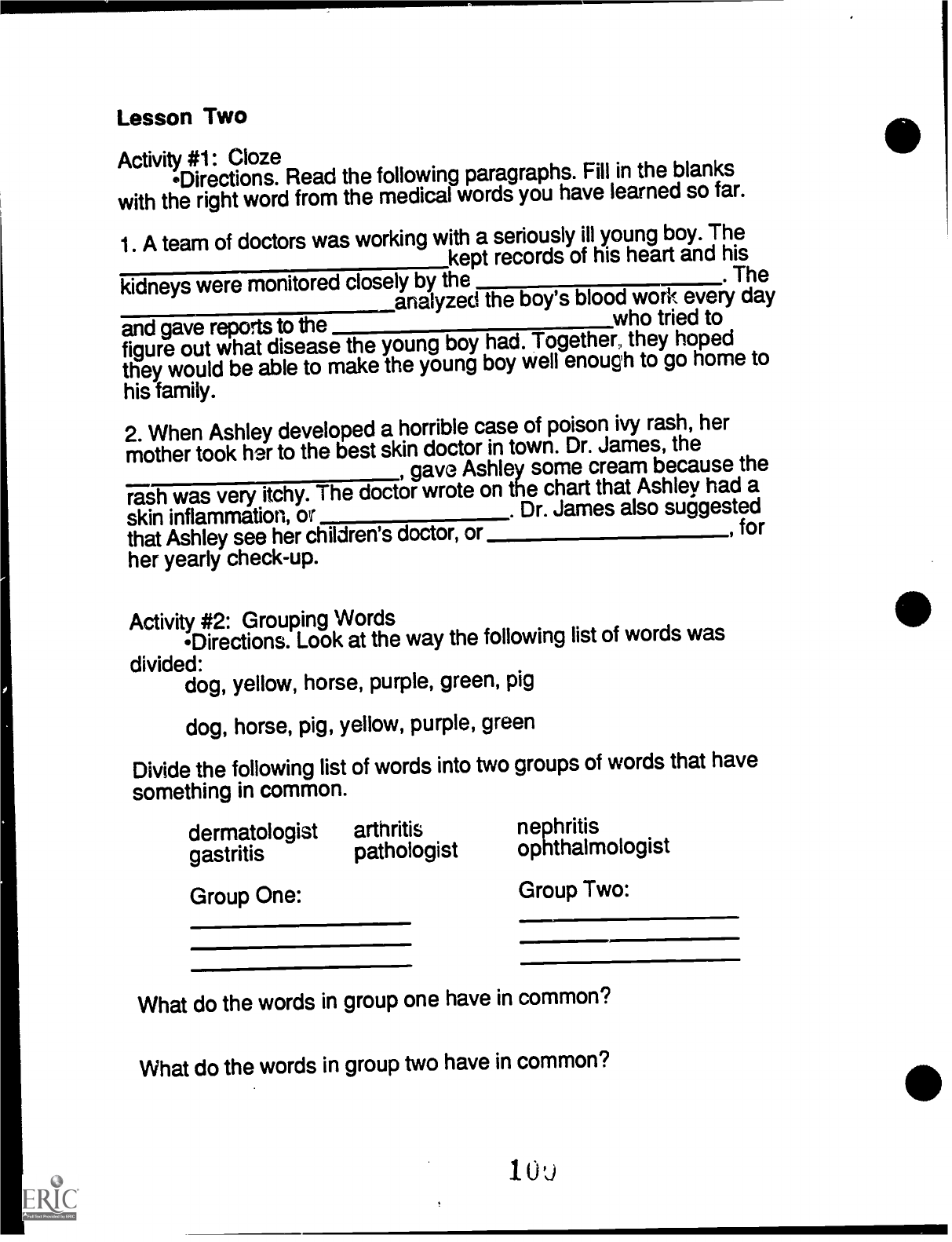
Lesson Two
Activity #1: Cloze
'Directions. Read the following
paragraphs. Fill in the blanks
with the right word from
the medical words you
have learned so far.
1. A team of doctors was
working with a seriously ill young
boy. The
kept records of his heart and
his
kidneys were monitored
closely by the
. The
_analyzed the boy's blood
work every day
and gave reports to the
who tried to
figure out what disease the young
boy had. Together they
hoped
they would be able to
make the young boy well
enough to go home to
his family.
2. When Ashley developed a
horrible case of poison ivy
rash, her
mother took her to the best
skin doctor in town. Dr.
James, the
,
gave Ashley some cream
because the
rash was very itchy. The
doctor wrote on the chart
that Ashley had a
skin inflammation, or
.
Dr. James also suggested
that Ashley see her children's
doctor, or
, for
her yearly check-up.
Activity #2: Grouping Words
-Directions. Look at the way the
following list of words was
divided:
dog, yellow, horse, purple, green,
pig
dog, horse, pig, yellow,
purple, green
Divide the following list of words
into two groups of words that
have
something in common.
dermatologist
arthritis
nephritis
gastritis
pathologist
ophthalmologist
Group One:
Group Two:
What do the words in group one
have in common?
What do the words in group
two have in common?
1 0 u

Activity #3: Maze
-Directions. Circle the best word to fill in the blank
1. Most women see their (neurologist, oncologist, gynecologist) at
least once a year.
2. When John felt a tumor on his neck, he made an appointment with
the (ophthalmologist, oncologist, nephrologist).
3. People who drink too much and take illegal drugs could benefit from
seeing a (pediatrician, hematologist, psychologist).
4. After her eye exam, Carol thanked the (cardiologist,
ophthalmologist, nephrologist).
Activity #4: Use What you Know
-Directions. Use the word parts from the first and second unit to
build words that mean.
inflammation of the kidneys
inflammation of the skin
inflammation of the nerves
Activity #5: Design a Business Card
-Directions. Choose one of the words that describes a person
who is a specialist (cardiologist, gynecologist, dermatologist,
hematologist, neurologist, pathologist, nephrologist, etc.).
Imagine you work for a printing company and you have been asked to
design a business card for that person. Use your name and address
as the name of the specialist on the card. Include a picture that would
serve as a clue to the profession of the person.
10

Lesson Three
Activity #1: Compare and Contrast
-Directions. Put a check mark beside the sentence that uses the
new word correctly.
1. Carlos had 10 stitches in his abdomen after his appendectomy.
The pharmacy will give you the appendectomy.
2. The doctor's assistant put the phobia in the file cabinet.
Mary's mother has a phobia about meeting new people.
3. Sarah's brother was febrile so she put cold cloths on his head.
Ken watched the febrile work on his patient.
4. The Mao= requires the doctor's signature on the prescription.
Rosa took the pharmacy to make her tooth stop hurting.
5. The doctor told Bernie that he needed to have a sonogram.
If you want to get in touch with someone, try sending a sonogram.
6. Debbie did not notice the &junta' paper in her mailbox.
Her abdominal region is very sore and tender.
Activity #2: Think Aloud
-Directions. Take your paper from Activity #1 and work with a
partner. Read the first sentence aloud. Tell your partner how you
would figure out the meaning of "appendectomy" from its word parts
and the clues in the sentence. You should take turns with your partner
on sentences 2-6.
Activity #3: Use What You Know
-Directions. Use the word parts you learned in lessons one, two
and three to build the word that means:
removal of tonsils by surgery
abnormal fear of women
abnormal rear of the heart
instrument for measuring the size of the eye
1'
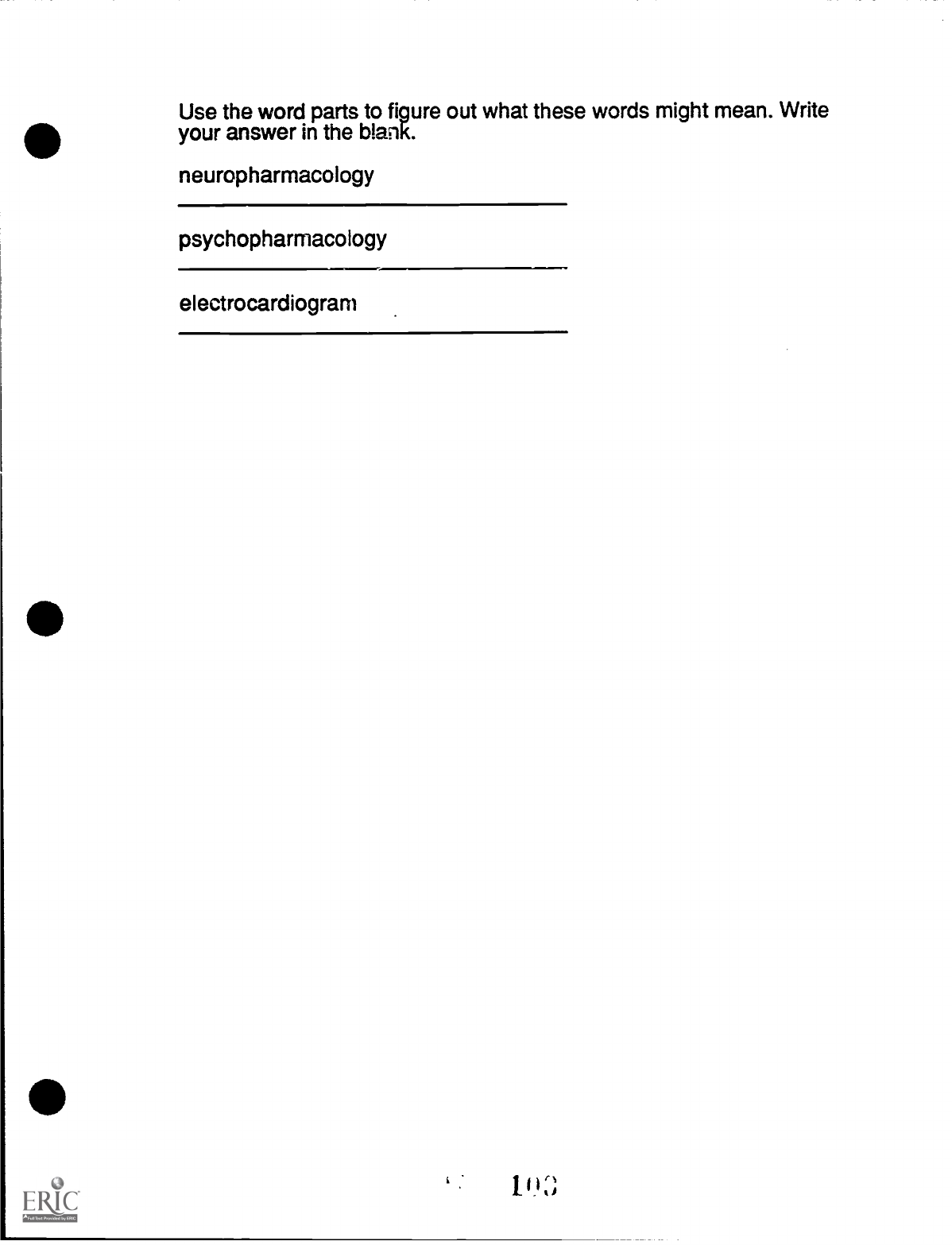
Use the word parts to figure out what these words might mean. Write
your answer in the blank.
neuropharmacology
psychopharmacology
electrocardiogram
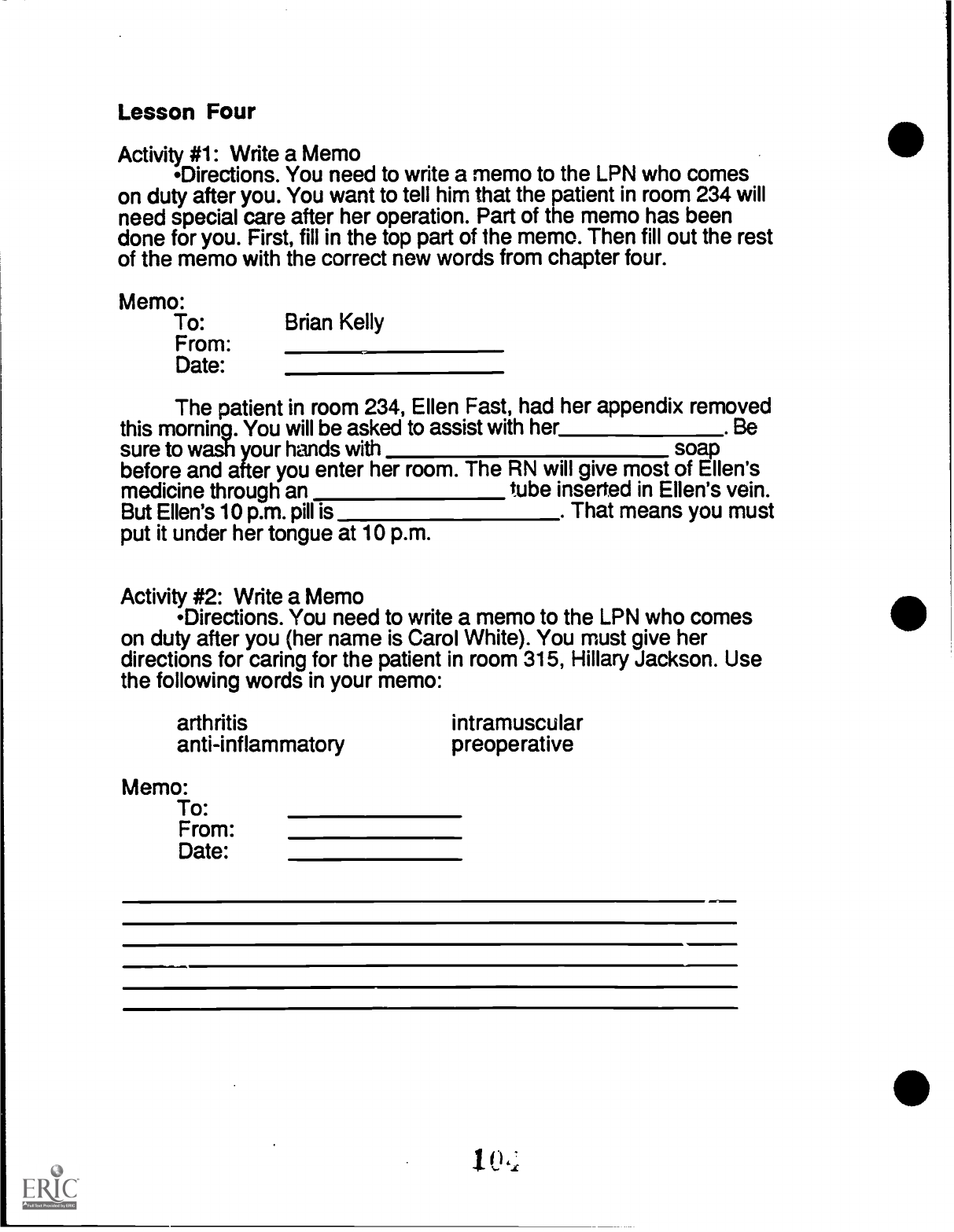
Lesson Four
Activity #1: Write a Memo
'Directions. You need to write a memo to the LPN who comes
on duty after you. You want to tell him that the patient in room 234 will
need special care after her operation. Part of the memo has been
done for you. First, fill in the top part of the memo. Then fill out the rest
of the memo with the correct new words from chapter four.
Memo:
To:
Brian Kelly
From:
Date:
The patient in room 234, Ellen Fast, had her appendix removed
this morning. You will be asked to assist with her
. Be
sure to wash your hands with
soap
before and after you enter her room. The RN will give most of Ellen's
medicine through an
tube inserted in Ellen's vein.
But Ellen's 10 p.m. pill is
.
That means you must
put it under her tongue at 10 p.m.
Activity #2: Write a Memo
'Directions. You need to write a memo to the LPN who comes
on duty after you (her name is Carol White). You must give her
directions for caring for the patient in room 315, Hillary Jackson. Use
the following words in your memo:
arthritis
intramuscular
anti-inflammatory preoperative
Memo:
To:
From:
Date:
1 4;
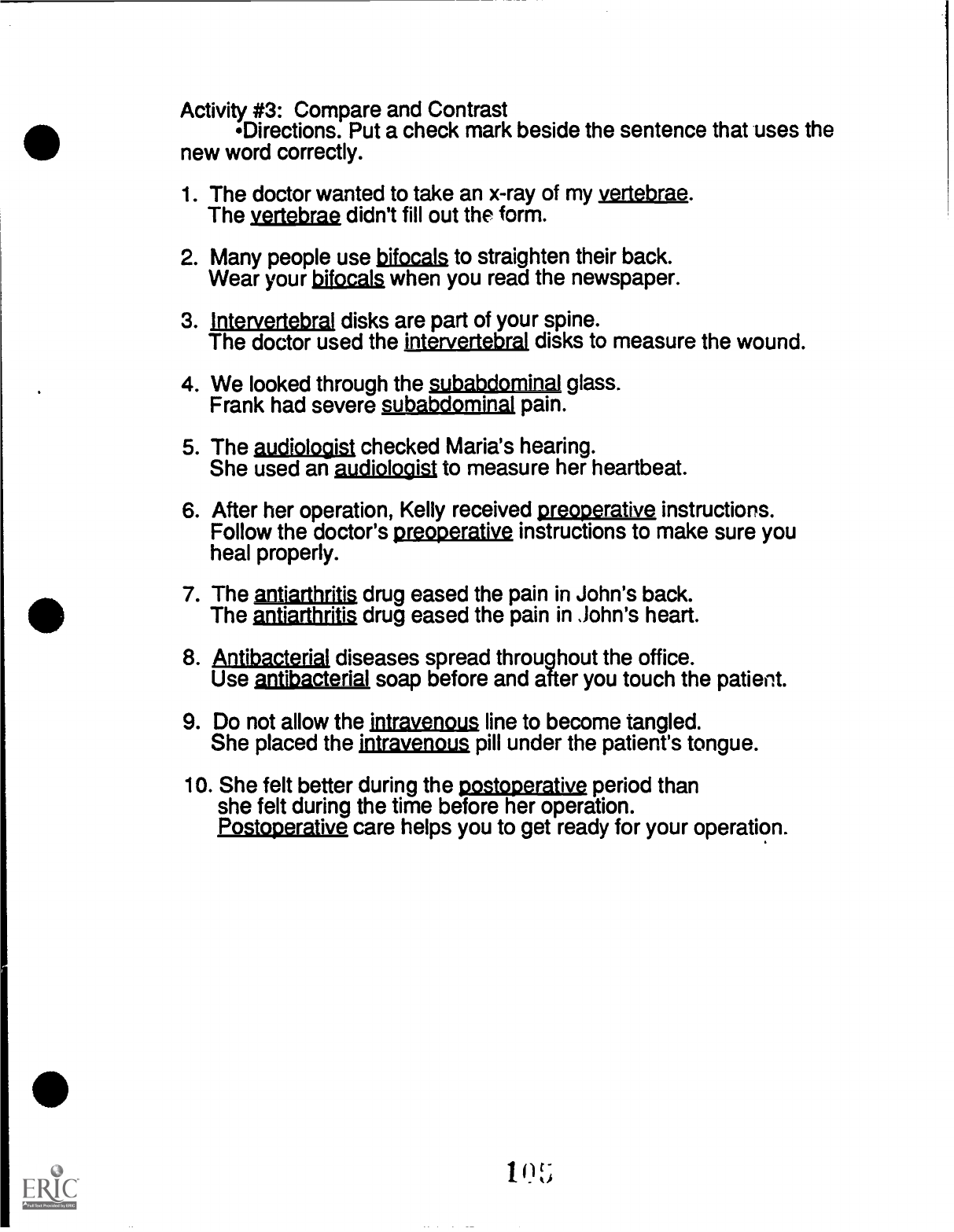
Activity #3: Compare and Contrast
'Directions. Put a check mark beside the sentence that uses the
new word correctly.
1. The doctor wanted to take an x-ray of my vertebrae.
The vertebrae, didn't fill out the form.
2. Many people use bifocals to straighten their back.
Wear your bifocals when you read the newspaper.
3. Intervertebral disks are part of your spine.
The doctor used the intervertebral disks to measure the wound.
4. We looked through the subabdominal glass.
Frank had severe
subabdominal,
pain.
5. The audiologist checked Maria's hearing.
She used an audiologist to measure her heartbeat.
6. After her operation, Kelly received preoperative instructions.
Follow the doctor's preoperative instructions to make sure you
heal properly.
7. The antiarthritis drug eased the pain in John's back.
The antiarthritis drug eased the pain in .John's heart.
8. Antibacterial diseases spread throughout the office.
Use antibacterial soap before and after you touch the patient.
9. Do not allow the intravenous line to become tangled.
She placed the jntravenous pill under the patient's tongue.
10. She felt better during the postoperative period than
she felt during the time before her operation.
Postoperative care helps you to get ready for your operation.
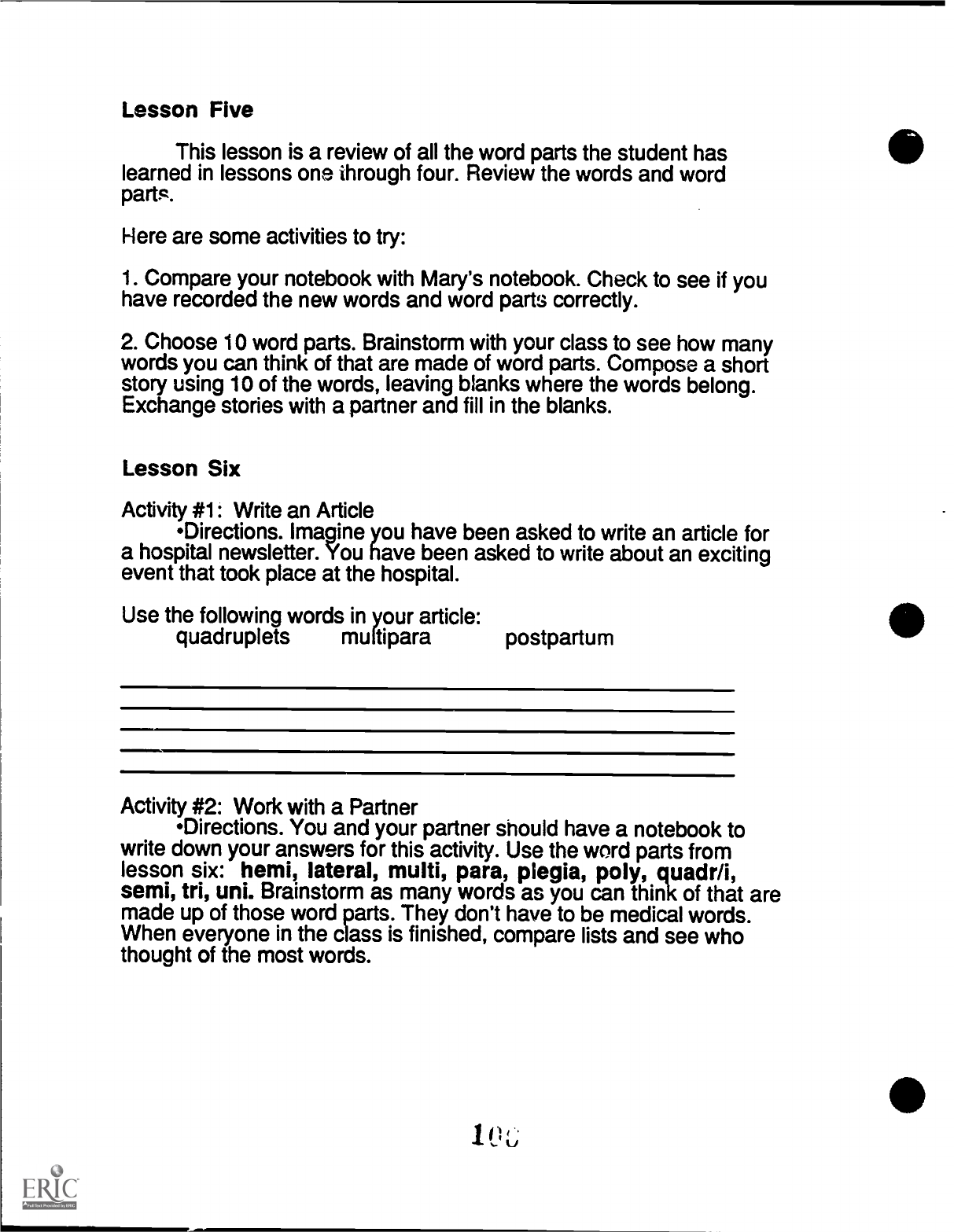
Lesson Five
This lesson is a review of all the word parts the student has
learned in lessons one Through four. Review the words and word
parts.
Here are some activities to try:
1. Compare your notebook with Mary's notebook. Check to see if
you
have recorded the new words and word parts correctly.
2. Choose 10 word parts. Brainstorm with your class to see how many
words you can think of that are made of word parts. Compose a short
story using 10 of the words, leaving blanks where the words belong.
Exchange stories with a partner and fill in the blanks.
Lesson Six
Activity #1: Write an Article
Directions. Imagine you have been asked to write an article for
a hospital newsletter. You have been asked to write about an exciting
event that took place at the hospital.
Use the following words in your article:
quadruplets
mu ltipara
postpartum
Activity #2: Work with a Partner
Directions. You and your partner should have a notebook to
write down your answers for this activity. Use the word parts from
lesson six: hemi, lateral, multi, para, plegia, poly, quadr/i,
semi, tri, uni. Brainstorm as many words as you can think of that
are
made up of those word parts. They don't have to be medical words.
When everyone in the class is finished, compare lists and
see who
thought of the most words.
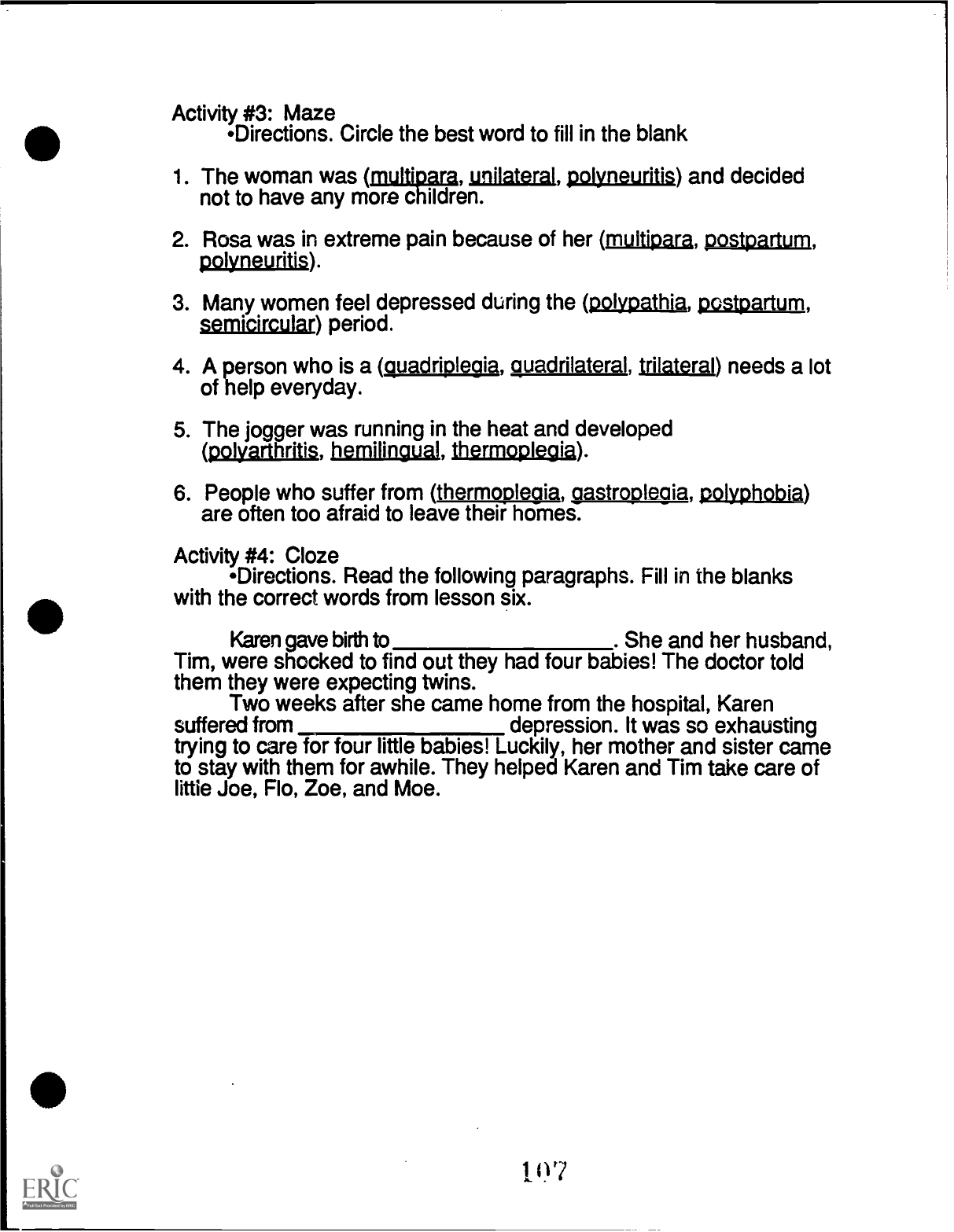
Activity #3: Maze
-Directions. Circle the best word to fill in the blank
1. The woman was (
,
unilateral, polyneuritis) and decided
not to have any more c ildren.
2. Rosa was in extreme pain because of her (multipara, postpartum,
polyneuritis).
3. Many women feel depressed during the (polypathia, postpartum,
semicircular) period.
4. A person who is a (quadriplegia, quadrilateral, trilateral) needs a lot
of help everyday.
5. The jogger was running in the heat and developed
(polyarthritis, hemilingual, thermoplegia).
6. People who suffer from (thermoplegia, gastroplegia, polyphobia)
are often too afraid to leave their homes.
Activity #4: Cloze
-Directions. Read the following paragraphs. Fill in the blanks
with the correct words from lesson six.
Karen gave birth to
. She and her husband,
Tim, were shocked to find out they had four babies! The doctor told
them they were expecting twins.
Two weeks after she came home from the hospital, Karen
suffered from
depression. It was so exhausting
trying to care for four little babies! Luckily, her mother and sister came
to stay with them for awhile. They helped Karen and Tim take care of
little Joe, Flo, Zoe, and Moe.
11)7
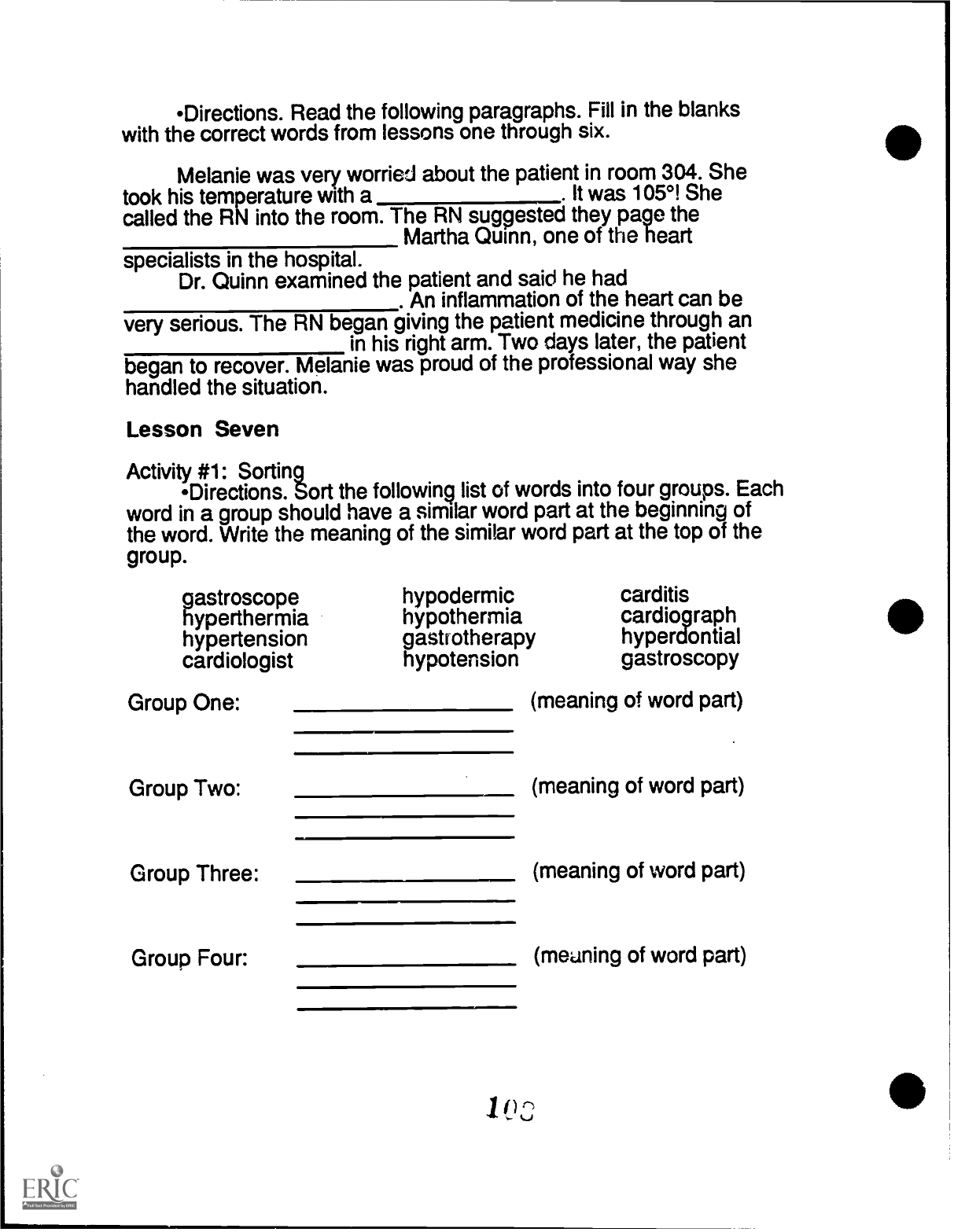
'Directions. Read the following paragraphs. Fill in the blanks
with the correct words from lessons one through six.
Melanie was very worried about the patient in room 304. She
took his temperature with a
.
It was 105 °! She
called the RN into the room. The RN suggested they page the
Martha Quinn, one of the heart
specialists in the hospital.
Dr. Quinn examined the patient and said he had
.
An inflammation of the heart can be
very serious. The RN began giving the
patient medicine through an
in his right arm. Two days later, the patient
began to recover. Melanie was proud of the professional way she
handled the situation.
Lesson Seven
Activity #1: Sorting
-Directions. Sort the following list of words into four groups. Each
word in a group should have a similar word part at the beginning of
the word. Write the meaning of the similar word part at the top of the
group.
gastroscope
hypodermic
carditis
hyperthermia
hypothermia
cardiograph
hypertension
gastrotherapy
hyperdontial
cardiologist
hypotension
gastroscopy
Group One:
(meaning of word part)
Group Two:
(meaning of word part)
Group Three:
(meaning of word part)
Group Four:
(meaning of word part)
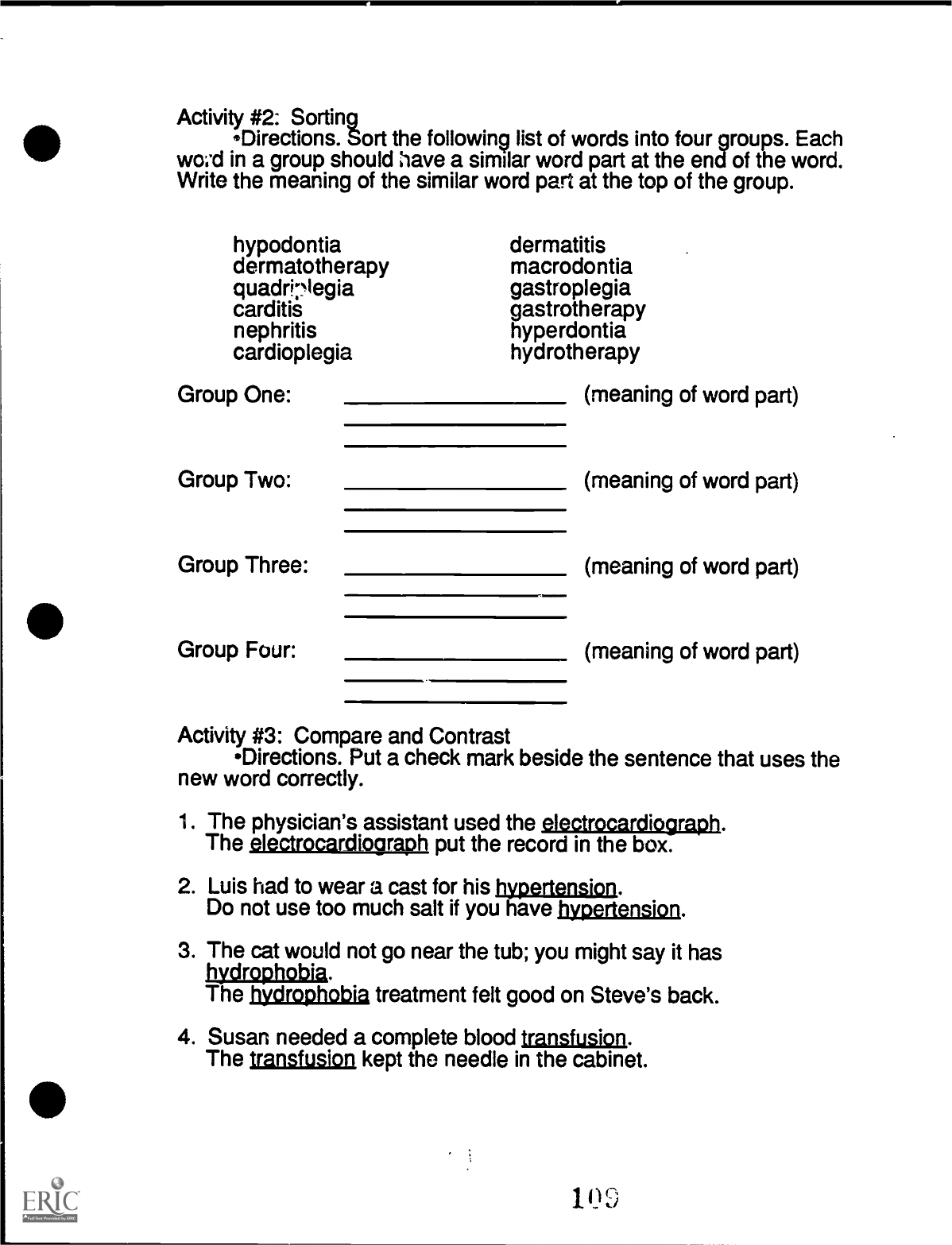
Activity #2: Sorting
'Directions. Sort the following list of words into four groups. Each
wax' in a group should have a similar word part at the end of the word.
Write the meaning of the similar word part at the top of the group.
hypodontia
dermatitis
dermatotherapy
macrodontia
quadri:legia gastroplegia
carditis gastrotherapy
nephritis
hyperdontia
cardioplegia
hydrotherapy
Group One:
(meaning of word part)
Group Two:
(meaning of word part)
Group Three:
(meaning of word part)
Group Four:
(meaning of word part)
Activity #3: Compare and Contrast
'Directions. Put a check mark beside the sentence that uses the
new word correctly.
1. The physician's assistant used the electrocardiograph.
The electrocardiograph put the record in the box.
2. Luis had to wear a cast for his hypertension.
Do not use too much salt if you have hypertension.
3. The cat would not go near the tub; you might say it has
hydrophobia.
The hydrophobia treatment felt good on Steve's back.
4. Susan needed a complete blood transfusion.
The transfusion kept the needle in the cabinet.
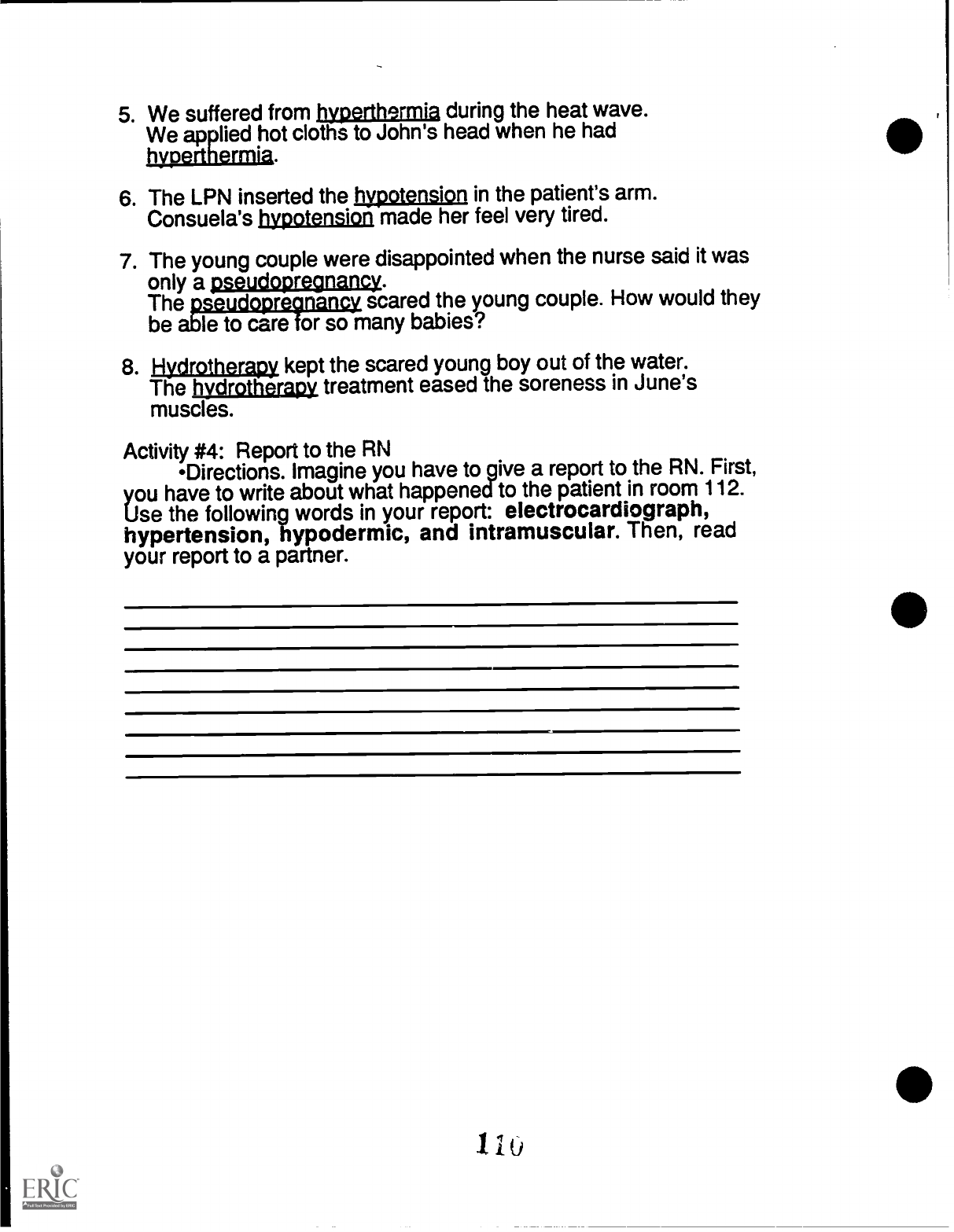
5. We suffered from hyperthermia during
the heat wave.
We applied hot cloths to John's head when he
had
hyperthermia.
6. The LPN inserted the hypotension
in the patient's arm.
Consuela's hypotension made her feel very tired.
7. The young couple were disappointed when
the nurse said it was
only a pseudopregnancy.
The pseudoprggnancy scared the young couple.
How would they
be able to care for so many babies?
8. Hydrotherapy kept the scared young boy out
of the water.
The hydrotherapy, treatment eased the soreness
in June's
muscles.
Activity #4: Report to the RN
-Directions. Imagine you have to give a report to the
RN. First,
you have to write about what
happened to the patient in room 112.
Use the following words in your report:
electrocardiograph,
hypertension, hypodermic, and intramuscular.
Then, read
your report to a partner.
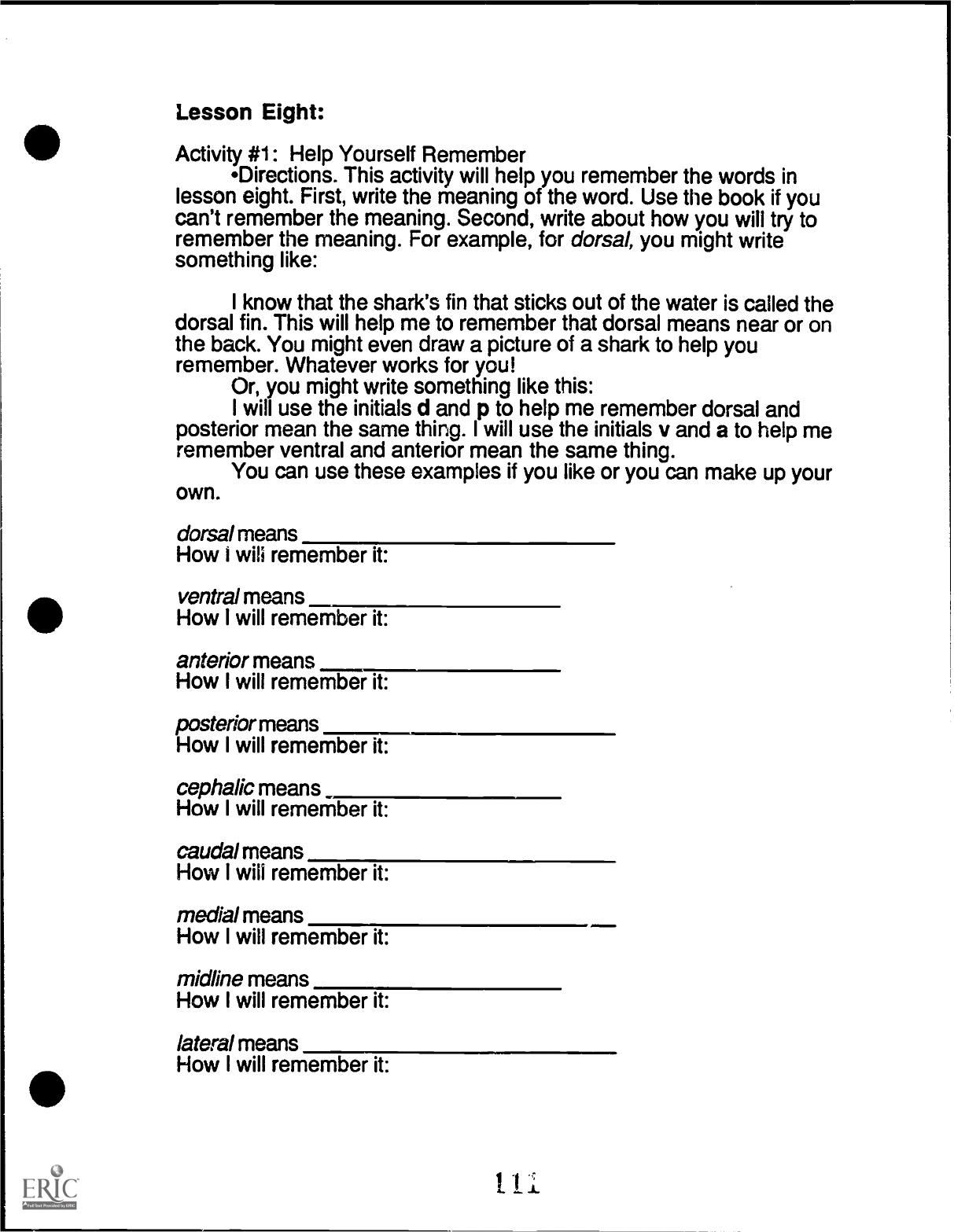
Lesson Eight:
Activity #1: Help Yourself Remember
Directions. This activity will help you remember the words in
lesson eight. First, write the meaning of the word. Use the book if you
can't remember the meaning. Second, write about how you will try to
remember the meaning. For example, for dorsal, you might write
something like:
I know that the shark's fin that sticks out of the water is called the
dorsal fin. This will help me to remember that dorsal means near or on
the back. You might even draw a picture of a shark to help you
remember. Whatever works for you!
Or, you might write something like this:
I will use the initials d and p to help me remember dorsal and
posterior mean the same thing. I will use the initials v and a to help me
remember ventral and anterior mean the same thing.
You can use these examples if you like or you can make up your
own.
dorsal means
How I will remember it:
ventral means
How I will remember it:
anterior means
How I will remember it:
posterior means
How I will remember it:
cephalic means
How I will remember it:
caudal means
How I will remember it:
medial means
How I will remember it:
midline means
How I will remember it:
lateral means
How I will remember it:

Activity #2: Label the Figures
-Directions. Label each drawing with the correct word. Choose
from the following words:
anterior
midline
medial
DORSAL
POSTERIOR
dorsal
caudal
cephalic
lateral
posterior
ventral
VENTRAL
ANTERIOR
Activity #3: Make a Compare and Contrast Exercise
-Directions. In some of the activities, you were asked to choose
the sentence that used the new word correctly. For example:
Debbie did not notice the Abdominal paper in her mailbox.
Her abdominal region is very sore and tender.
For this activity, you will have to make a similar exercise for your
partner. Use the following words dorsal, posterior, midline,
medial, lateral, ventral, anterior, caudal, cephalic
Remember to make one sentence that uses the word correctly
and one that does not, When you are finished, exchange papers with
your partner.
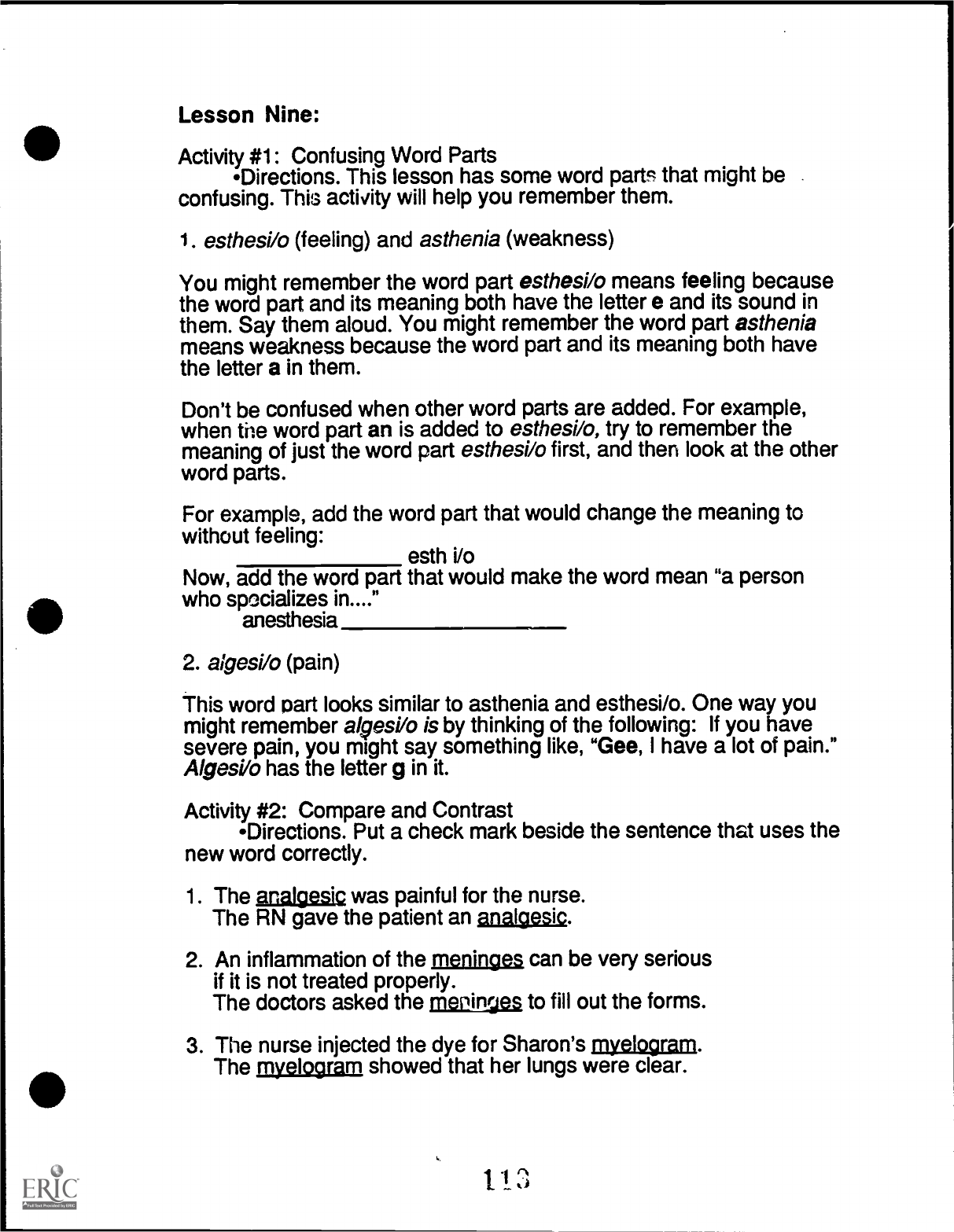
Lesson Nine:
Activity #1: Confusing Word Parts
-Directions. This lesson has some word parts that might be
confusing. This activity will help you remember them.
1. esthesi/o (feeling) and asthenia (weakness)
You might remember the word part esthesi/o means feeling because
the word part and its meaning both have the letter e and its sound in
them. Say them aloud. You might remember the word part asthenia
means weakness because the word part and its meaning both have
the letter a in them.
Don't be confused when other word parts are added. For example,
when the word part an is added to esthesi/o, try to remember the
meaning of just the word part esthesi/o first, and then look at the other
word parts.
For example, add the word part that would change the meaning to
without feeling:
esth i/o
Now, add the word part that would make the word mean "a person
who specializes in...."
anesthesia
2. algesYo (pain)
This word part looks similar to asthenia and esthesi/o. One way you
might remember algesi/o is by thinking of the following:
If you have
severe pain, you might say something like, "Gee, I have a lot of pain."
Algesi/o has the letter g in it.
Activity #2: Compare and Contrast
-Directions. Put a check mark beside the sentence that uses the
new word correctly.
1. The analgesic was painful for the nurse.
The RN gave the patient an analgesic.
2. An inflammation of the meninges can be very serious
if it is not treated properly.
The doctors asked the motras to fill out the forms.
3. The nurse injected the dye for Sharon's myelogram.
The myelogram showed that her lungs were clear.
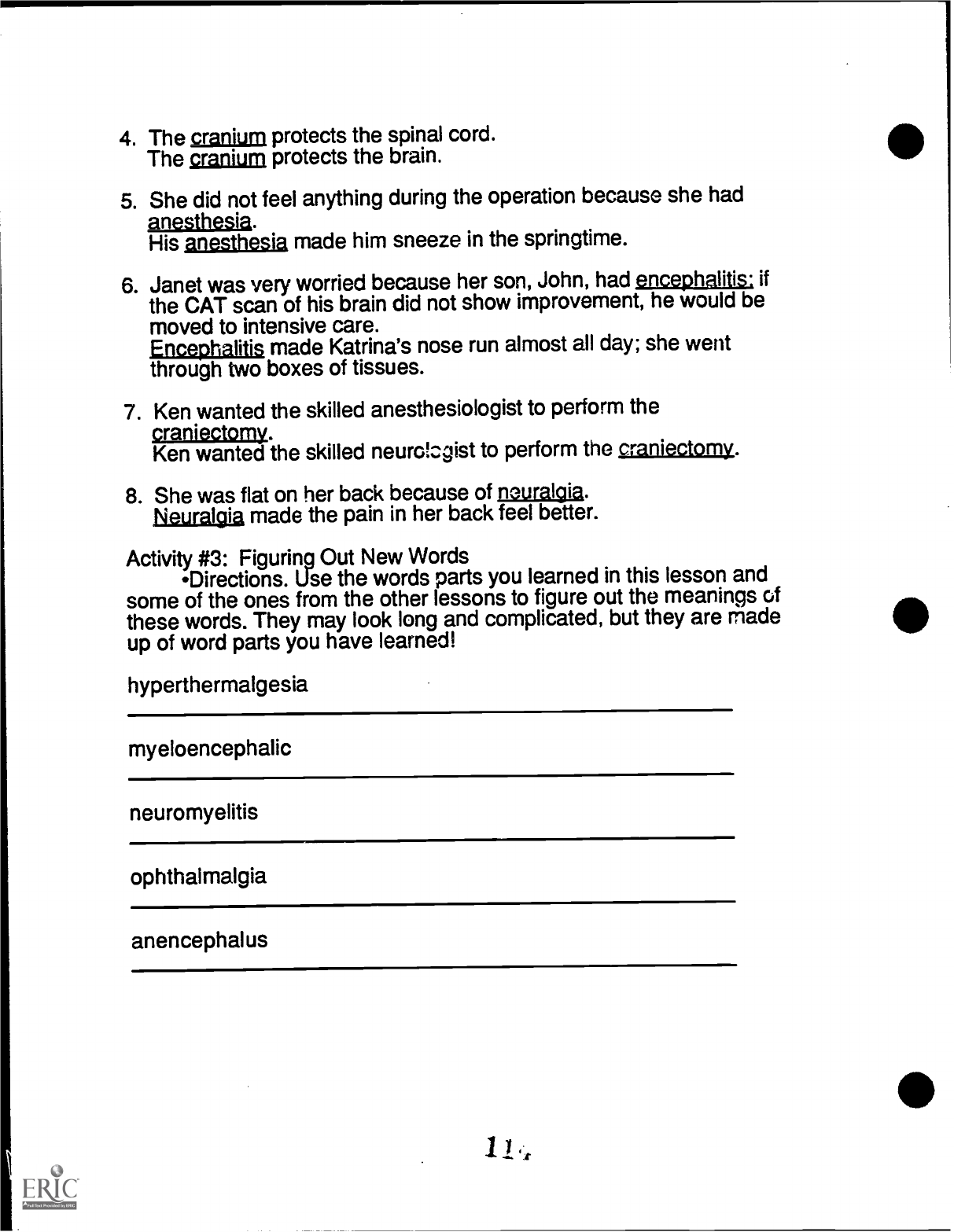
4. The cranium protects the spinal
cord.
The cranium protects the brain.
5. She did not feel anything during
the operation because she had
anesthesia.
His anesthesia made him sneeze in the
springtime.
6. Janet was very worried because
her son, John, had encephalitis; if
the CAT scan of his brain did not show
improvement, he would be
moved to intensive care.
Encephalitis made Katrina's nose run almost
all day; she went
through two boxes of tissues.
7. Ken wanted the skilled anesthesiologist to
perform the
craniectomy.
Ken wanted the skilled neuro!::.gist to
perform the craniectomy.
8. She was flat on her back because of
neuralgia.
Neuralgia made the pain in her back
feel better.
Activity #3: Figuring Out New Words
-Directions. Use the words parts you learned in this lesson
and
some of the ones from the other
lessons to figure out the meanings of
these words. They may look long and complicated,
but they are made
up of word parts you have
learned!
hyperthermalgesia
myeloencephalic
neuromyelitis
ophthaimalgia
anencephalus
t

Lesson Ten
This lesson is a review of all the word parts you have learned in
lessons one through nine. Review the words and word parts.
Here are some activities to try:
1. Make up imaginary phobias using word parts from the story. Draw
pictures or role play your stories.
2. Role playing is a good way to practice saying new words and word
parts aloud. Develop case studies similar to the one you did in
lesson seven, Activity #4.
3. Go through your notebook and cover up the word part; read the
meaning and try to guess the word part.
Lesson Eleven
Activity #1: Case Study
-Directions. Read the case study. Fill in the blanks with words
from lesson ten or words you already learned.
Judy was very unhealthy in the winter of 1992. It all began with a
pain in her liver which turned into an inflammation. The doctor
diagnosed it as . He prescribed an
to relieve the pain. He also told her to be extra careful about washing
her hands; he said she should always use
soap.
When that cleared up, Judy lived through one of the most
frightening experiences of her life. She found a lump during a self-
exam of her breast! She was afraid she would have to have a
.
Fortunately, the doctor did some tests and
discovered that the lump was not serious.
1.
5
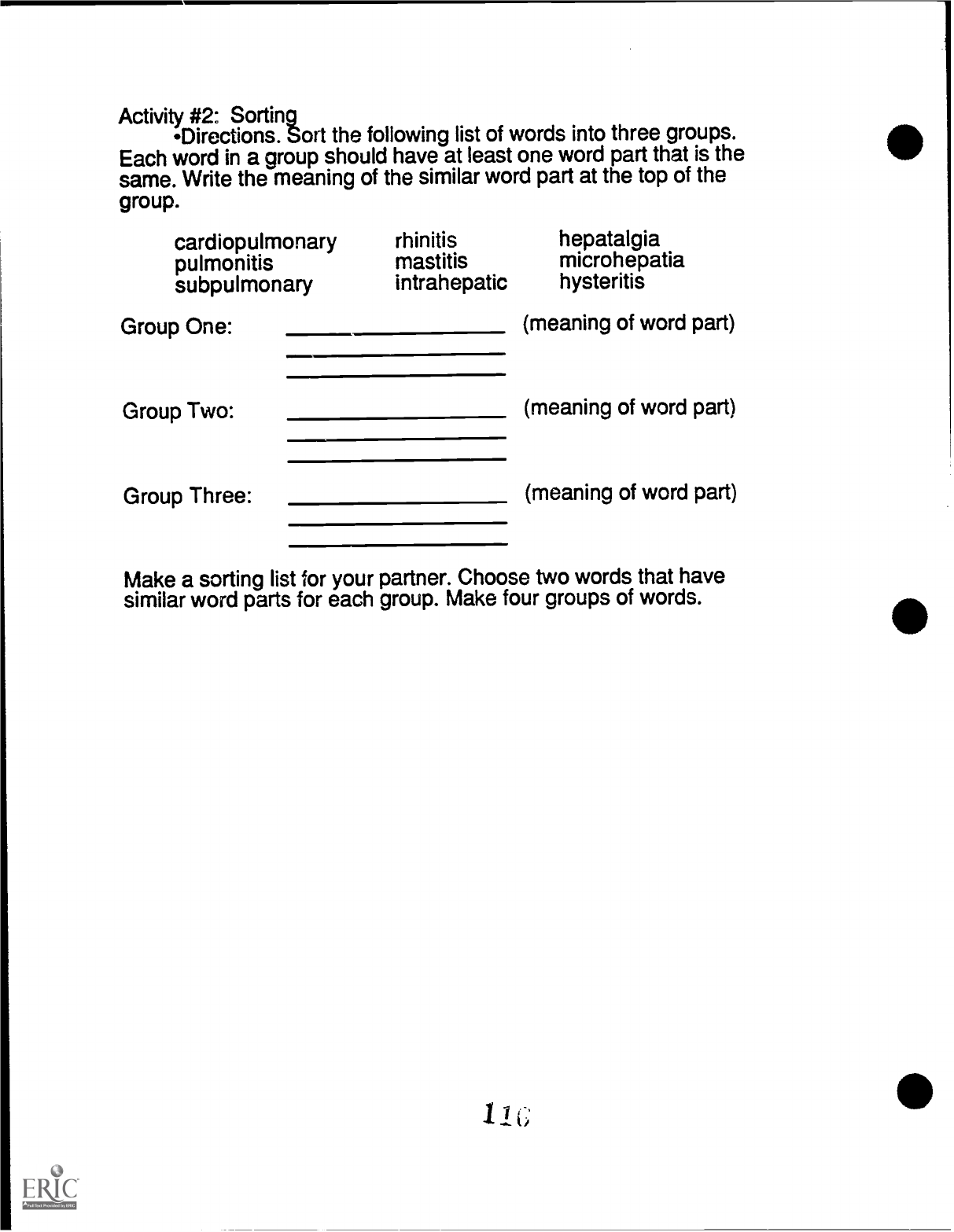
Activity #2: Sorting
-Directions. Sort the following list of words into three groups.
Each word in a group should have at least one word part
that is the
same. Write the meaning of the
similar word part at the top of the
group.
cardiopulmonary
rhinitis
hepatalgia
pulmonitis
mastitis
microhepatia
subpulmonary
intrahepatic
hysteritis
Group One:
(meaning of word part)
Group Two:
(meaning of word part)
Group Three:
(meaning of word part)
Make a sorting list for your partner. Choose two words that have
similar word parts for each group. Make four groups of words.

Activity #3: Write a Memo
-Directions. You need to write a memo to the LPN who comes
on duty after you (his name is Joseph Torelli). You must give
him
directions for caring for the patient in room 304, Marion Cullen. Use
the following words in your memo:
otitis, otologist, rhinalgia, rhinesthesia.
You can also use other health care words if you like.
Memo:
To:
From:
Date:
Lesson Twelve
Activity #1: Confusing Word Parts
1. myel/o (spinal cord) and my/o (muscle)
You might remember that myel/o has the letter I in it that kind of looks
like the spinal cord. Or, you can think of a different way to remember
the difference between the two word parts. Write about your way
below:
Write a sentence using the word myostitis. Write another sentence
using the word myelitis.
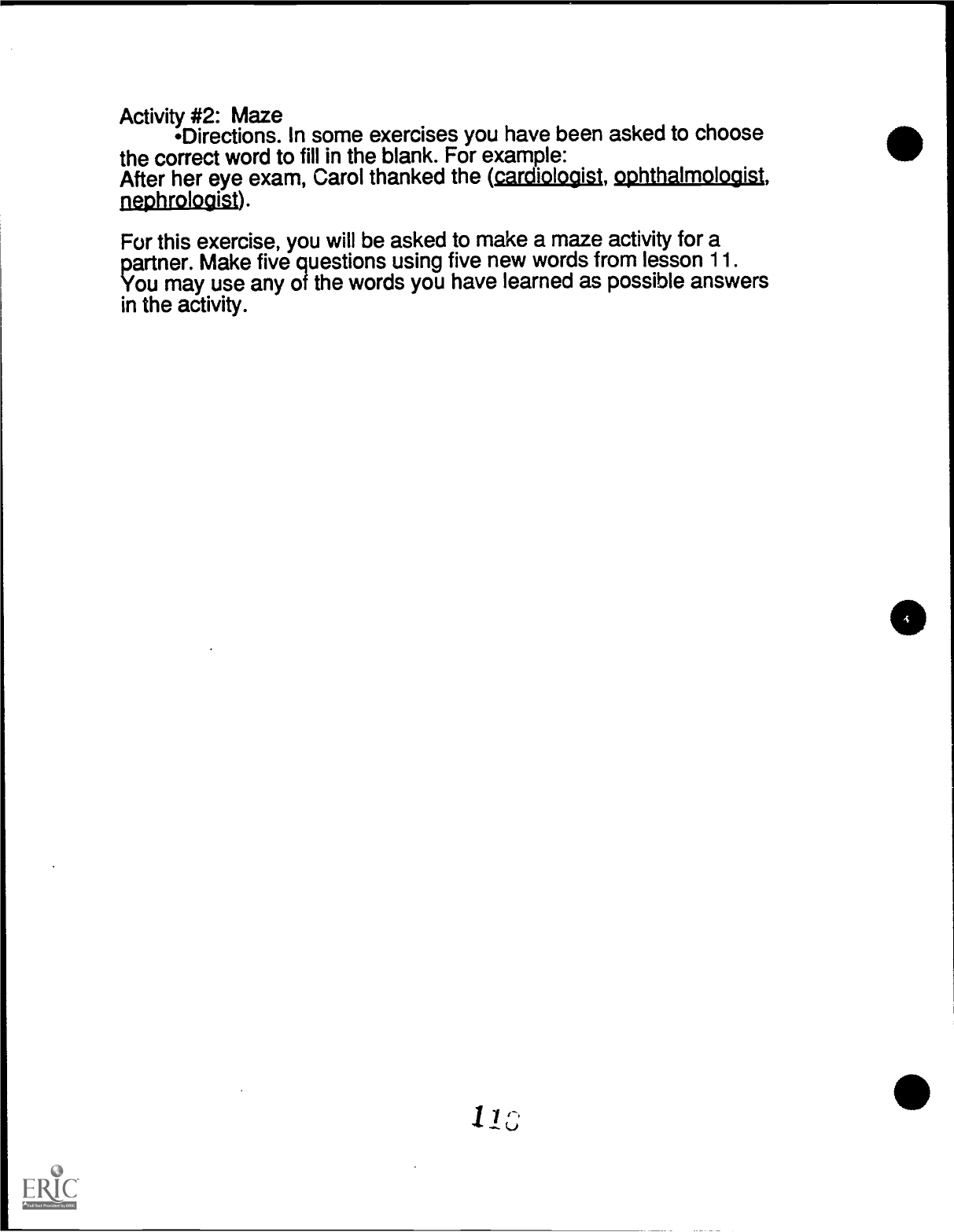
Activity #2: Maze
-Directions. In some exercises you have been asked to choose
the correct word to fill in the blank. For example:
After her eye exam, Carol thanked the (cardiologist, ophthalmologist,
nephrologist).
For this exercise, you will be asked to make a maze activity for a
partner. Make five questions using five new words from lesson 11.
You may use any of the words you have learned as possible answers
in the activity.
1
c;
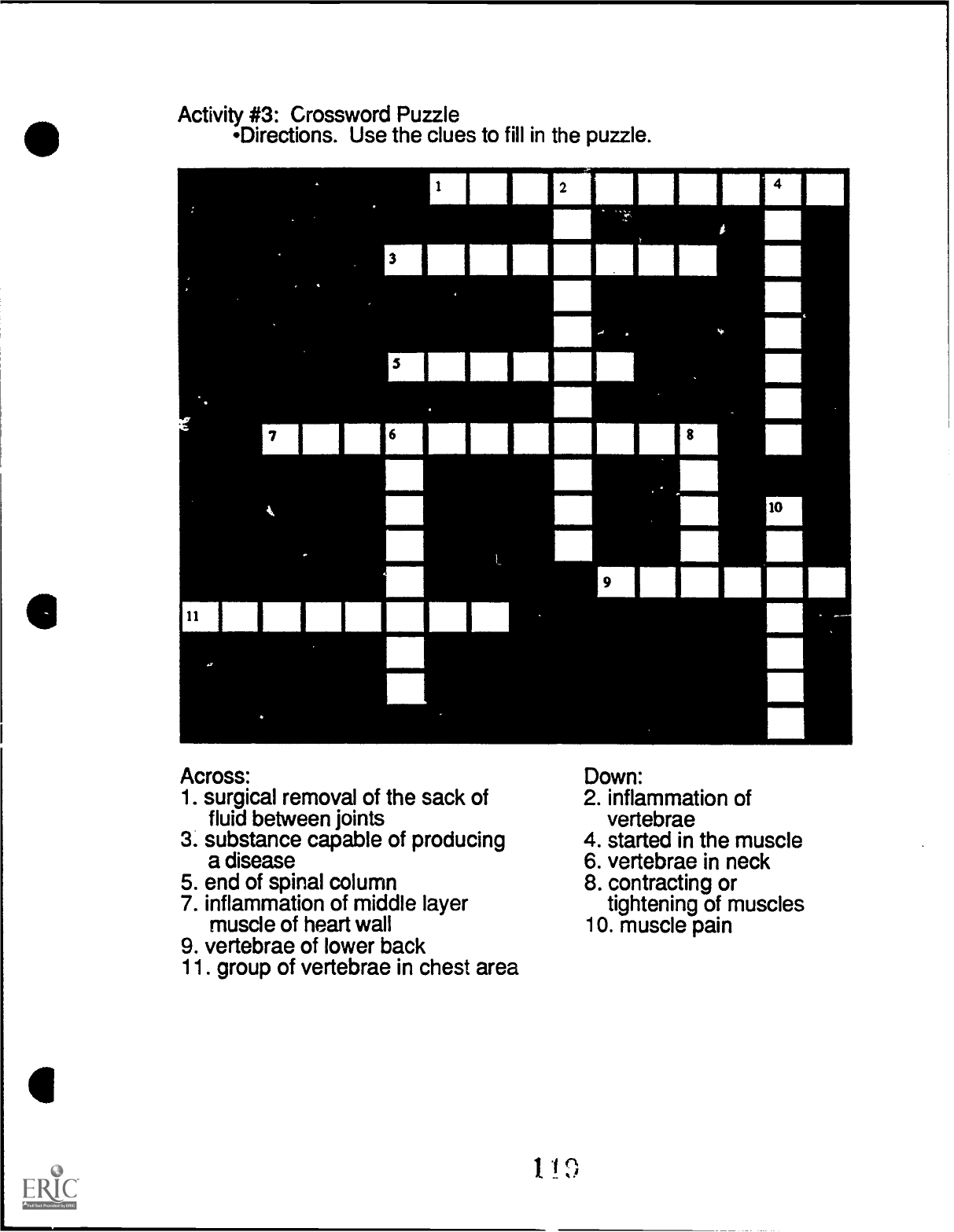
Activity #3: Crossword Puzzle
-Directions. Use the clues to fill in the puzzle.
3
5
7
6
11
1
Across:
1. surgical removal of the sack of
fluid between joints
3. substance capable of producing
a disease
5. end of spinal column
7. inflammation of middle layer
muscle of heart wall
9. vertebrae of lower back
11. group of vertebrae in chest area
2
8
9
4
10
Down:
2. inflammation of
vertebrae
4. started in the muscle
6. vertebrae in neck
8. contracting or
tightening of muscles
10. muscle pain

Lesson Thirteen
Activity #1: Sorting
Directions. Sort the following list of words into four groups. Each
word in a group should have a similar word part. Write the meaning of
the similar word part at the to' of the group.
costal
spondylomalacia
toxicologist
rhinoplasty
intercostal
myomalacia
toxic
plastic surgeon
costectomy
cardiomalacia
toxicophobia
otoplasty
Group One:
(meaning of word part)
Group Two:
(meaning of word part)
Group Three:
(meaning of word part)
Group Four:
(meaning of word part)
Activity #2: Report to the RN
Directions. Imagine you have to give a report to the RN. First,
you have to write about what happened to the patient in room 112.
Use the following words in your report: antitoxin, neonatal,
tachycardia. Then, read your report to a partner.
12
1,)

Activity #3: Figuring out New Words
-Directions. Use the word parts you learned in this lesson and
the other lessons to figure out the meanings of these words. They
may look long and complicated but they are only made up of word
parts you have learned!
cardiosclerosis
gastropiasty
meningioma
otoplasty
podoedema
toxicodermatitis
vertebrocostal
thoracoplasty
craniomalacia
hepatoma

Pre/Post
Tests
122
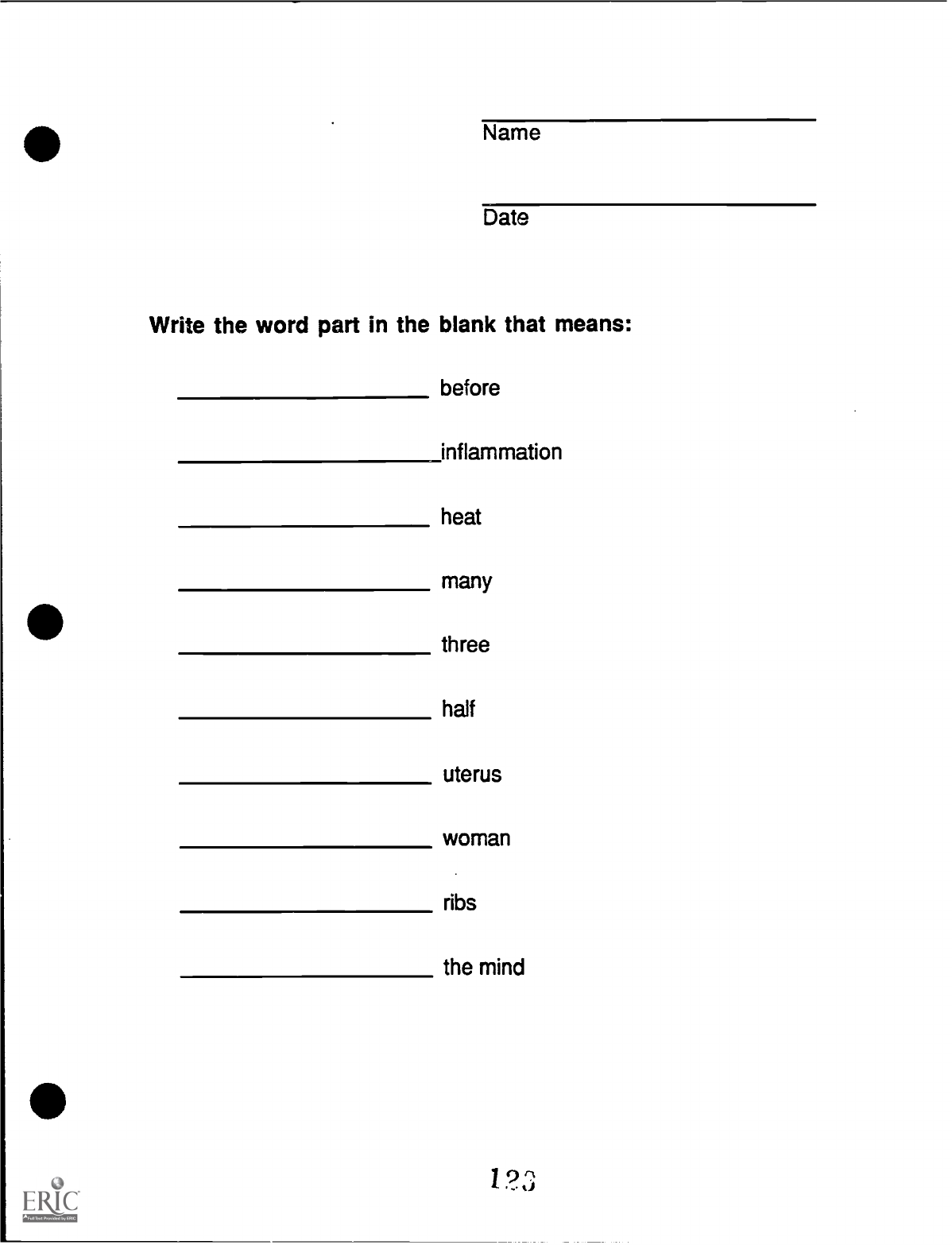
Name
Date
Write the word part in the blank that means:
before
inflammation
heat
many
three
half
uterus
woman
ribs
the mind
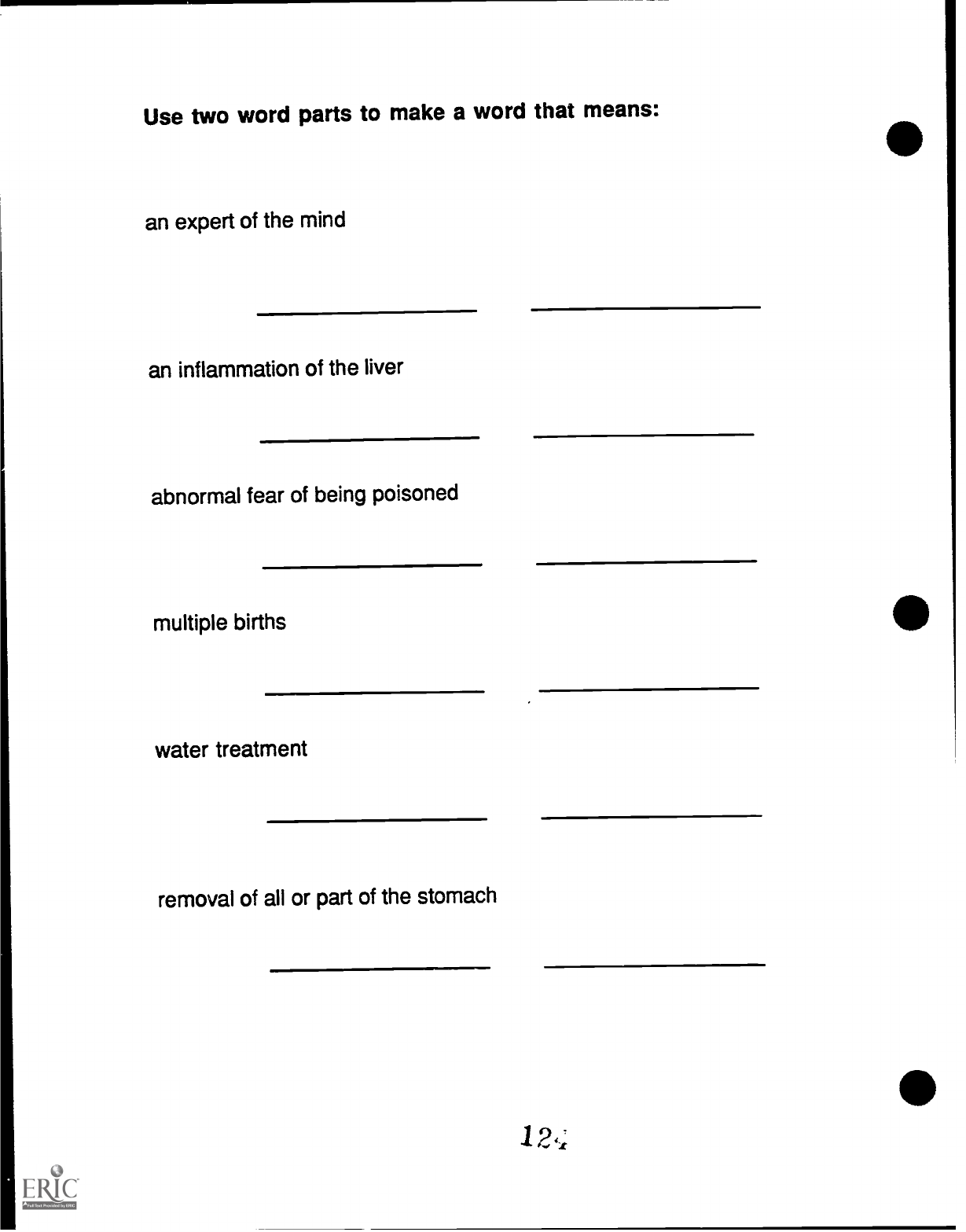
Use two word parts to
make a word that means:
an expert of the
mind
an inflammation of
the liver
abnormal fear of being poisoned
multiple births
water treatment
removal of all or part of the stomach
124.;
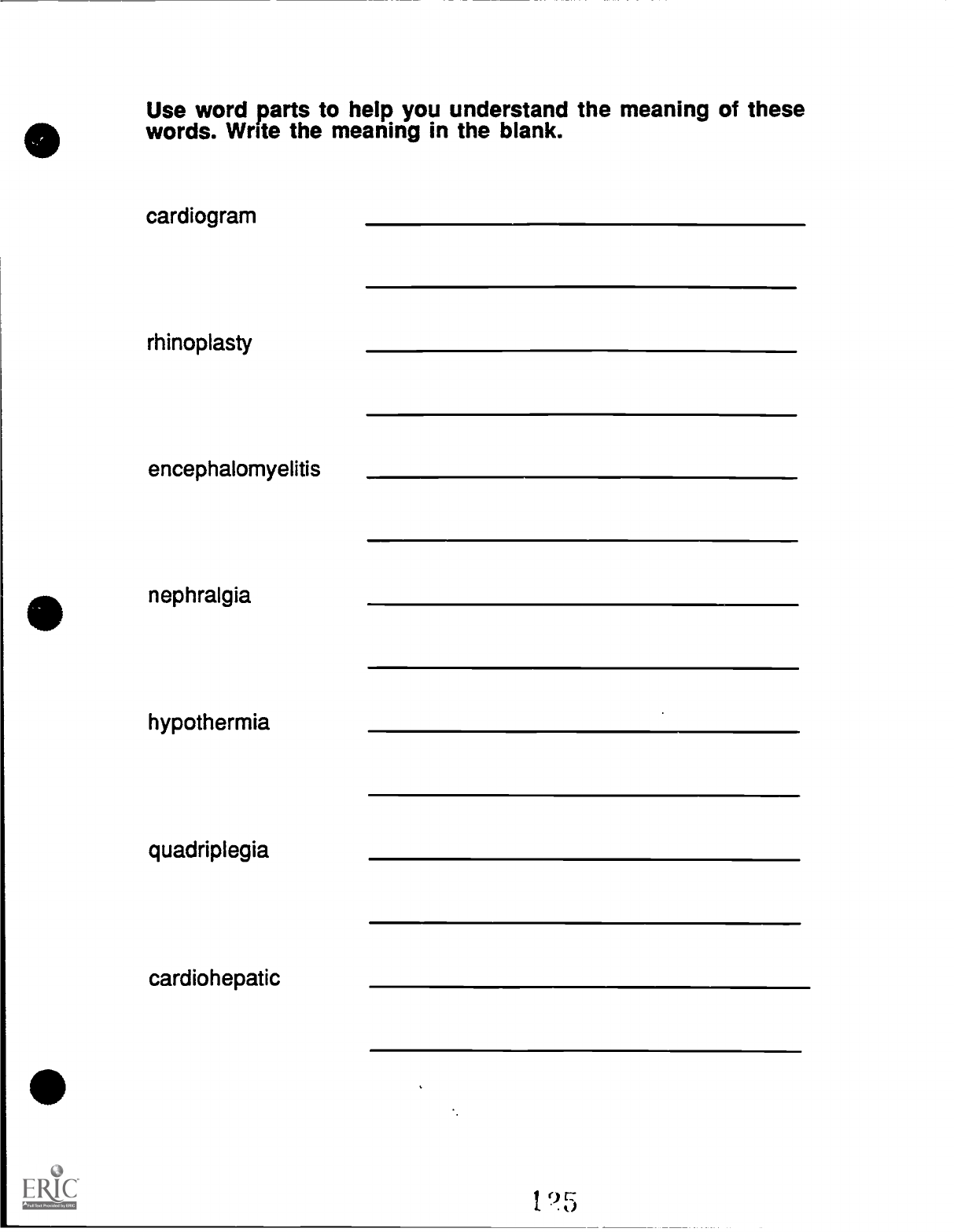
Use word parts to help you understand the meaning of these
words. Write the meaning in the blank.
cardiogram
rhinoplasty
encephalomyelitis
nephralgia
hypothermia
quadriplegia
cardiohepatic

Mate' the word parts to their
meanings (not all meanings
will be used):
vertebr/o
A. skull
pseud/o
B. bile
crani/o
C. feeling, sensation
esthesia
D. backbone
schlerosis
E. slow
pulmon/o
F. false
G. hardening
H. lung
12C

41)
Answer the following questions:
The doctor prescribed an analgesic. What will that do?
The woman had edema. What does that mean?
The test showed that he had hyperthyroidism. Did his thyroid
4110
produce too much or too little?
After exercising, he suffered from back spasms. What was
happening to his back?
1 (.1"1
. 4
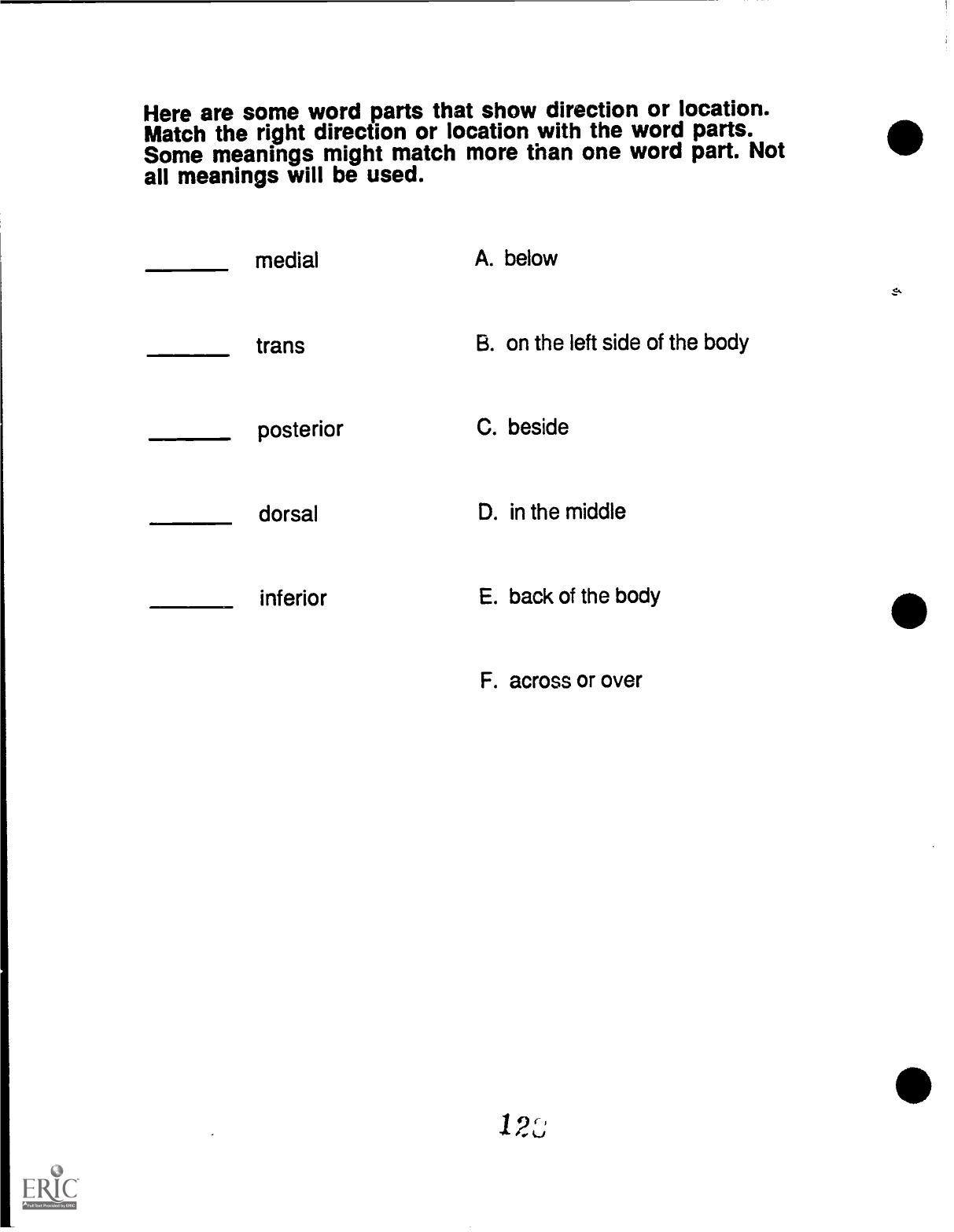
Here are some word parts that show direction or
location.
Match the right direction or location with the word parts.
Some meanings might match more than one word part.
Not
all meanings will be used.
medial
A. below
trans
B. on the left side of the body
posterior
C. beside
dorsal
D. in the middle
inferior
E. back of the body
F. across or over
;--
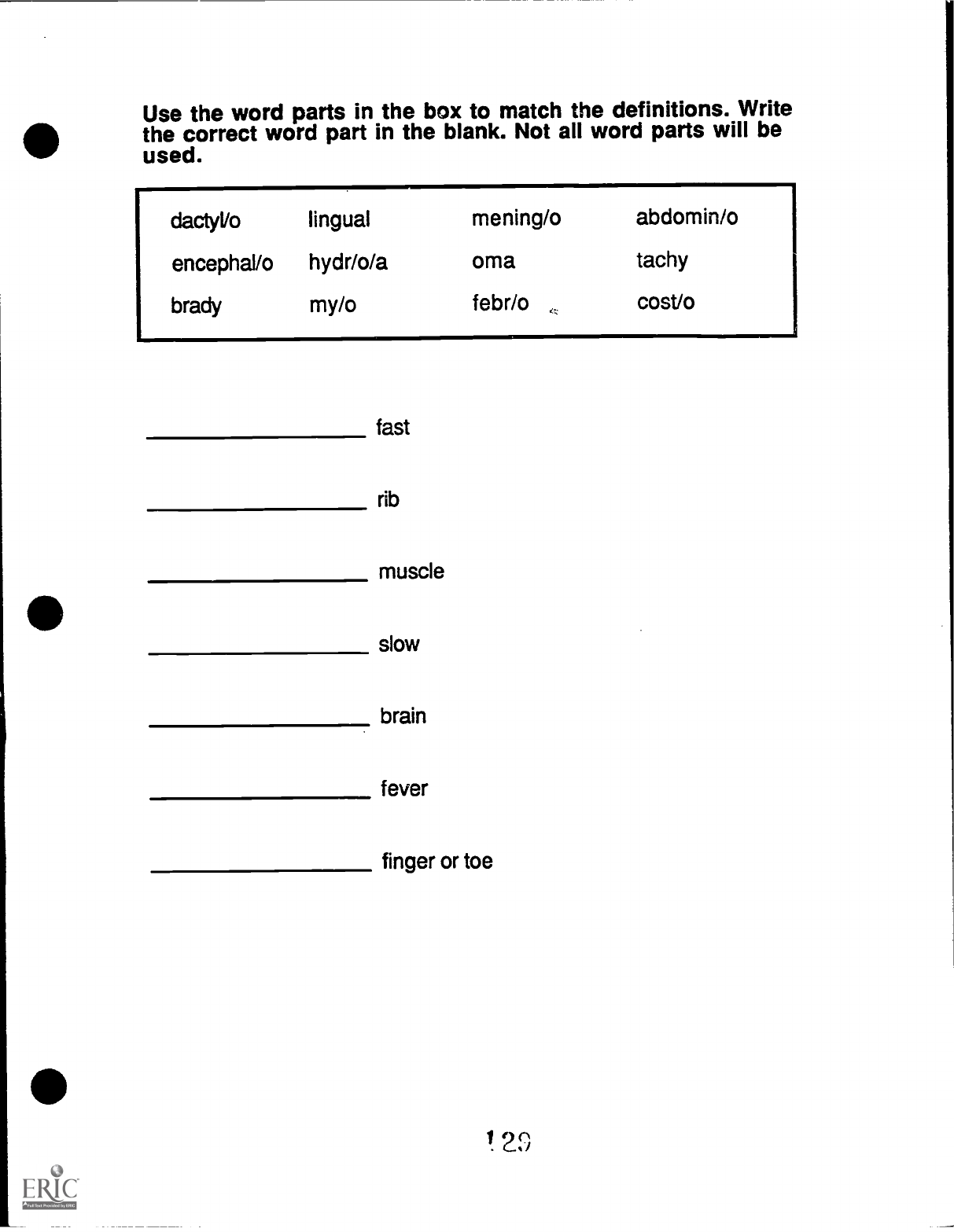
Use the word parts in the box to match the
definitions. Write
the correct word part in the blank. Not all word parts
will be
used.
dactyVo
lingual
mening/o
abdomin/o
encephal/o
hydr/o/a
oma
tachy
brady
my/o
febr/o
cost/o
fast
rib
muscle
slow
brain
fever
finger or toe
n
